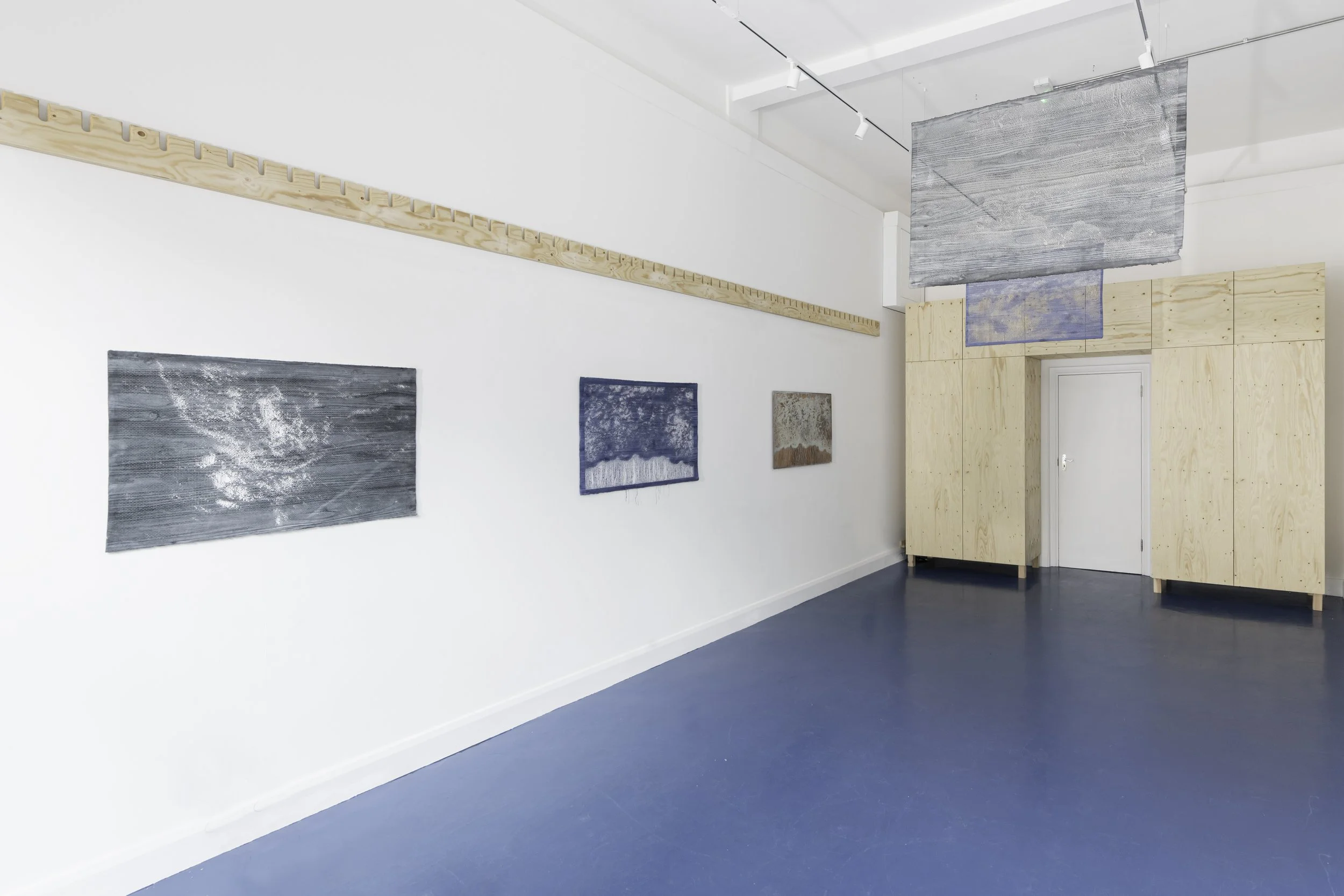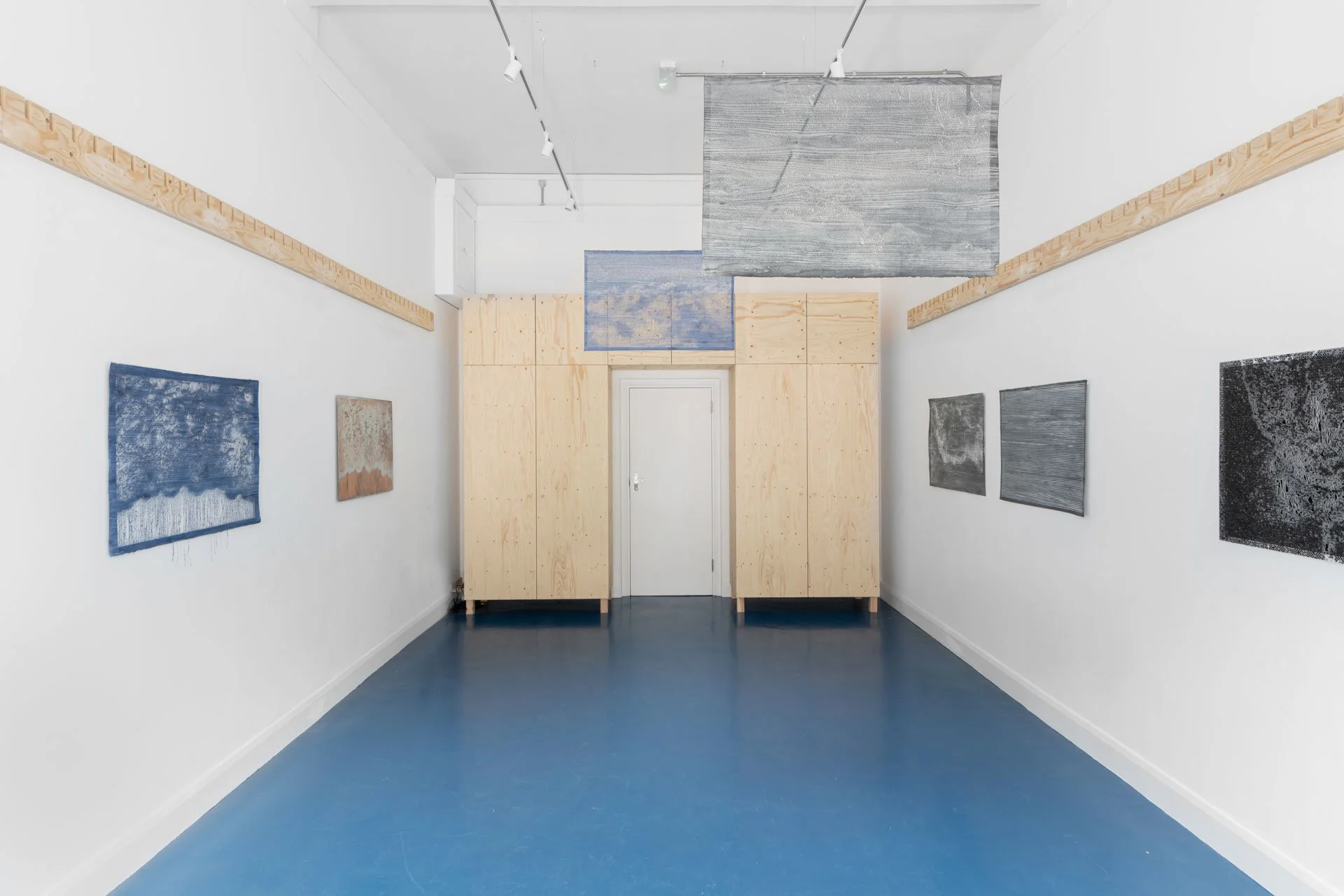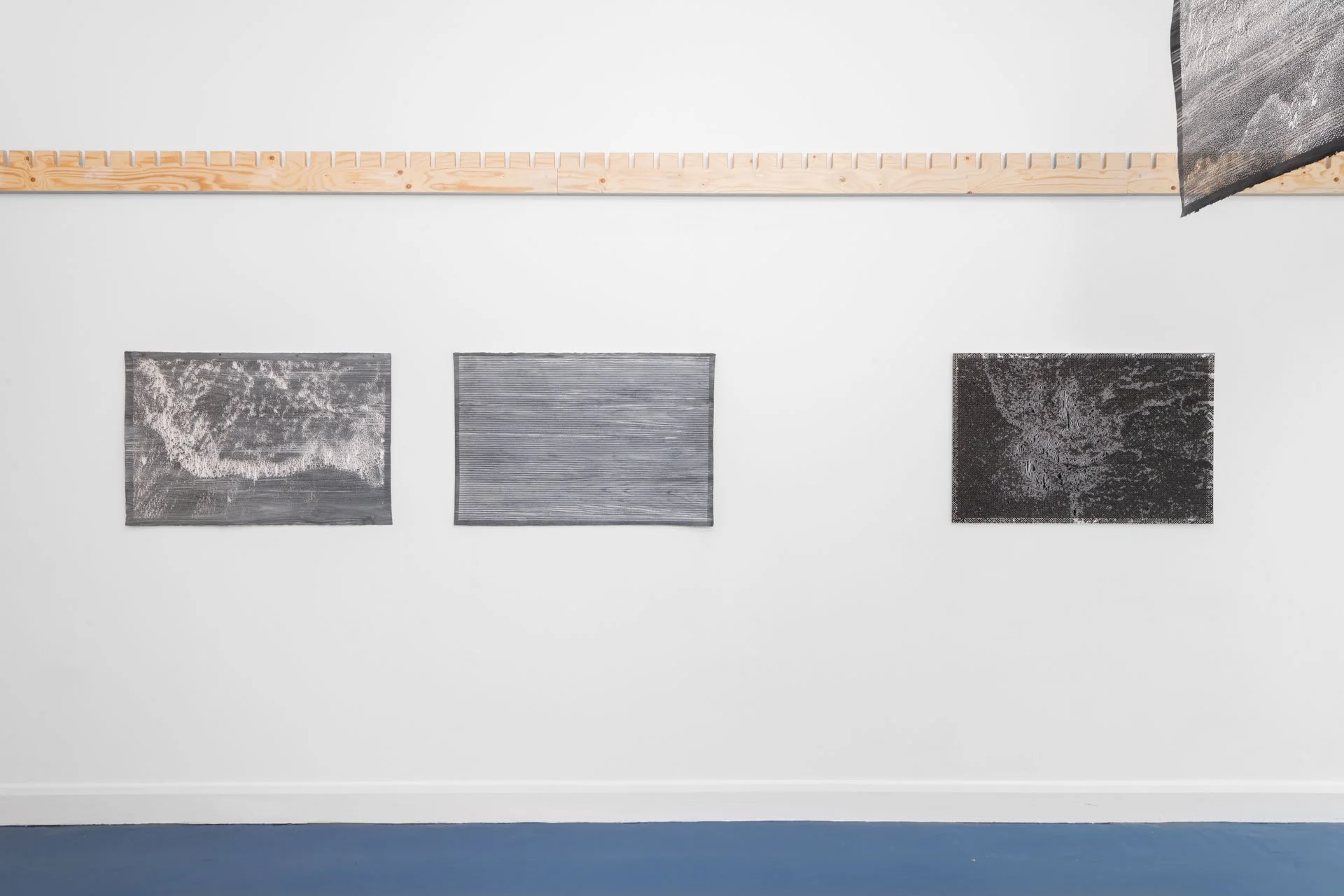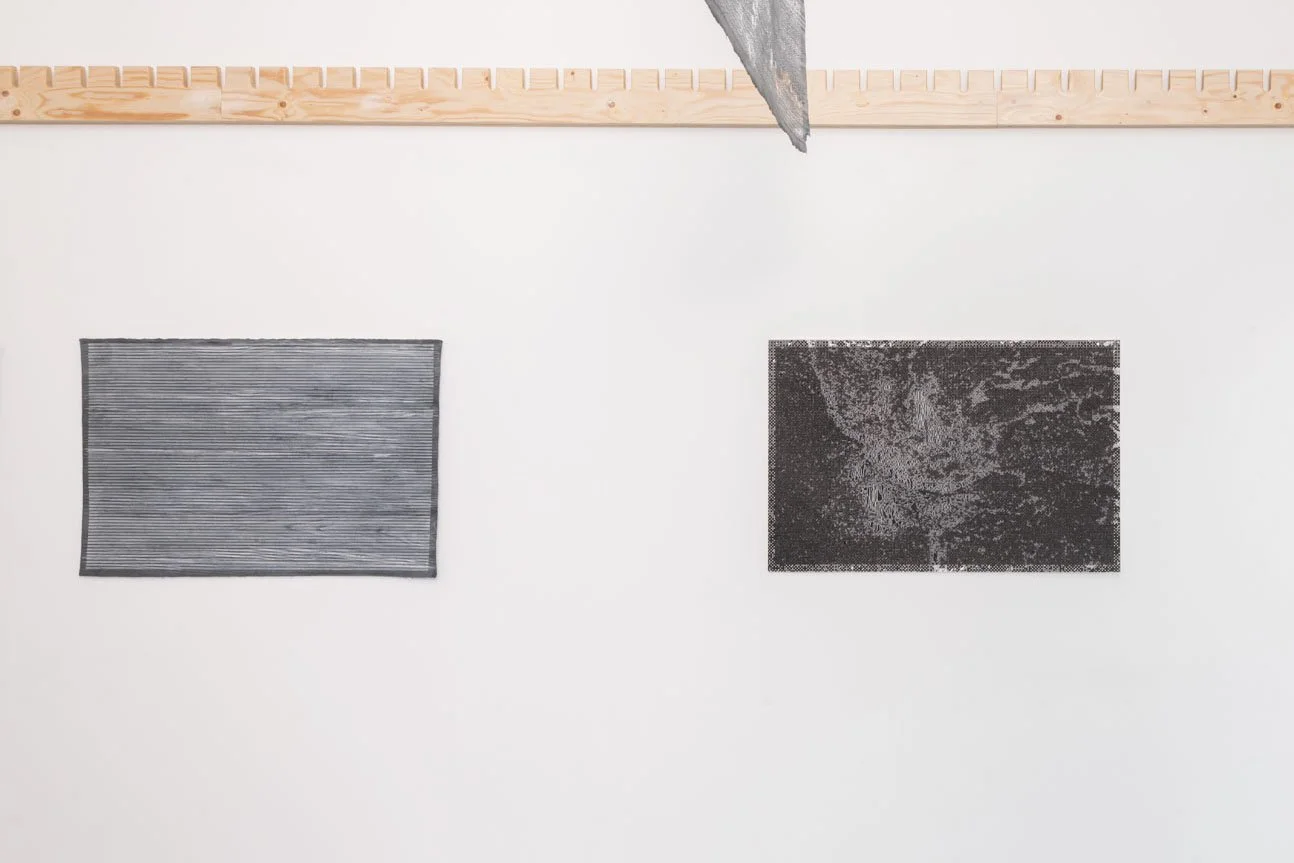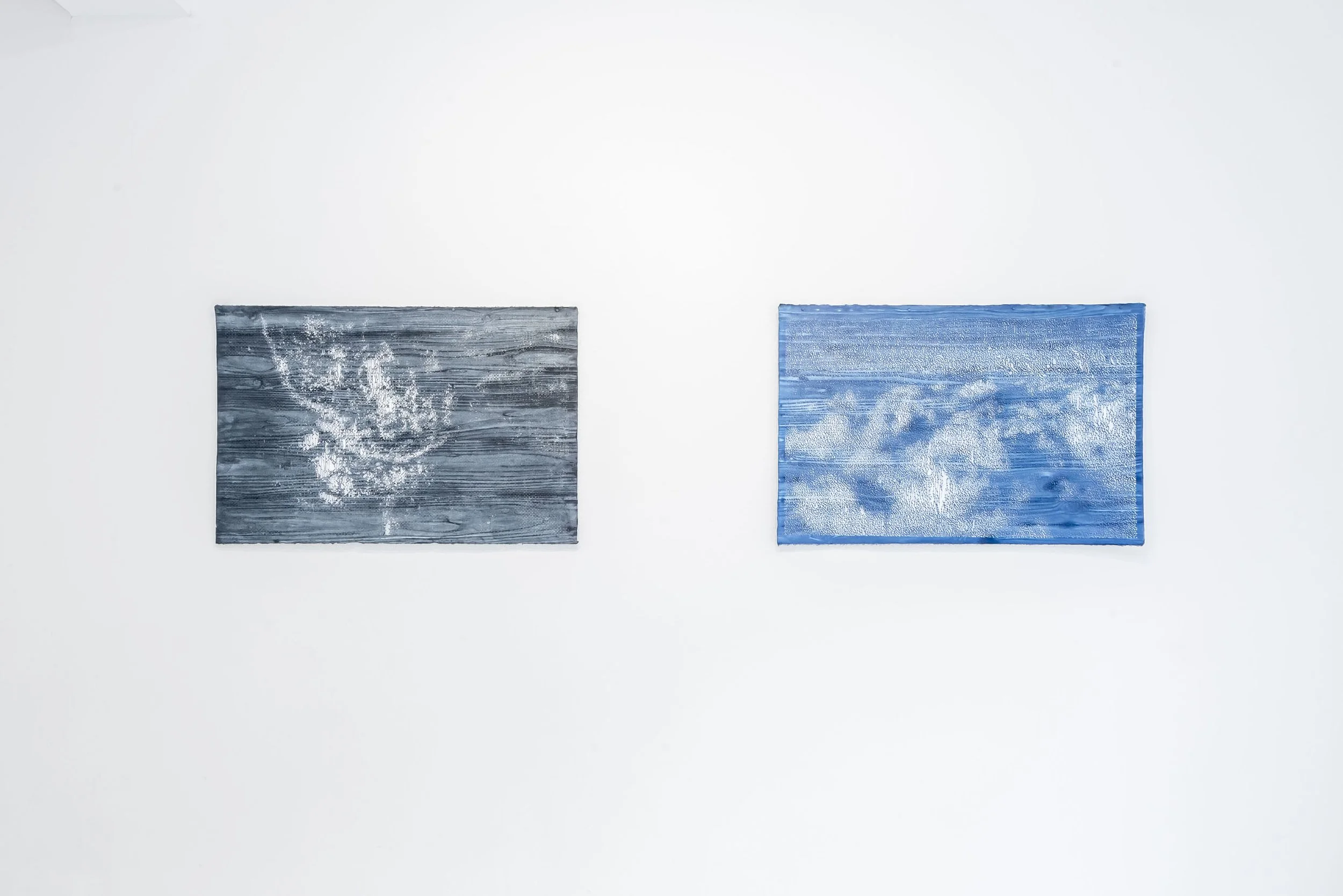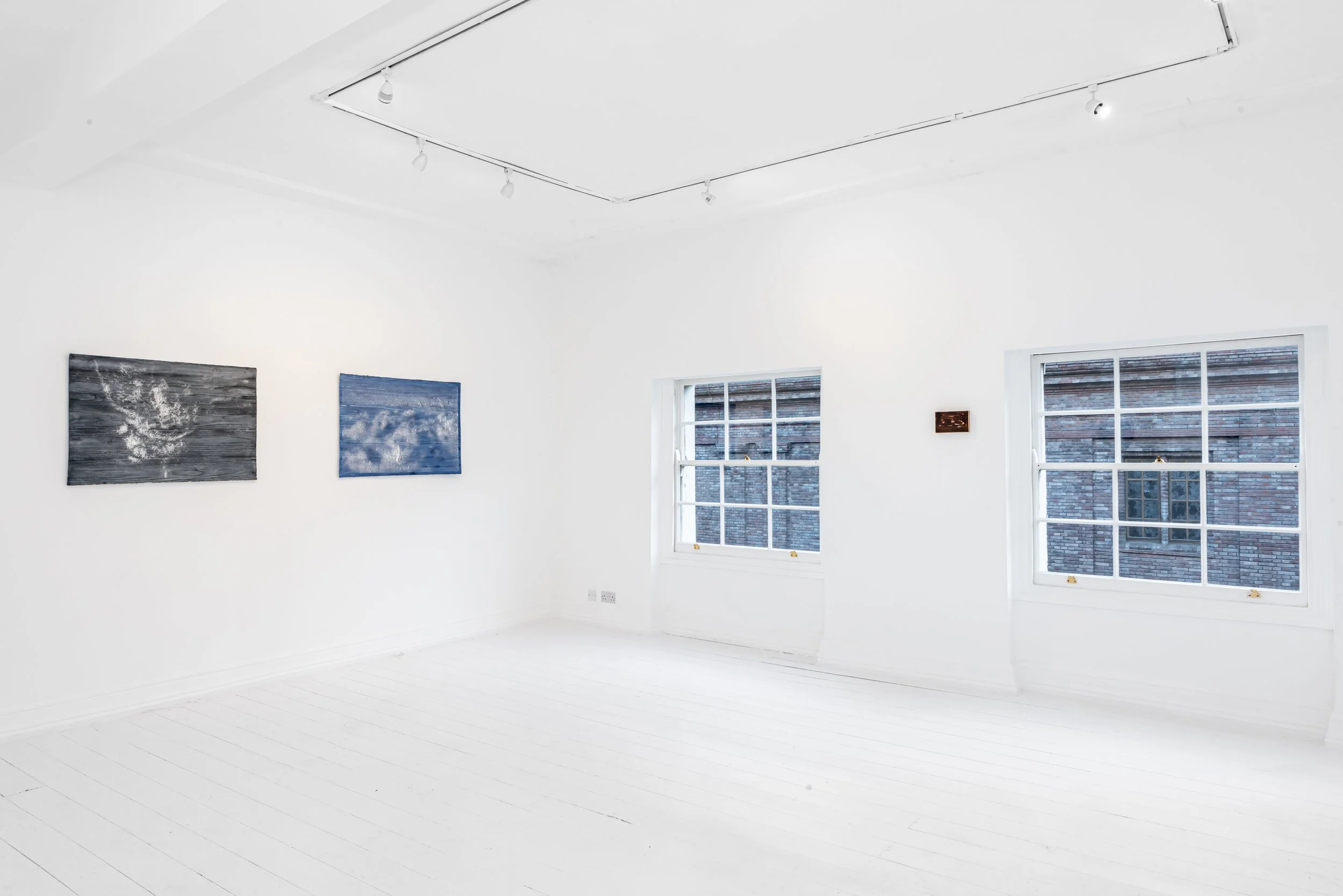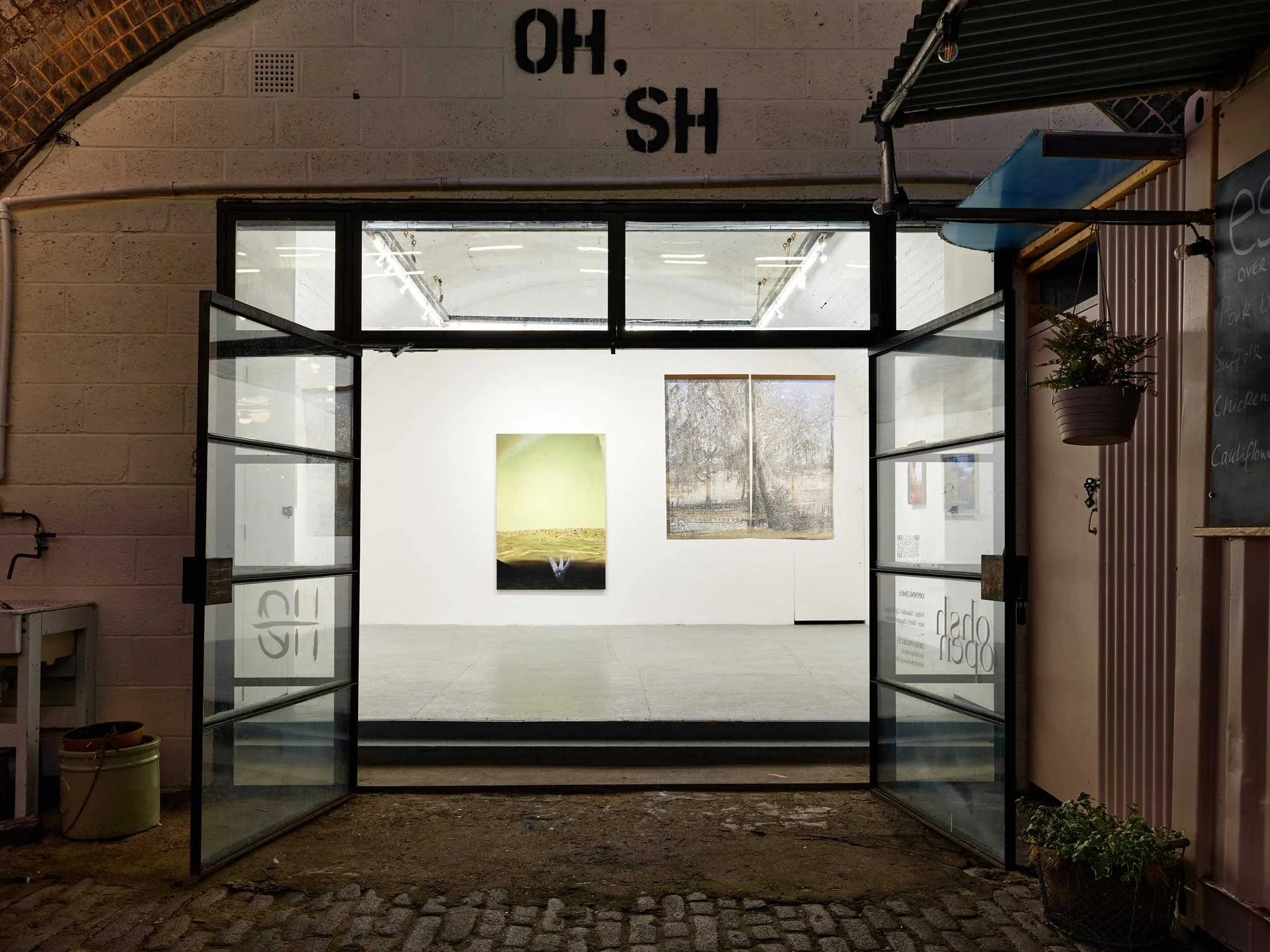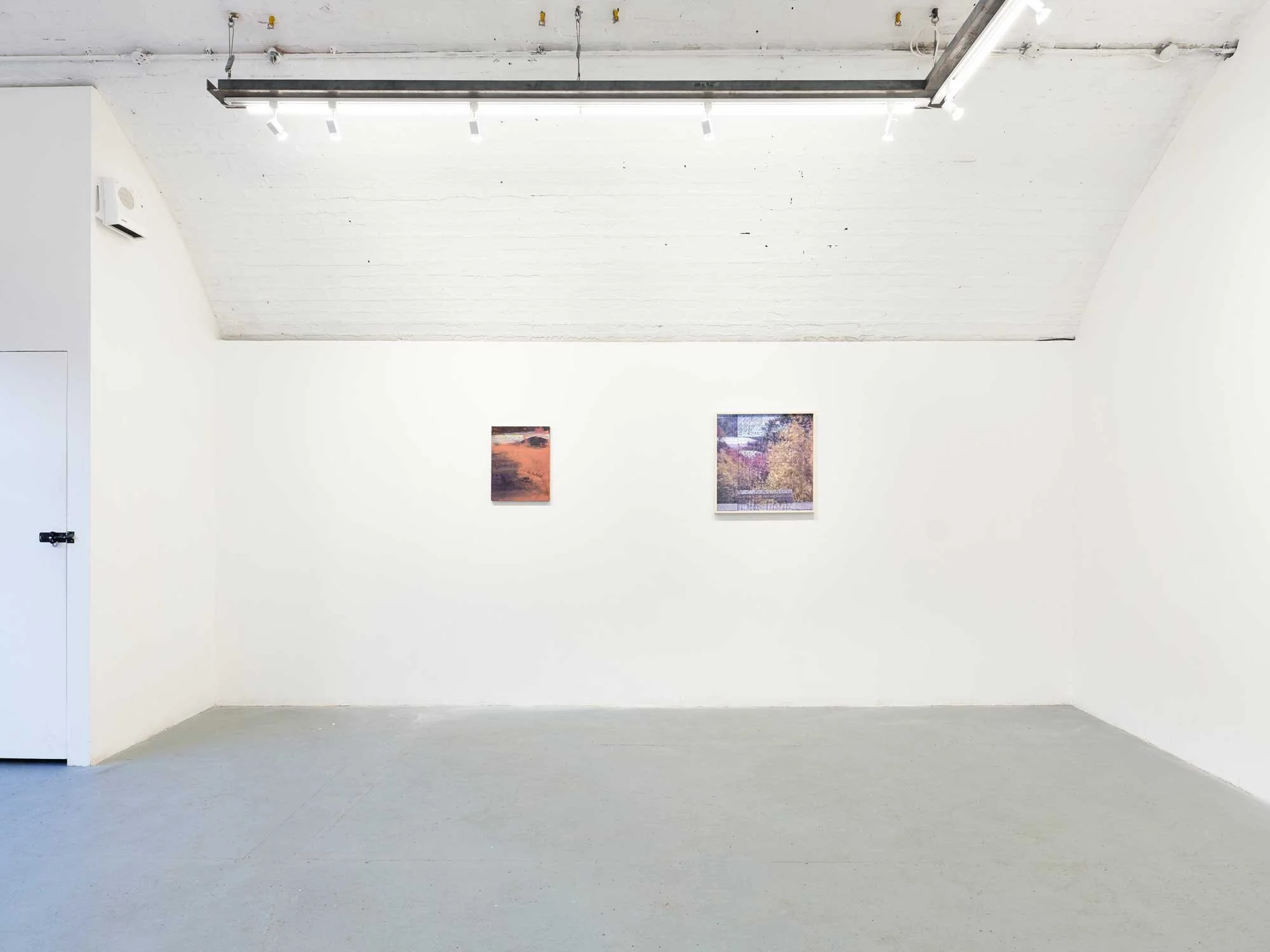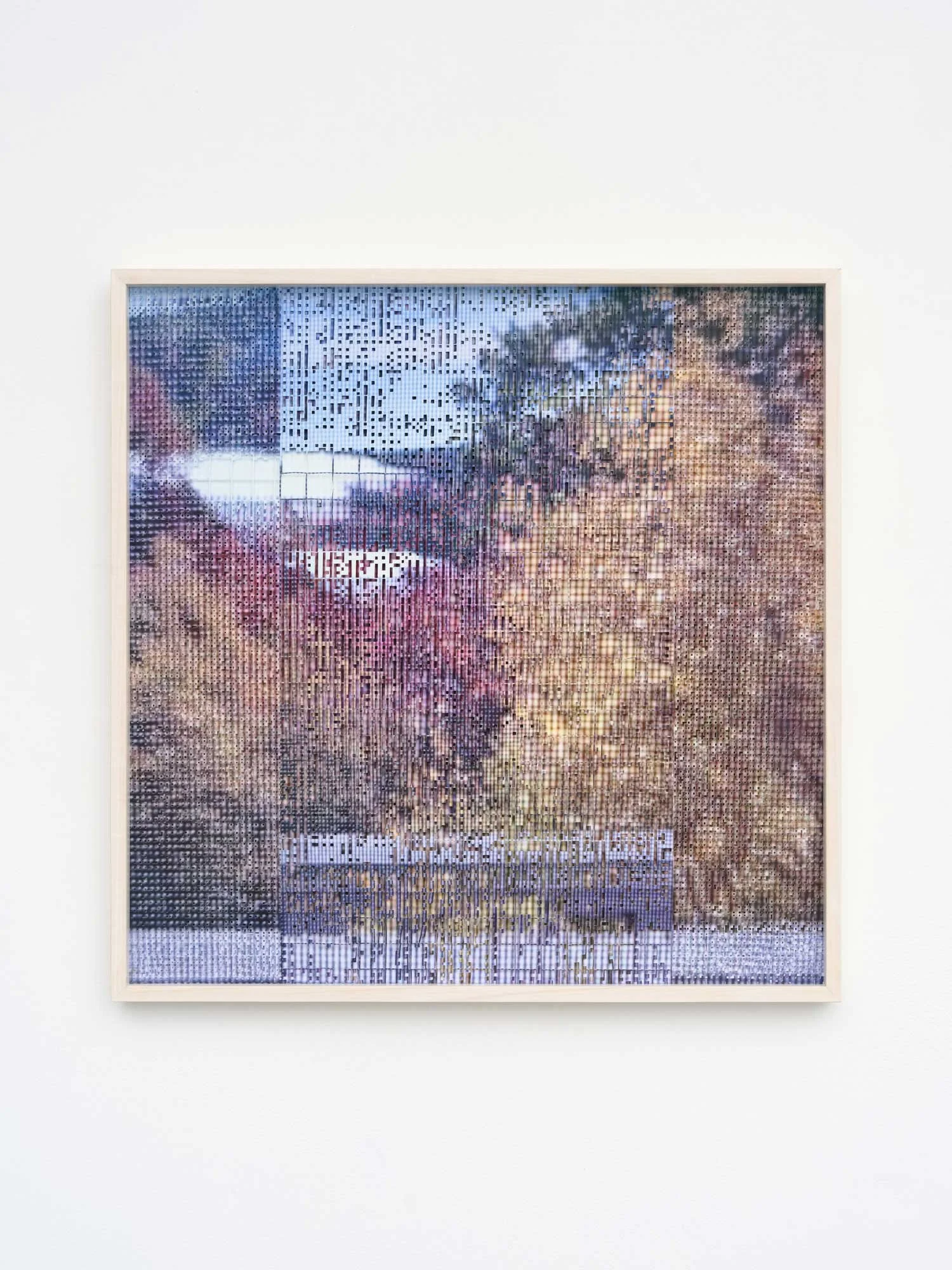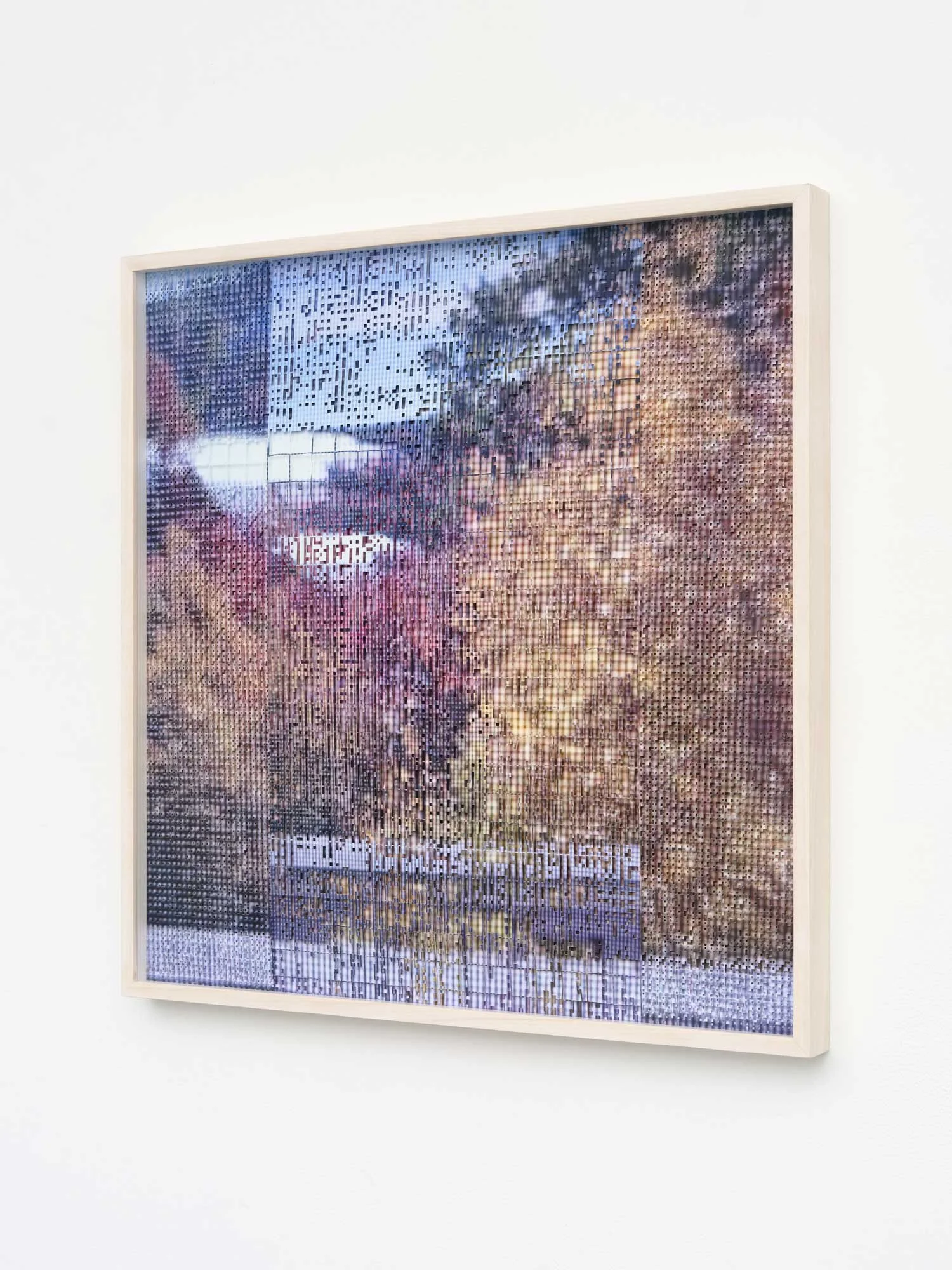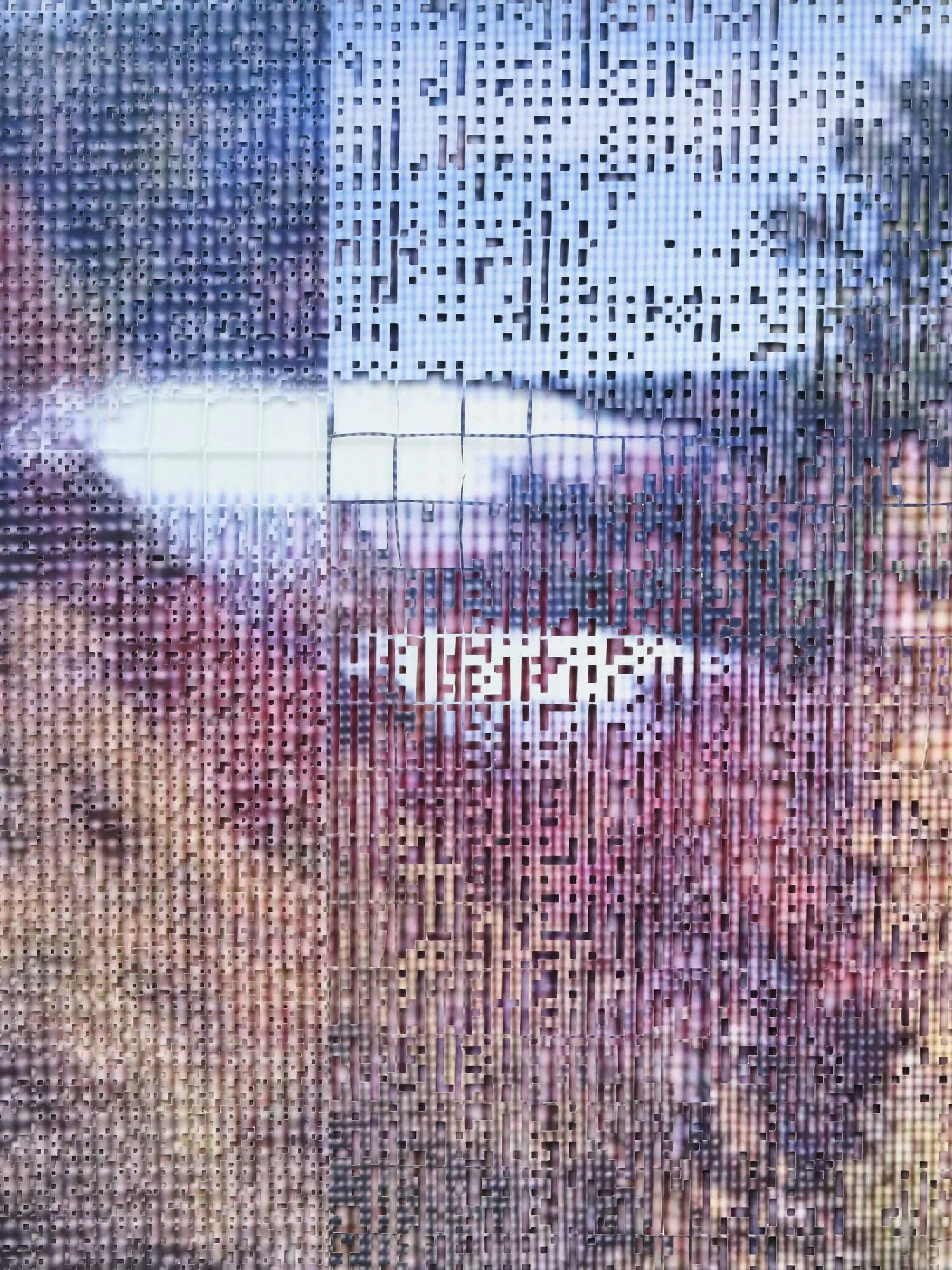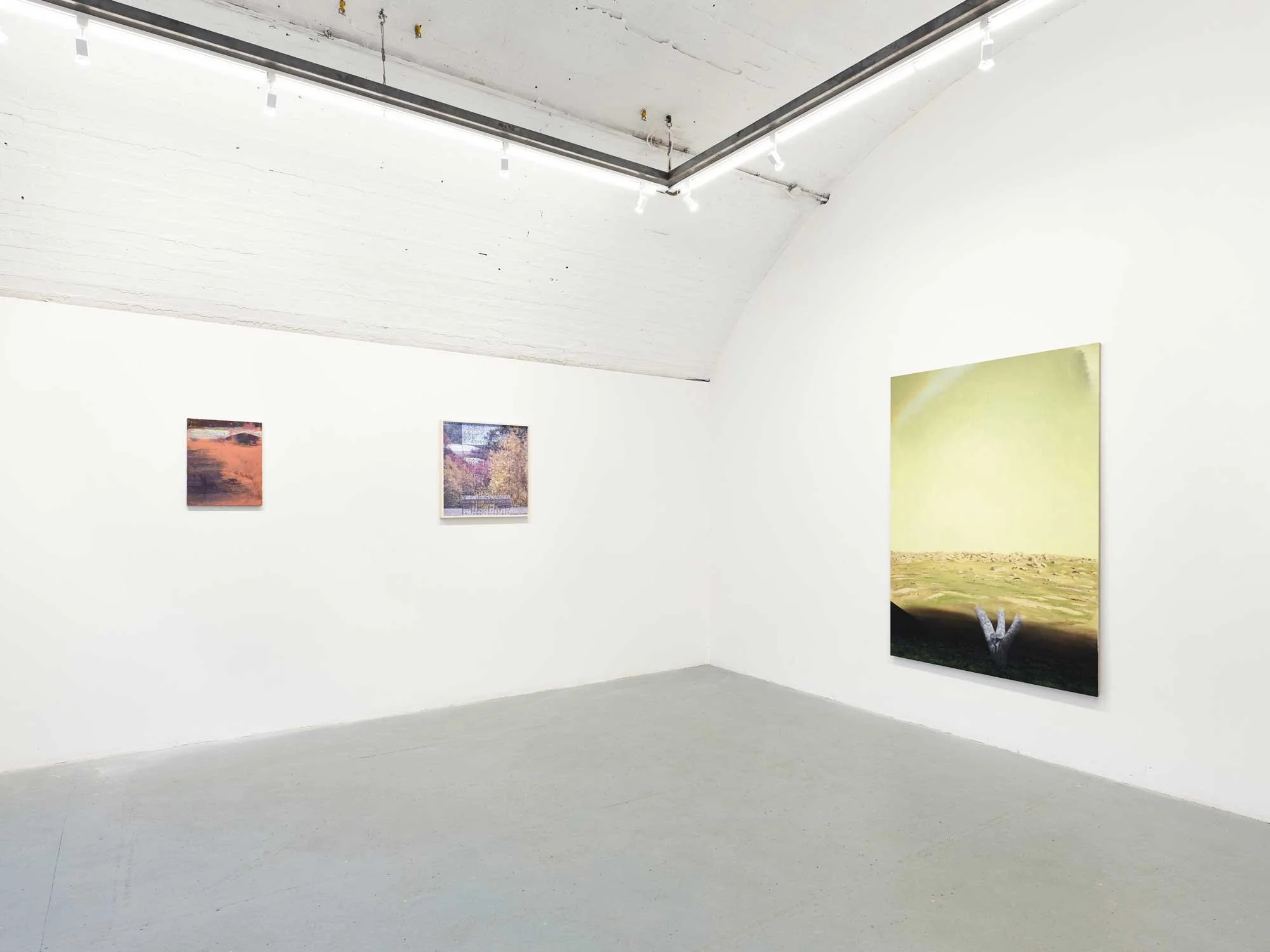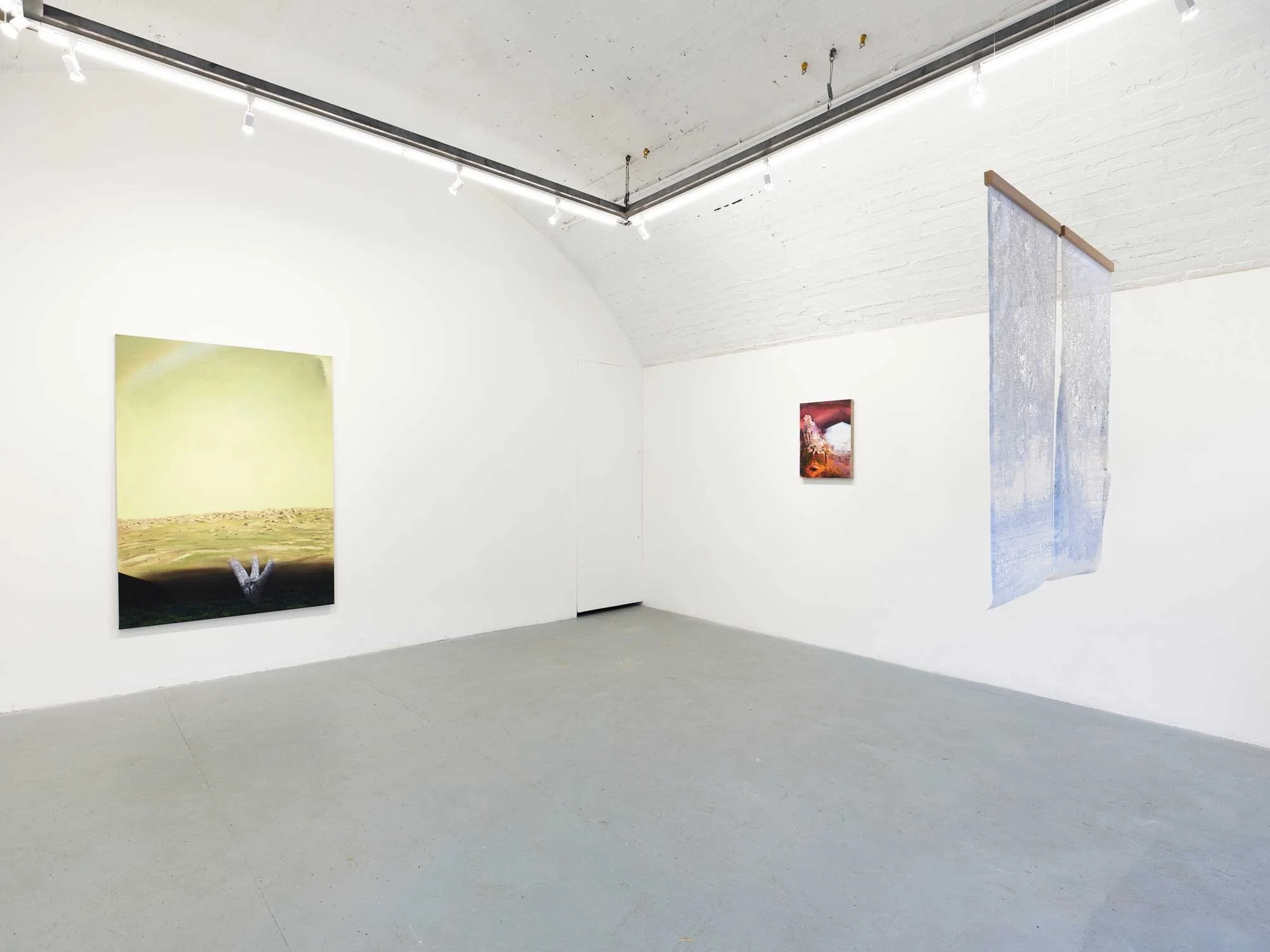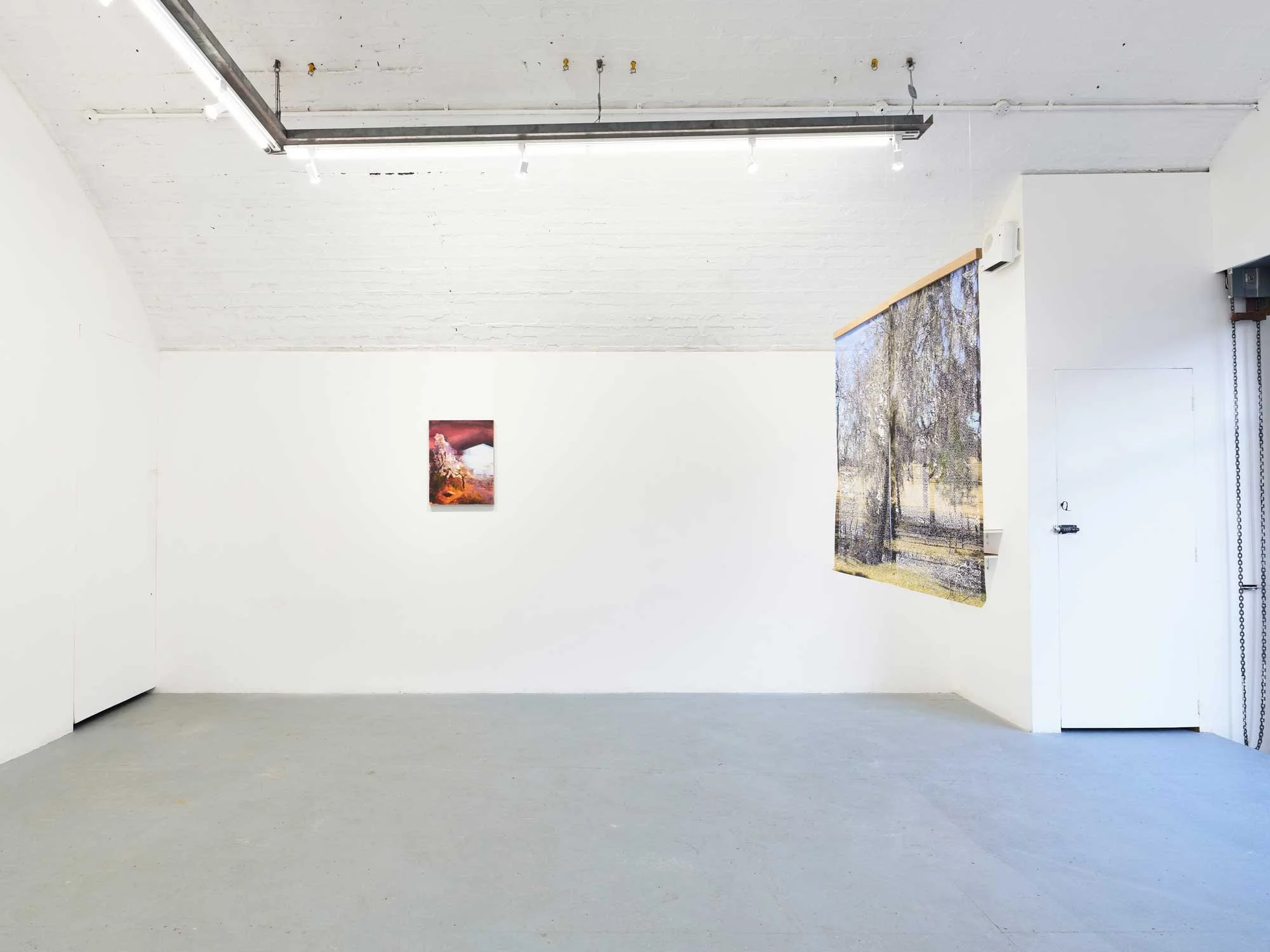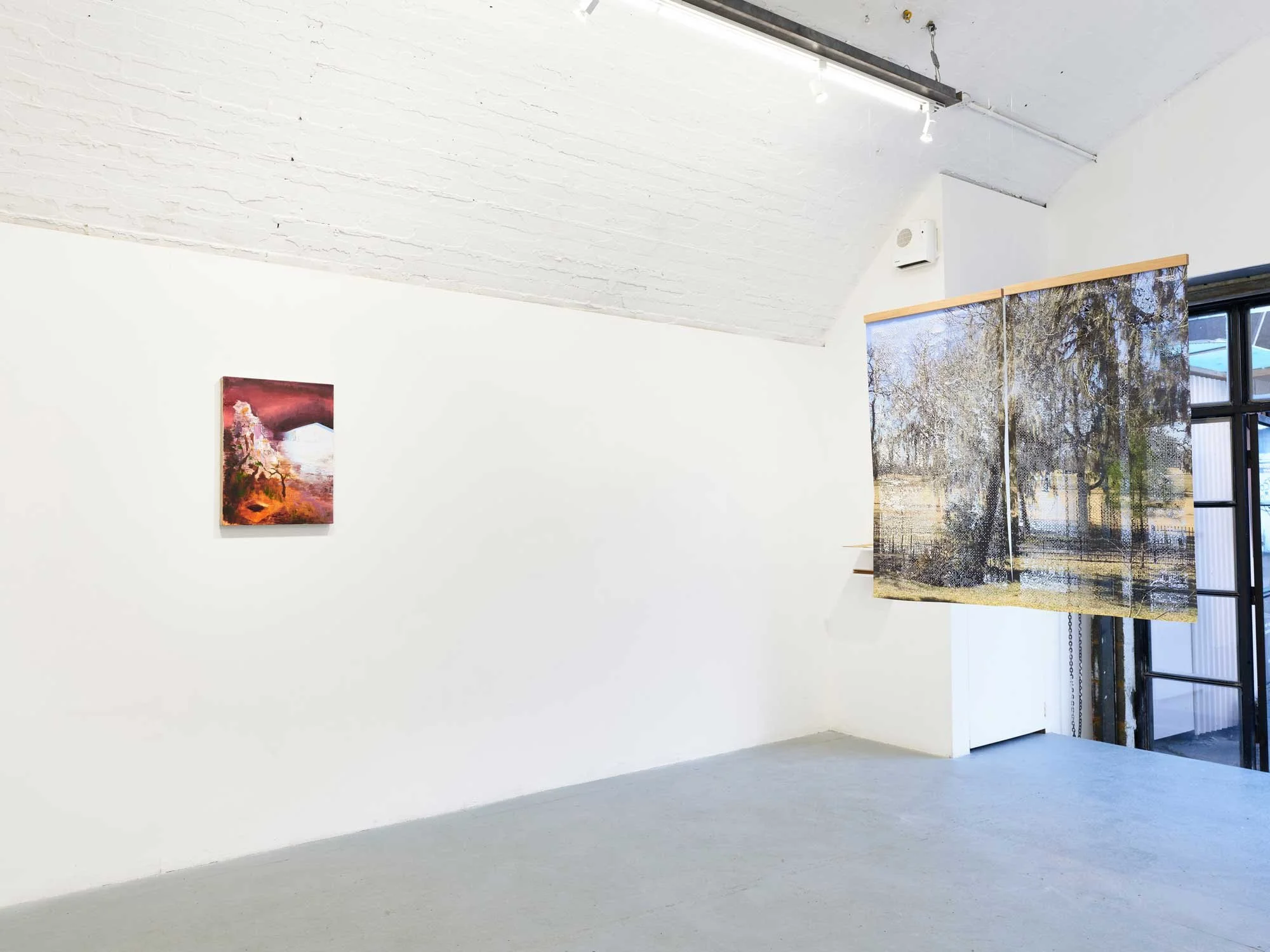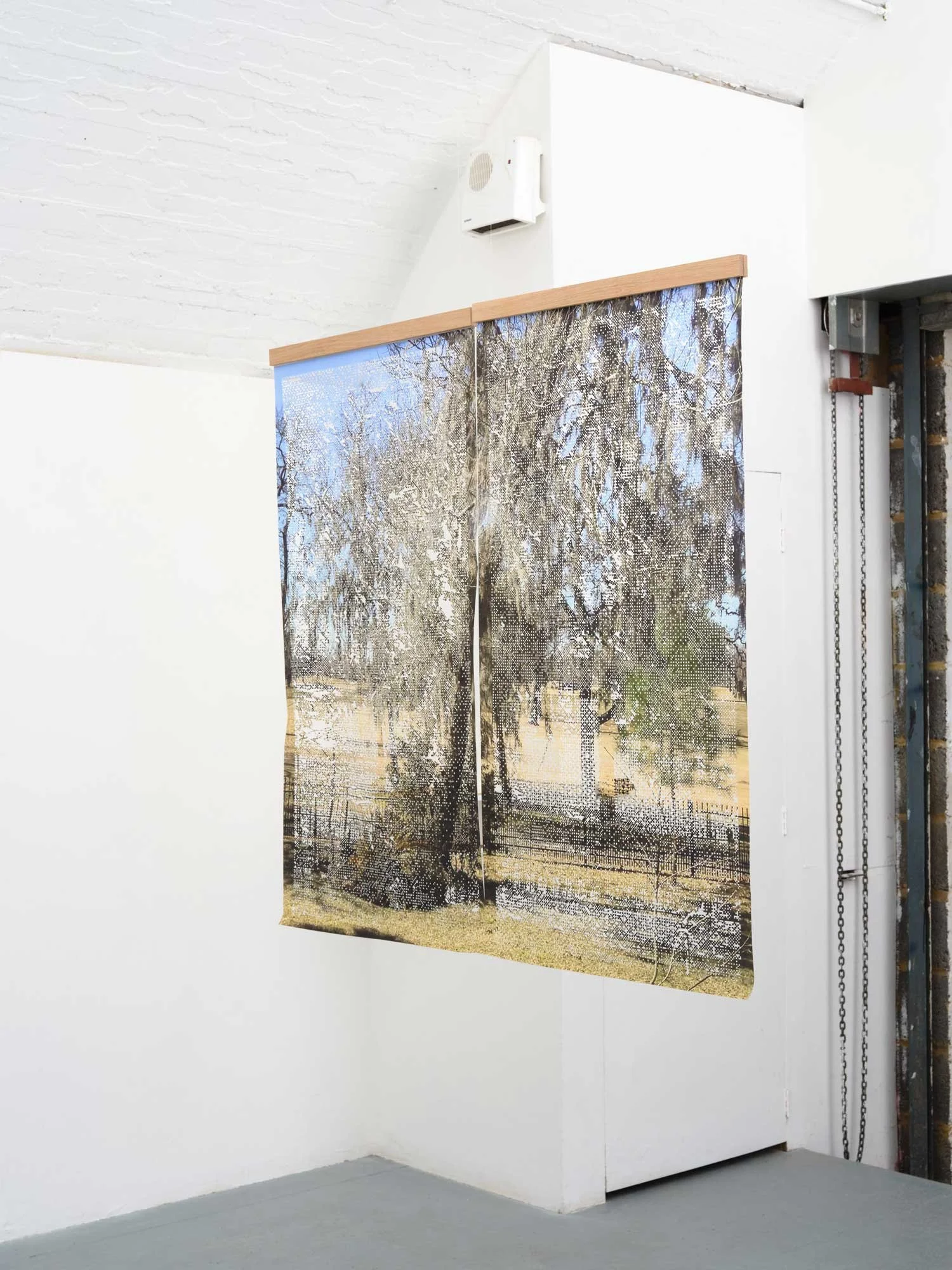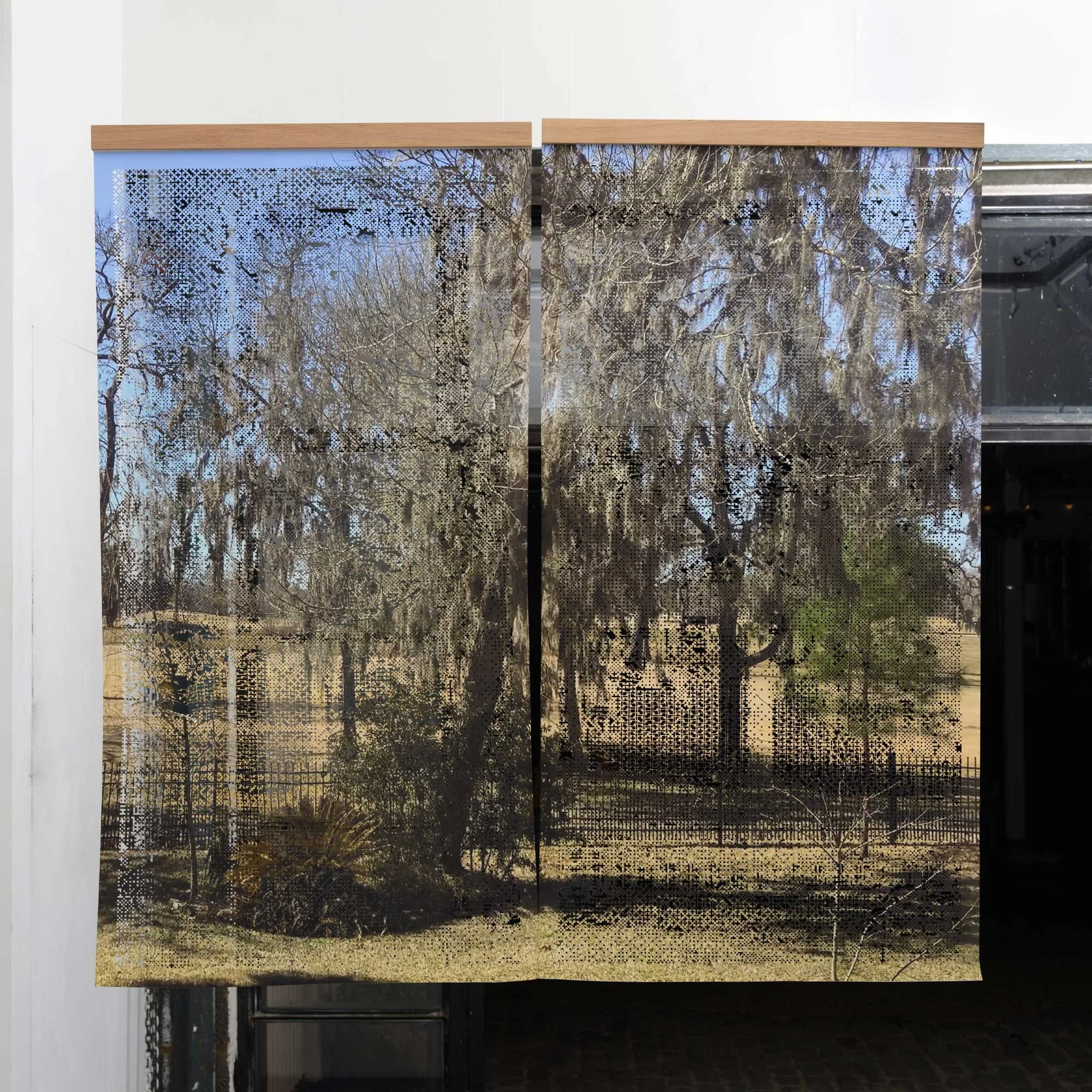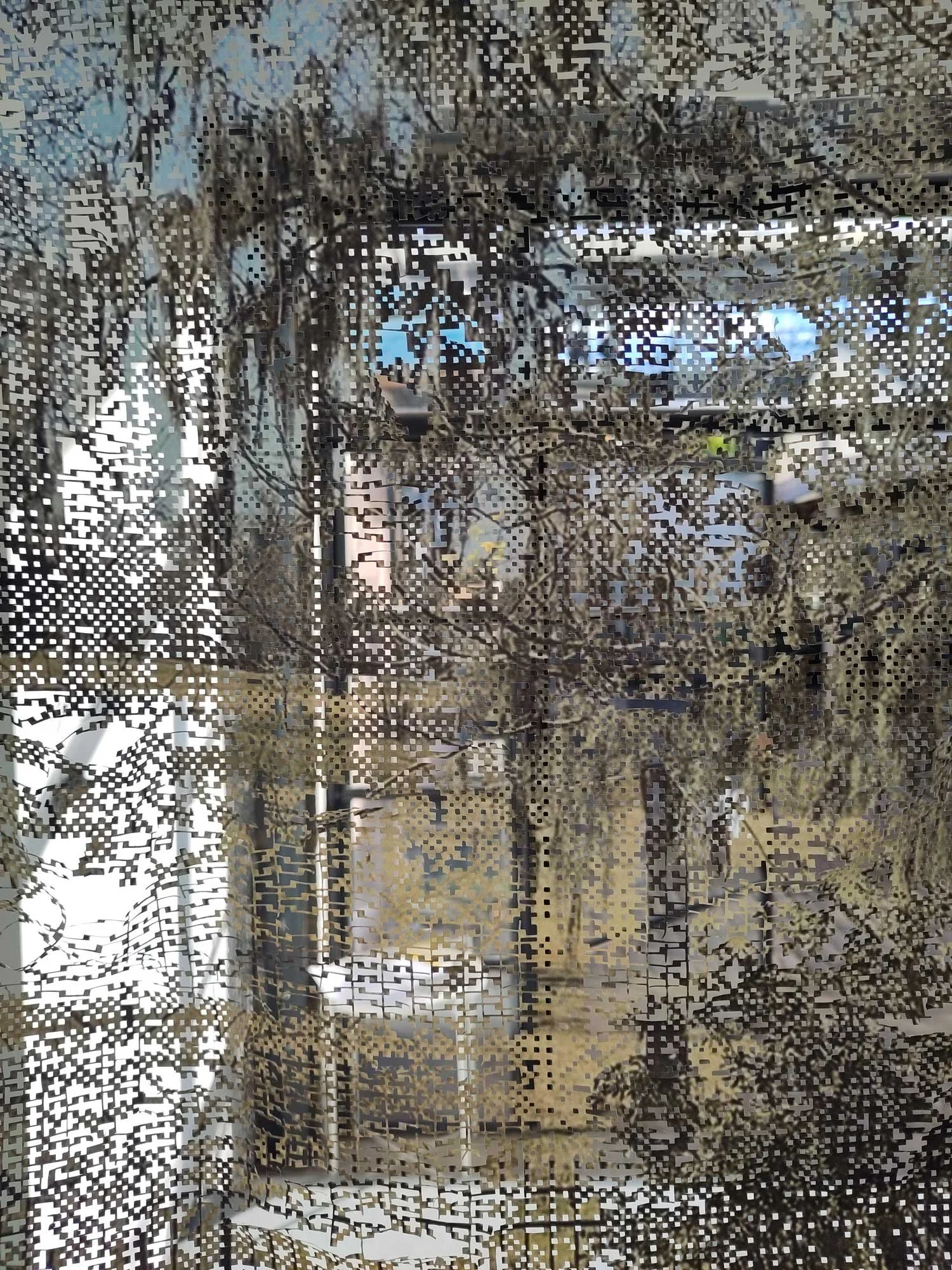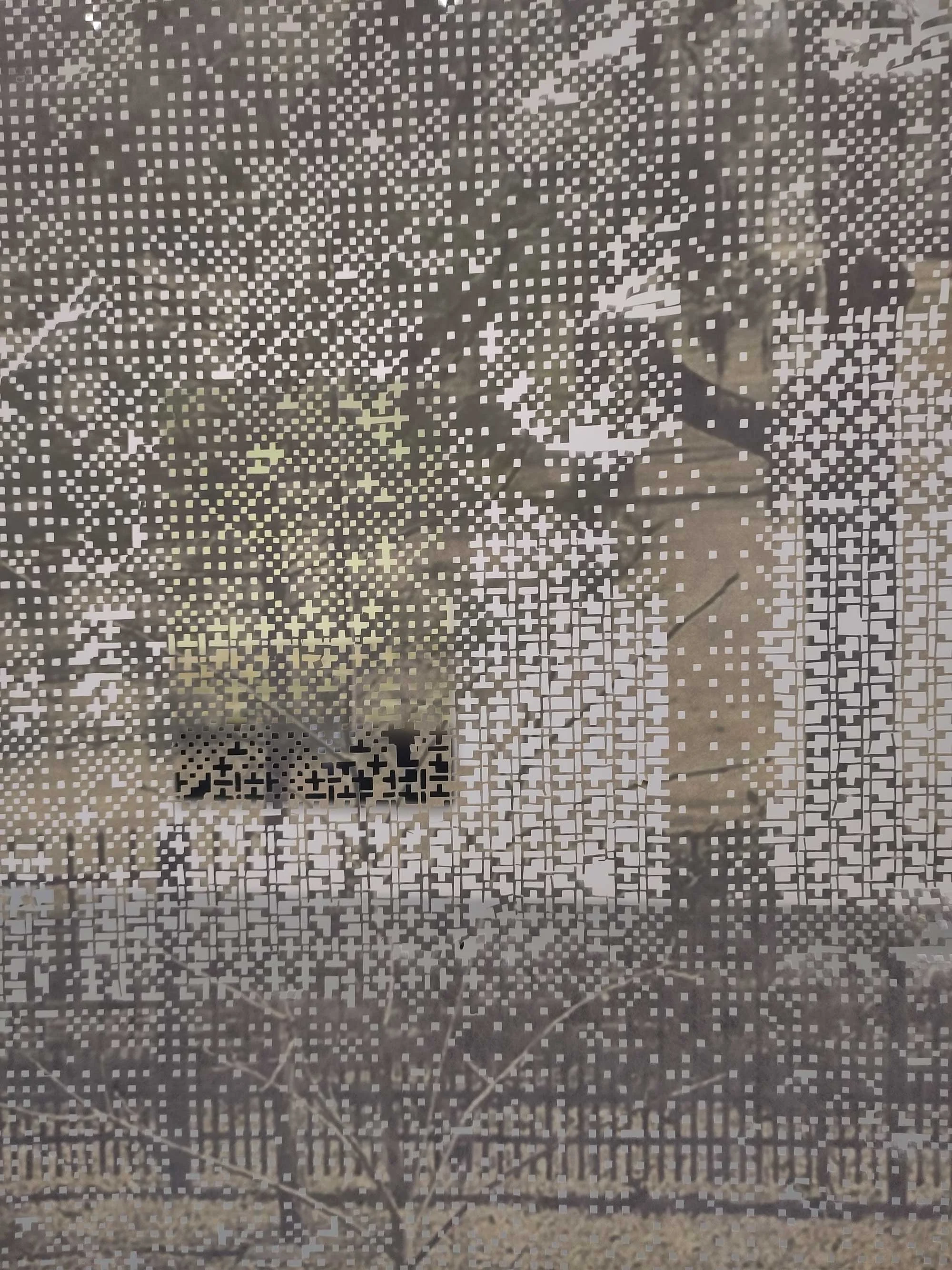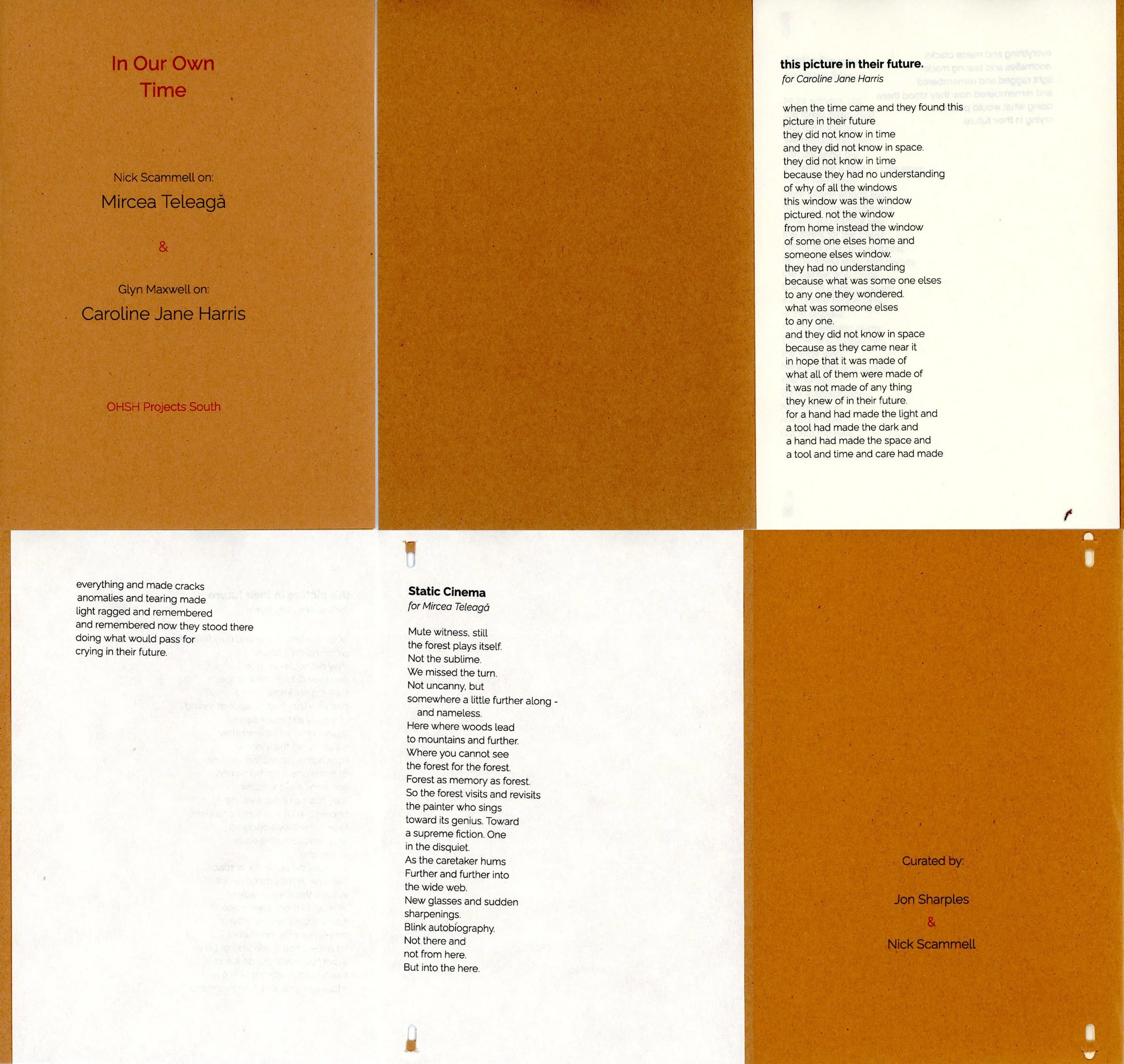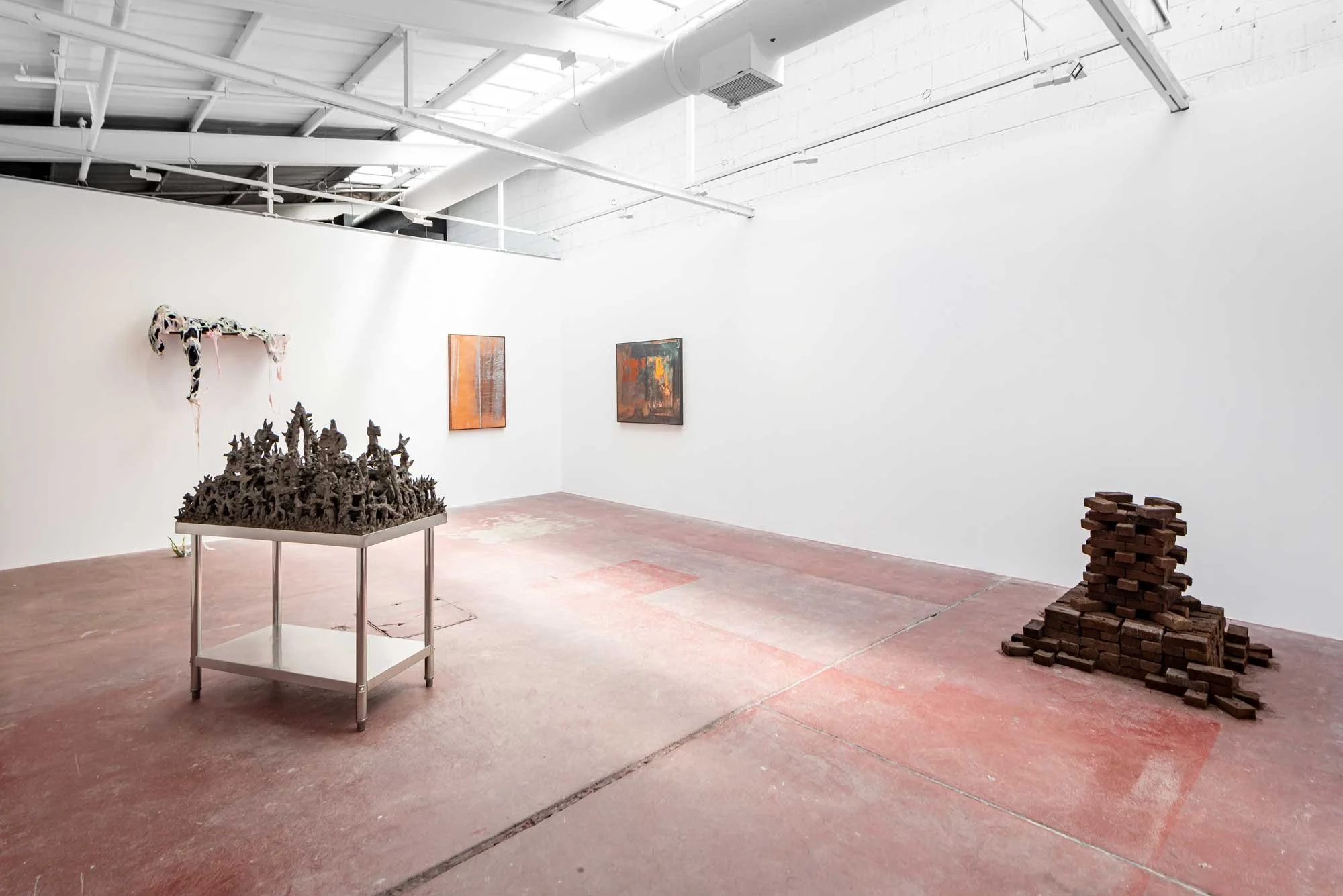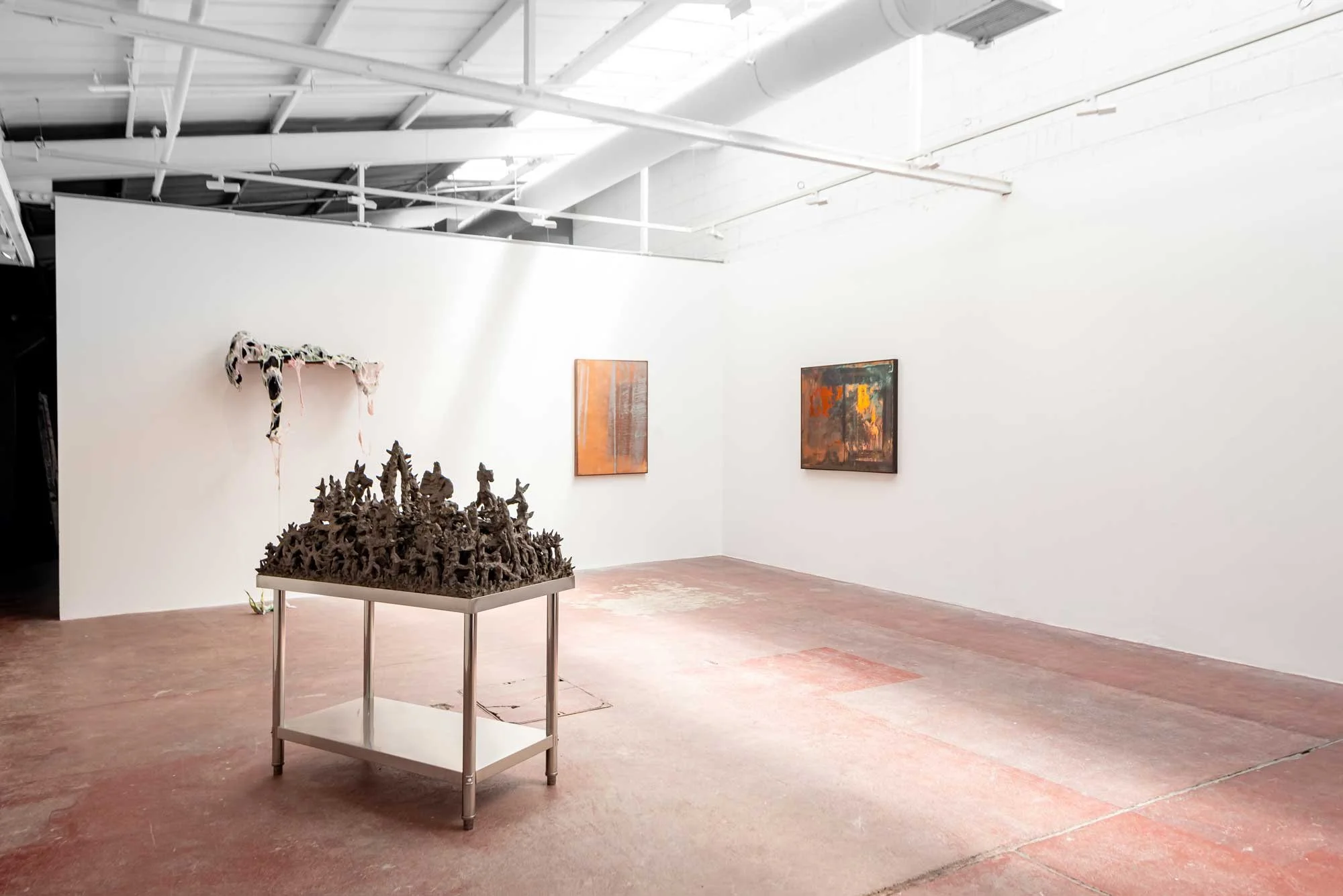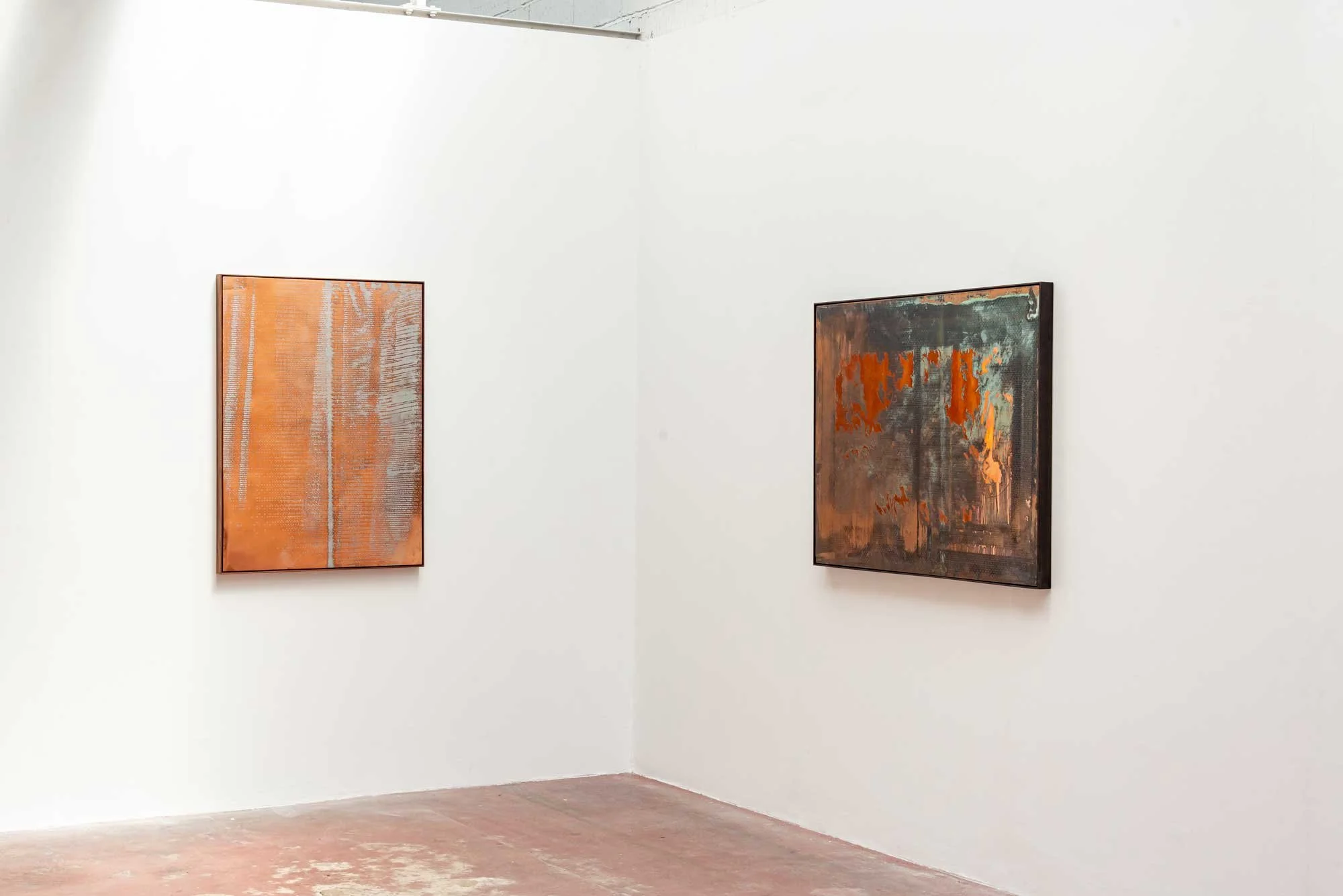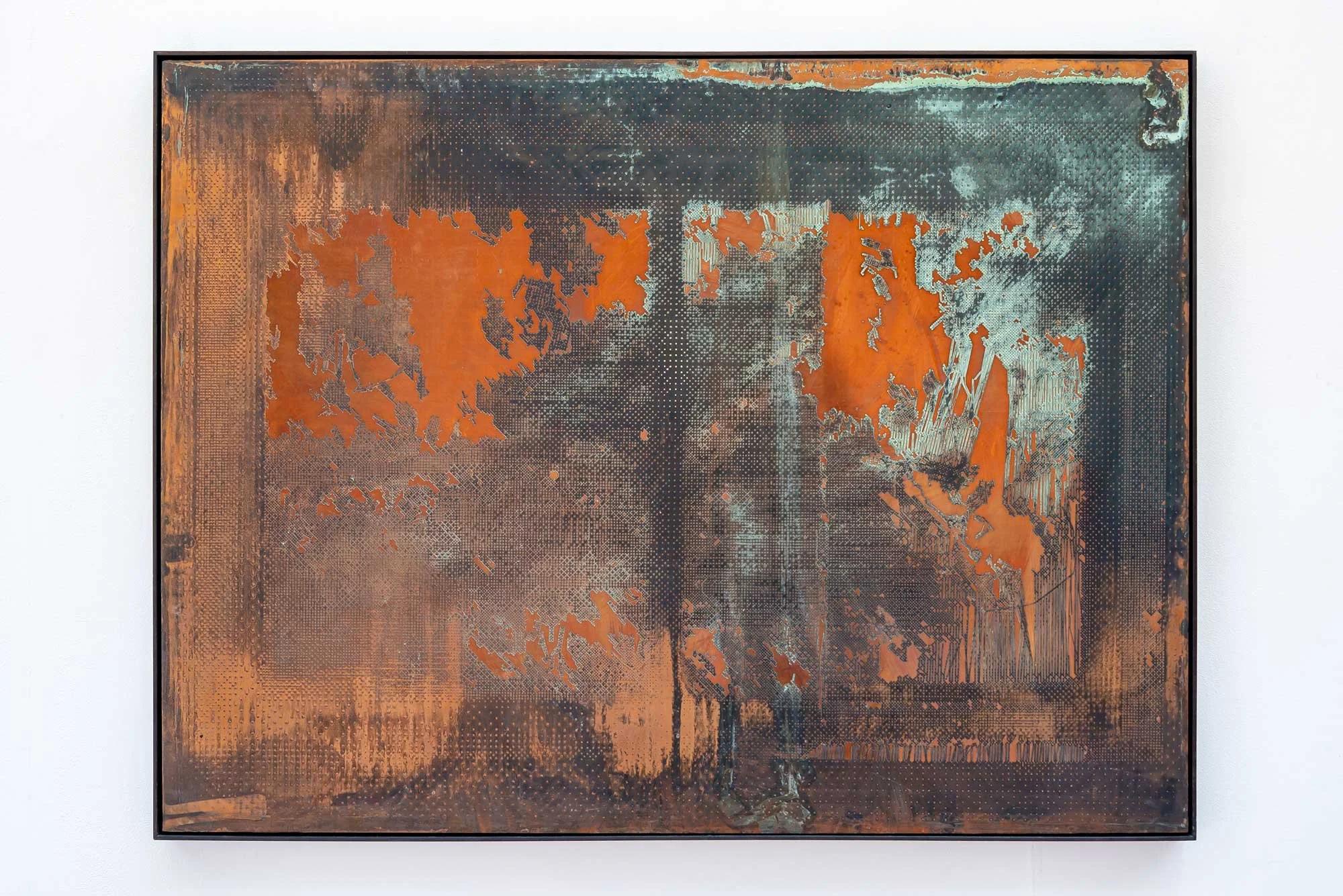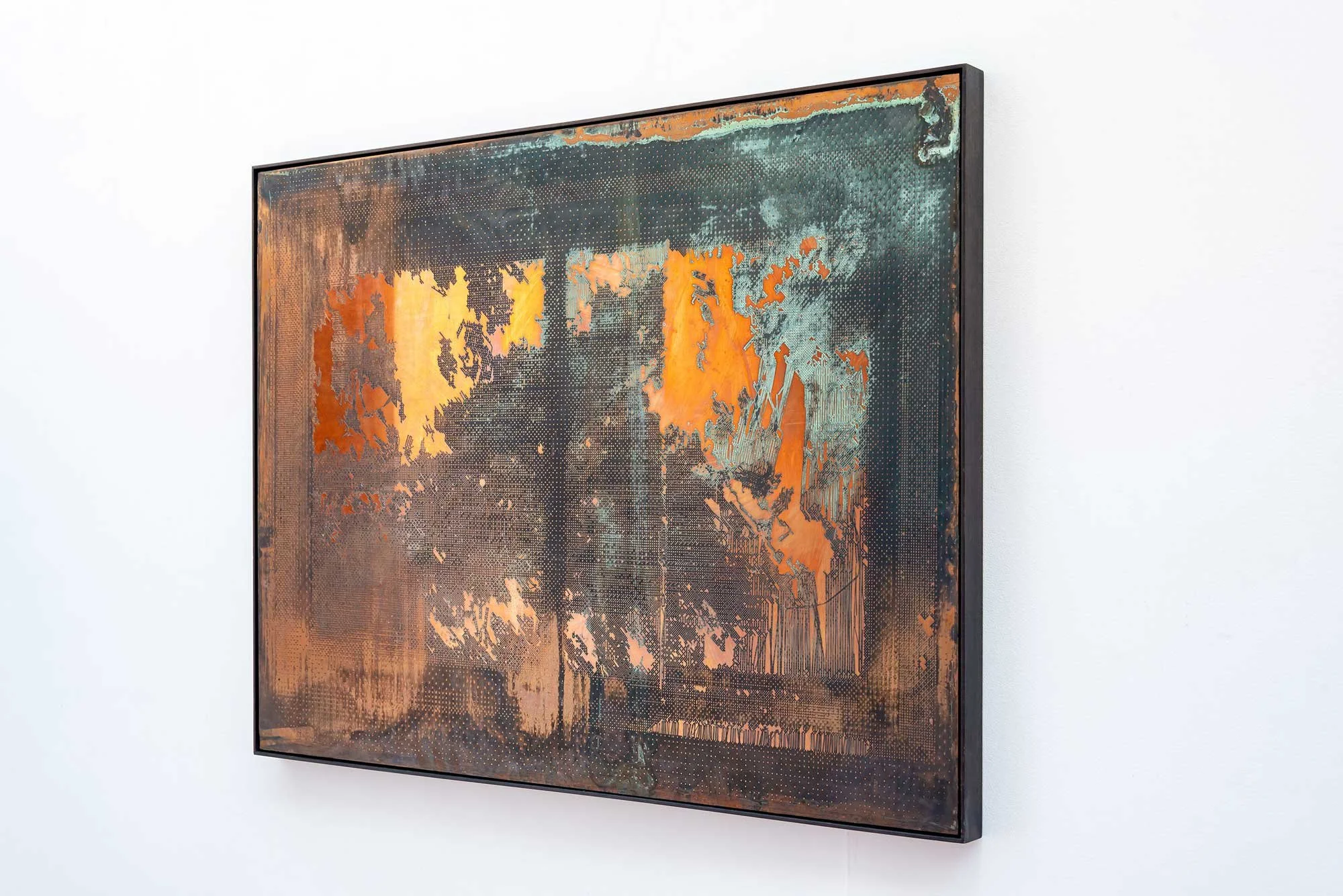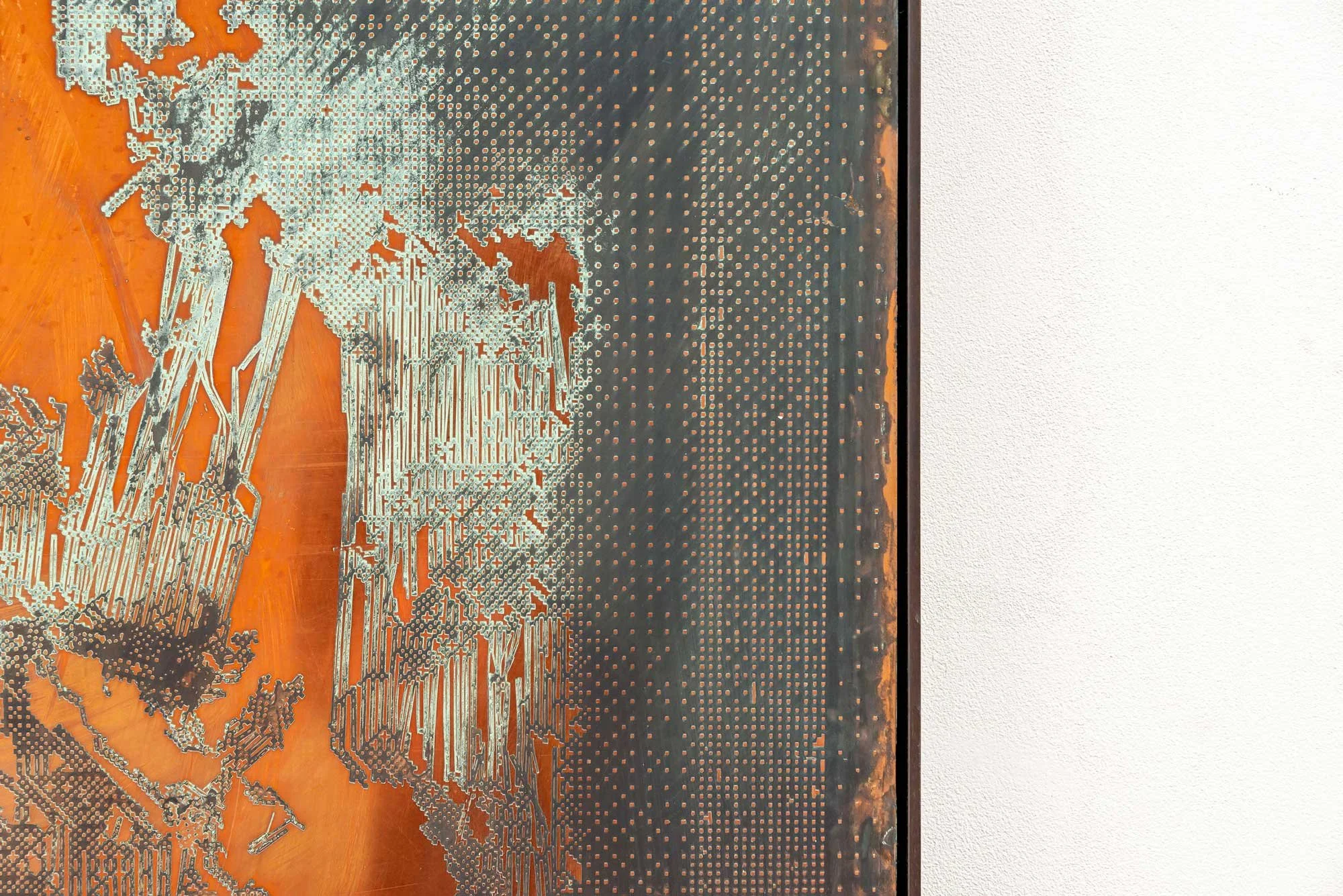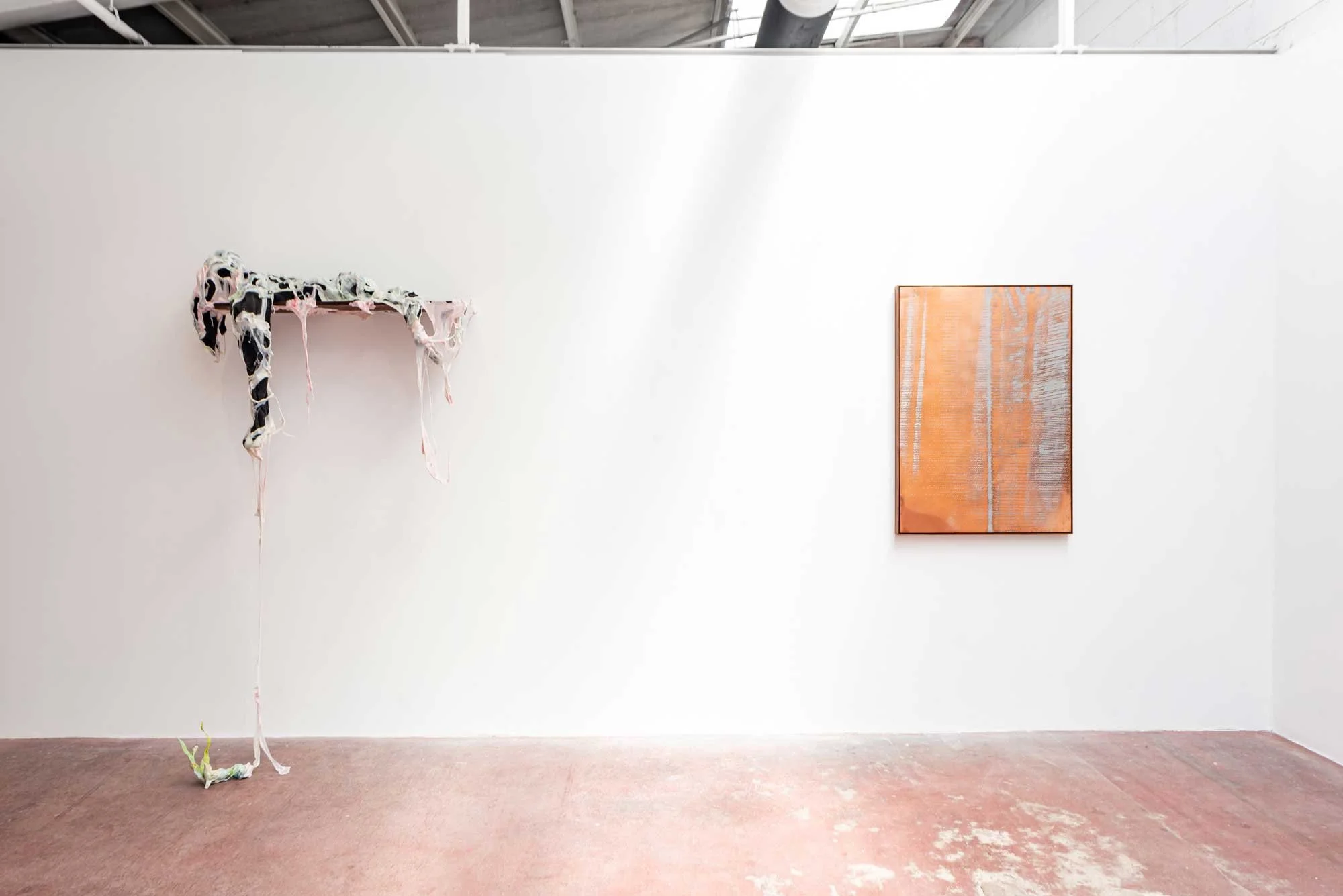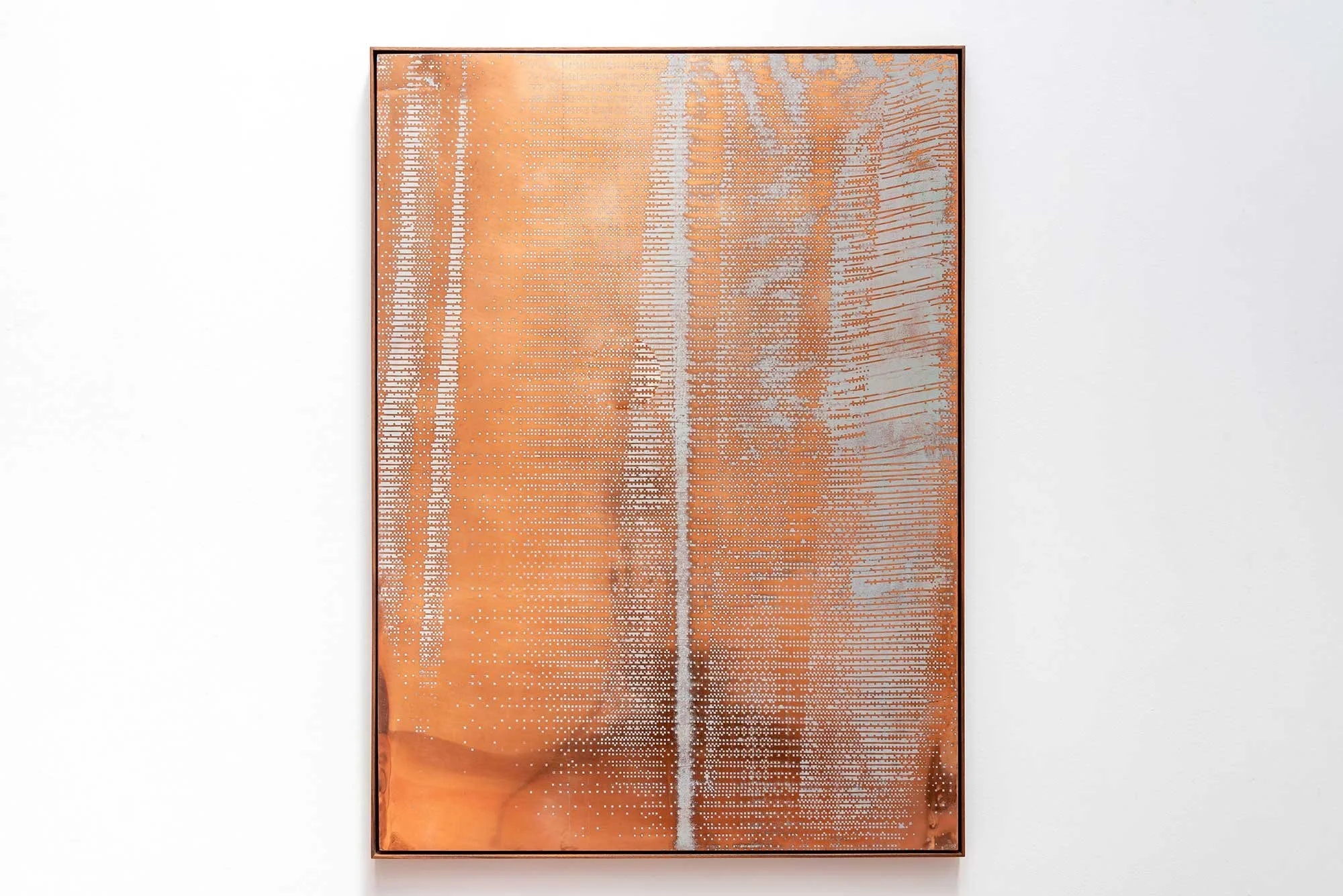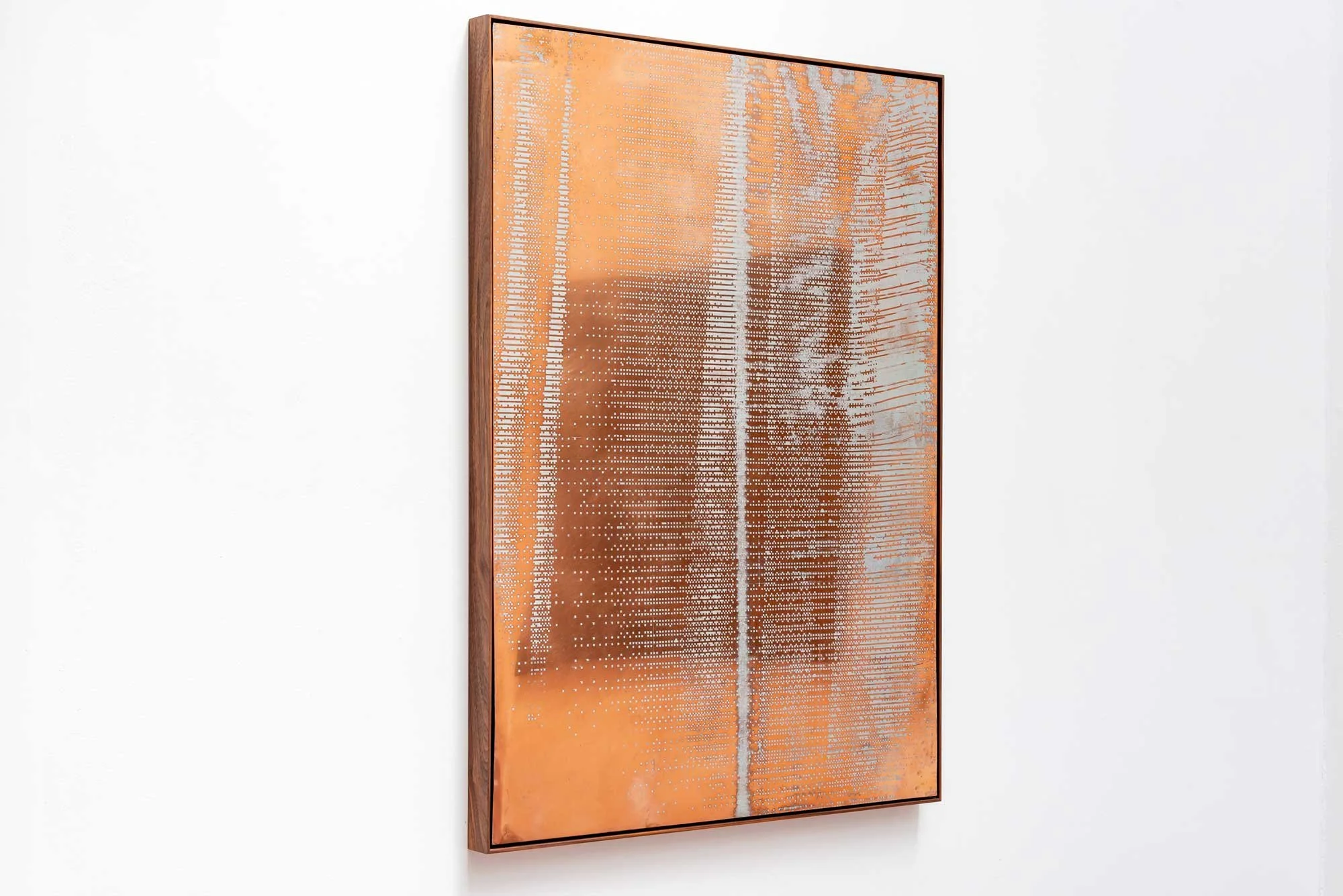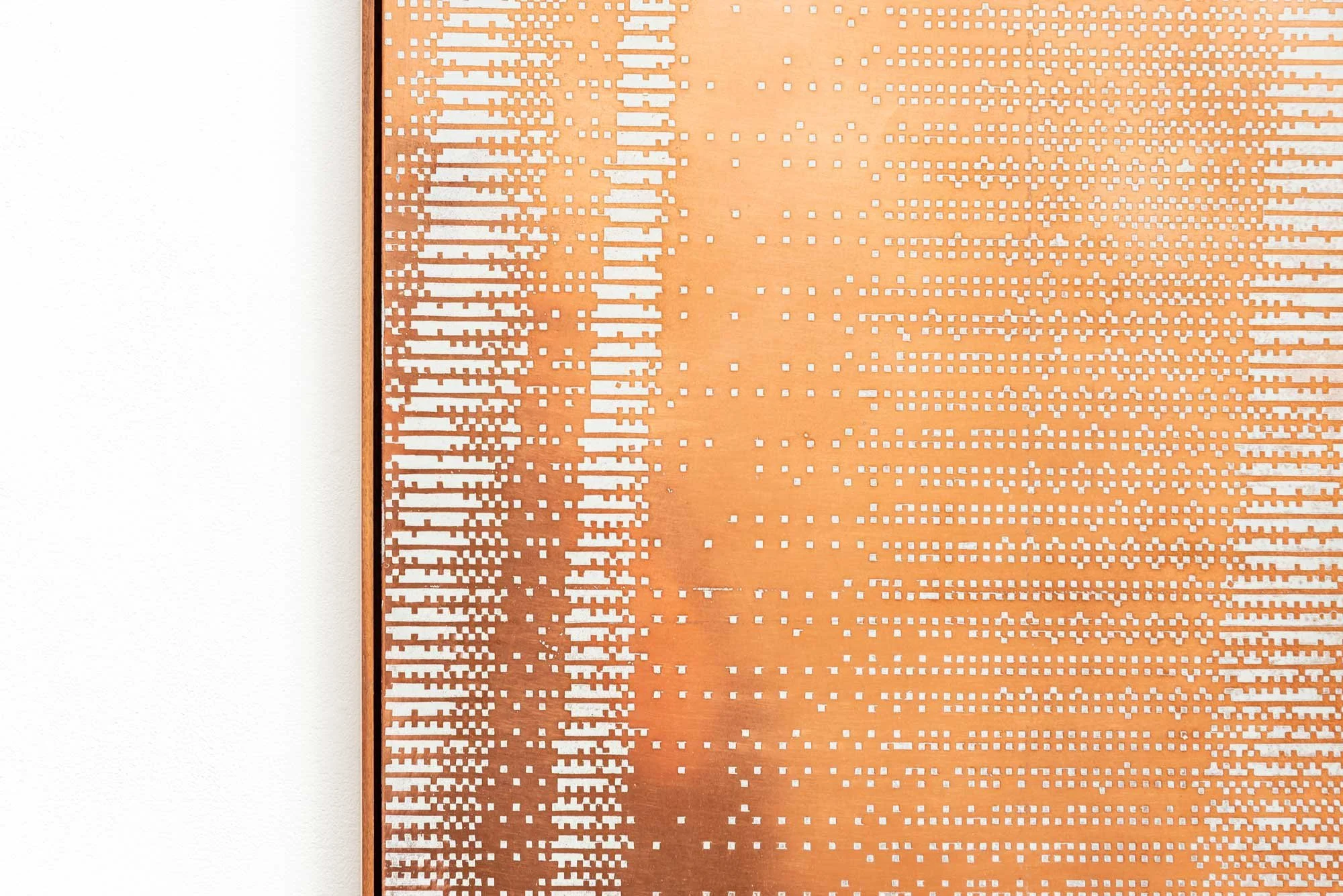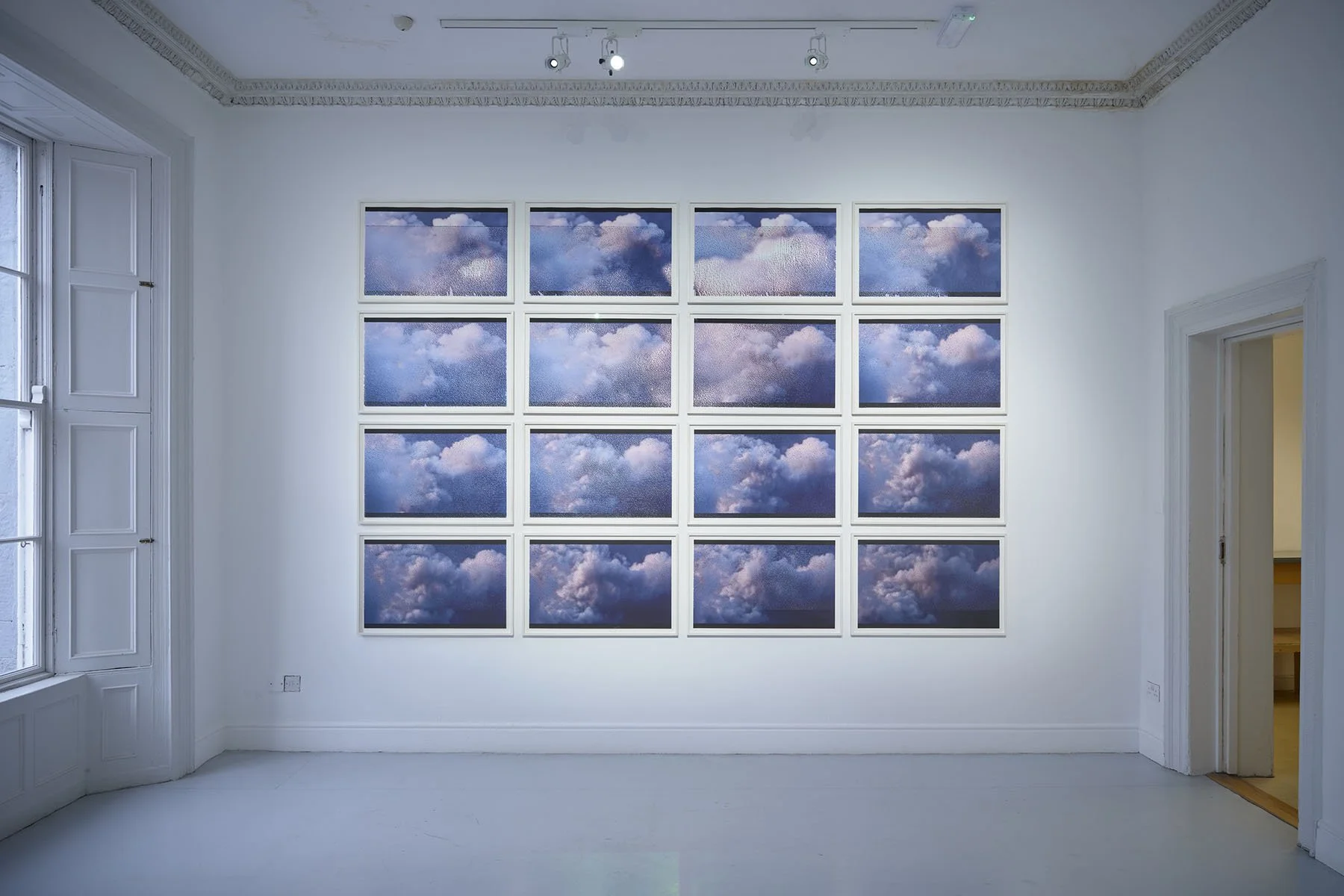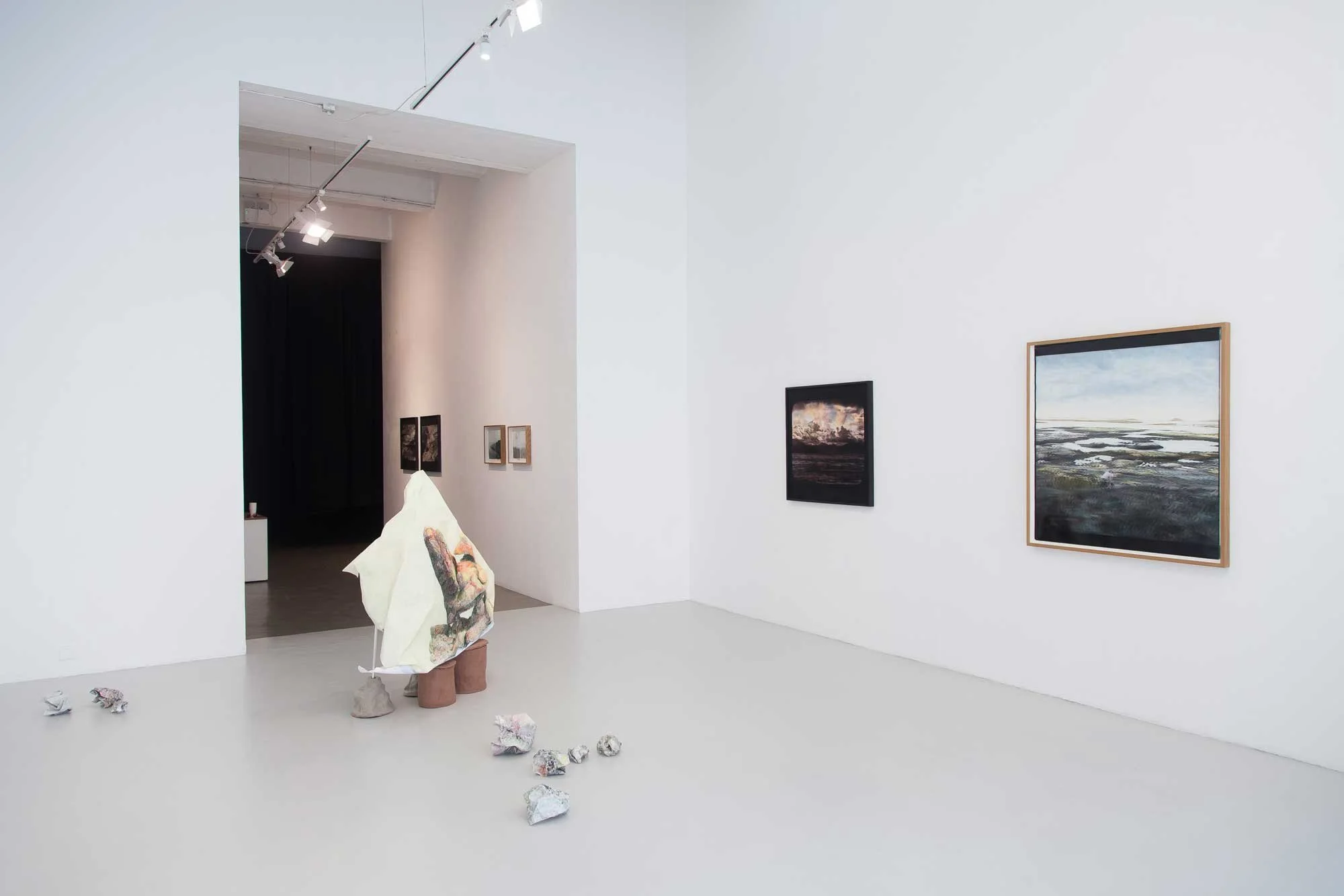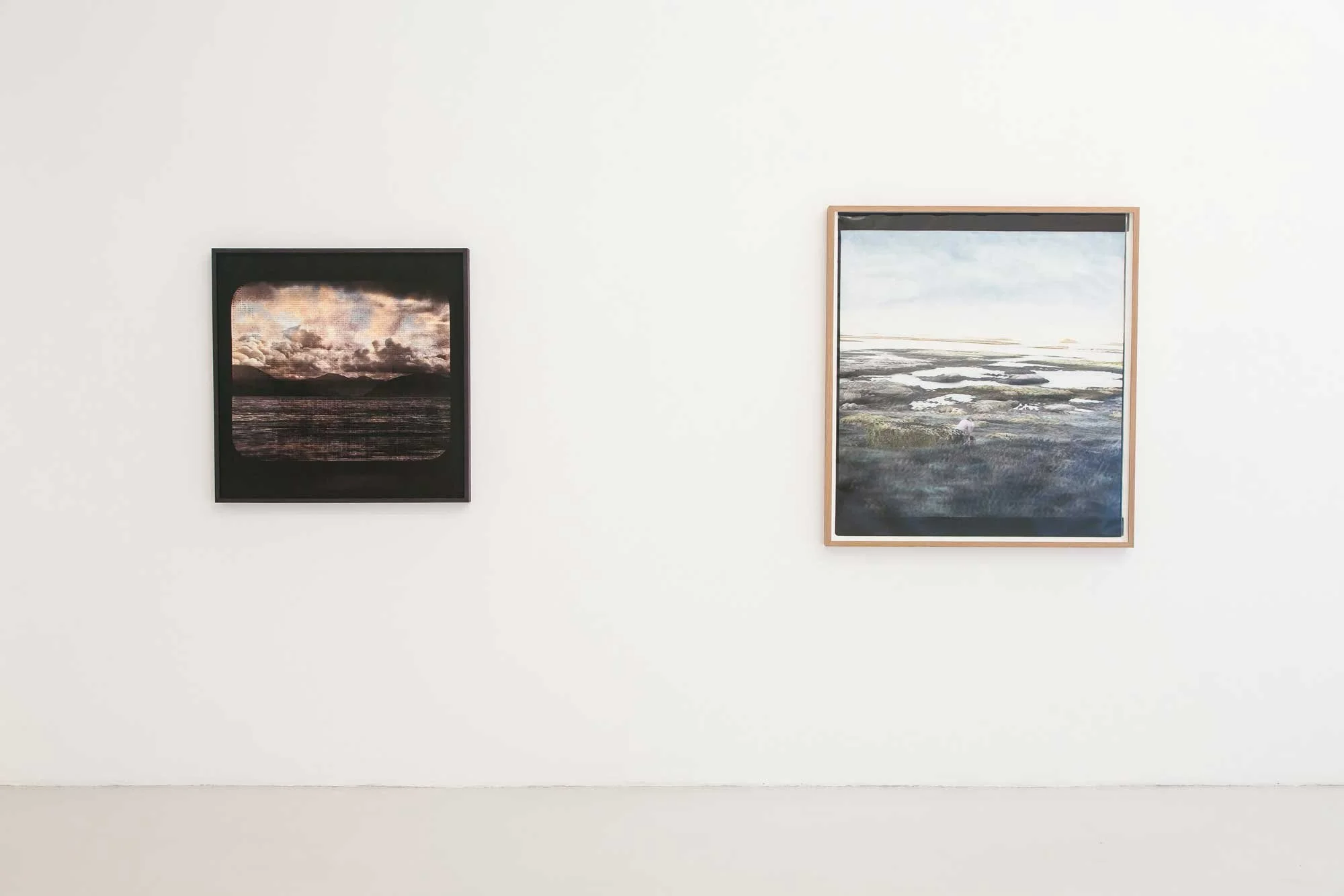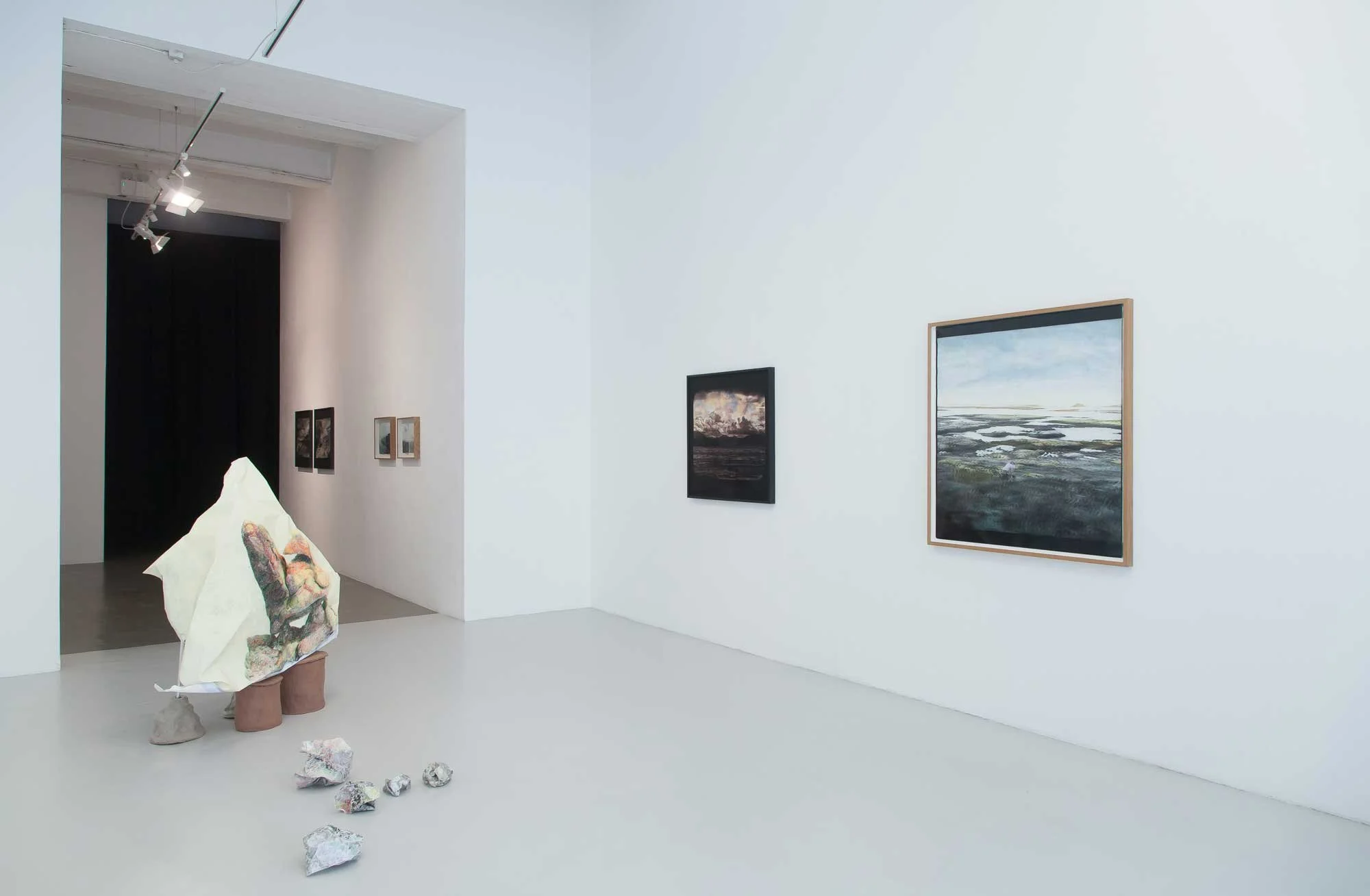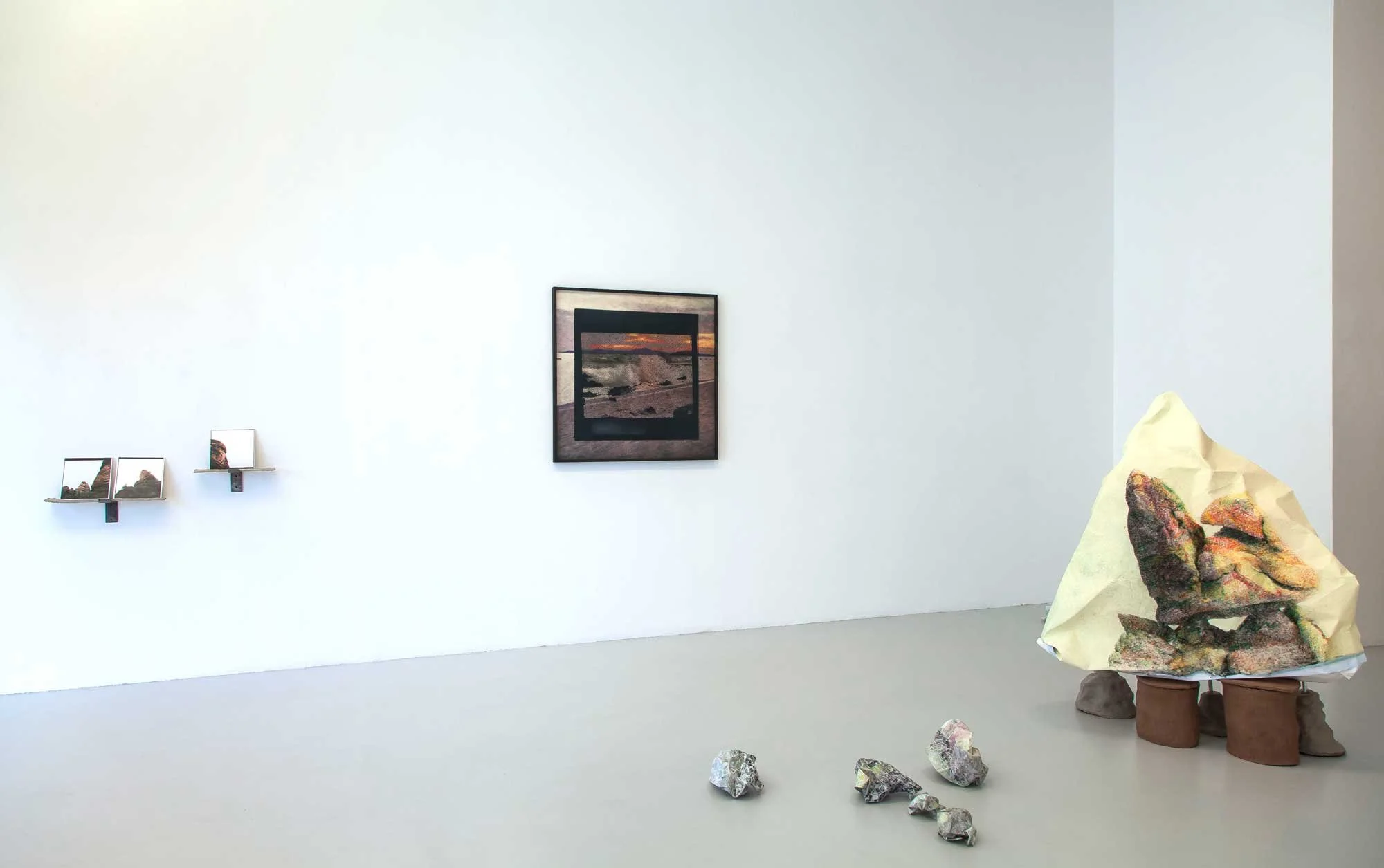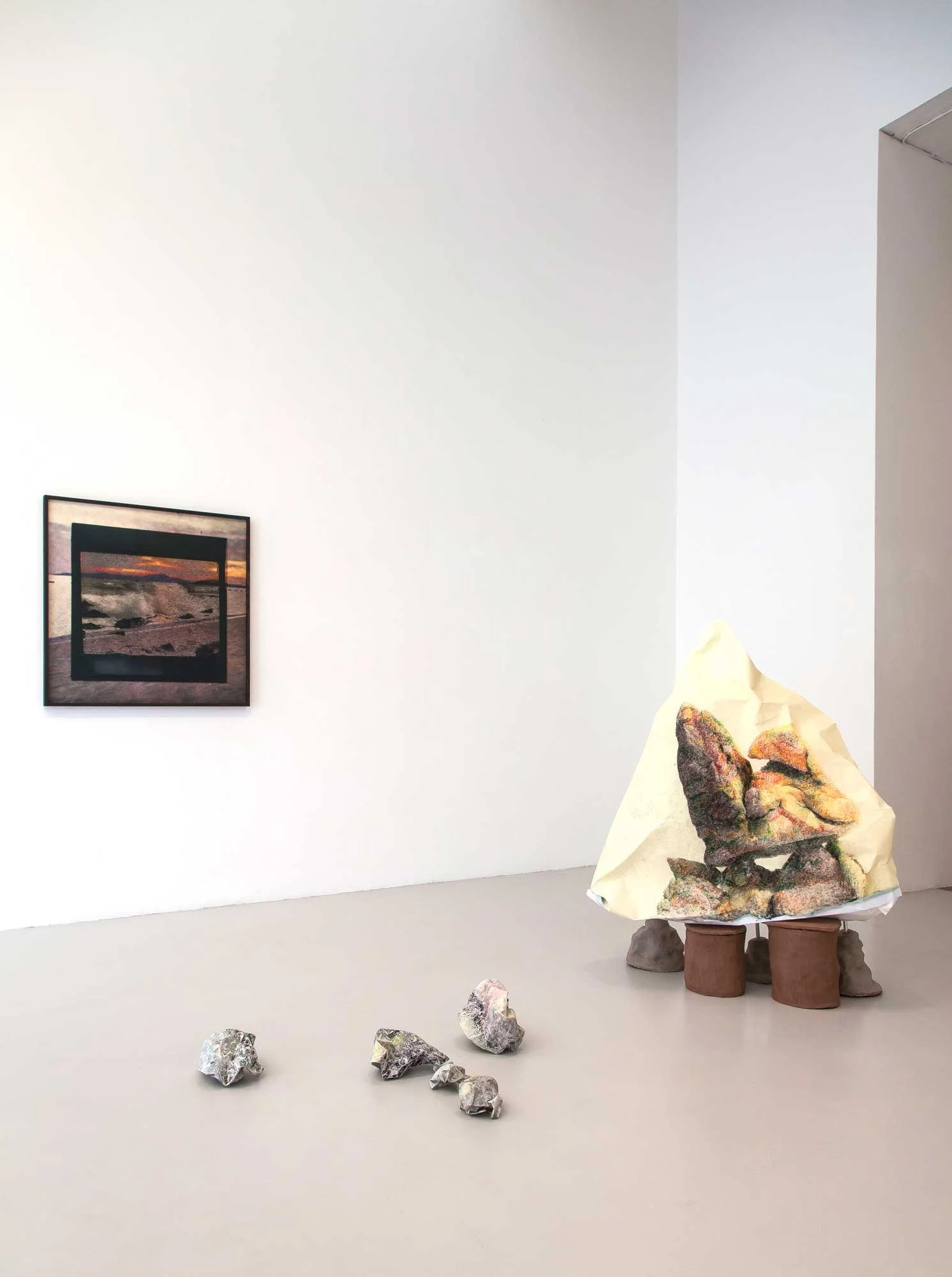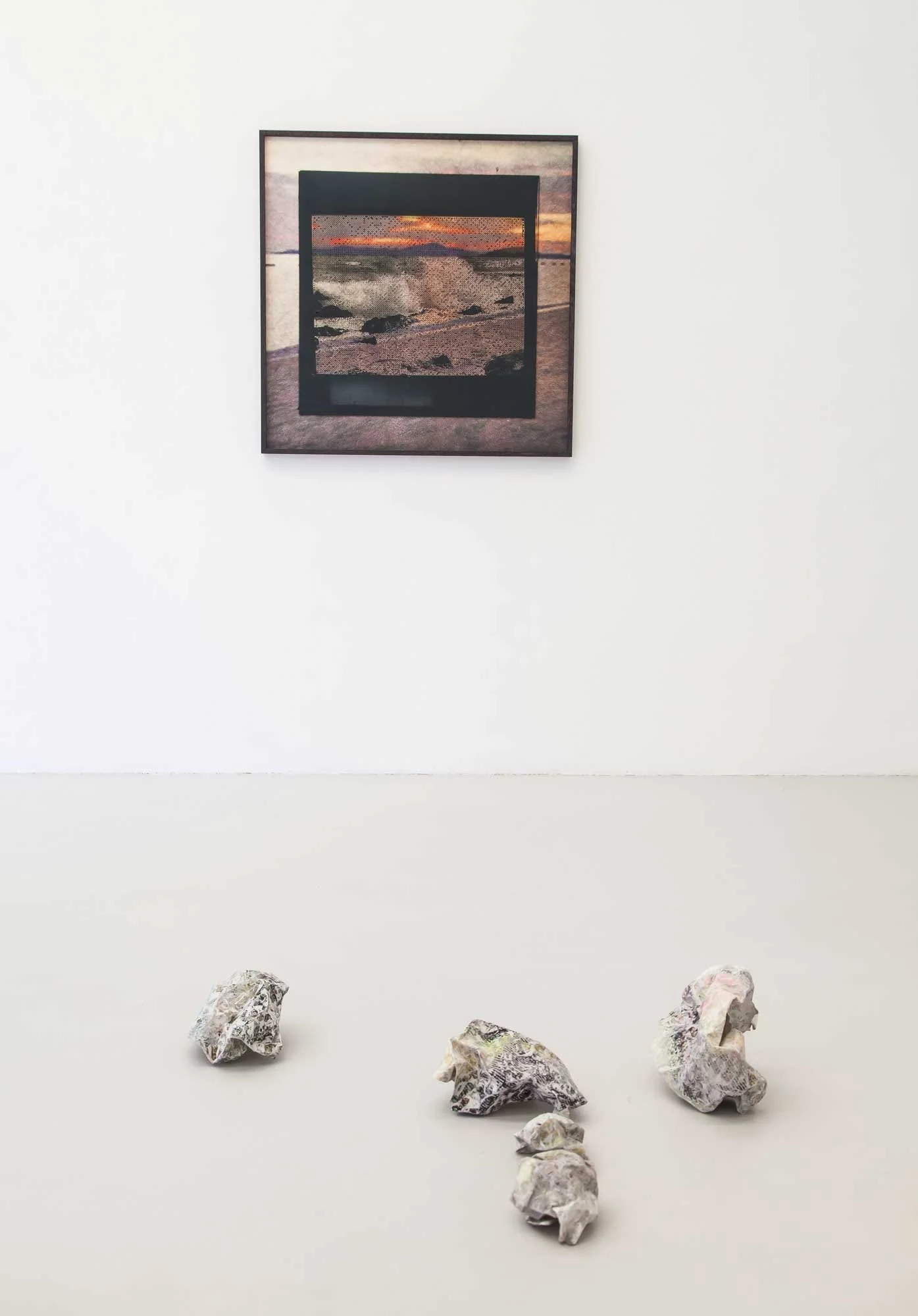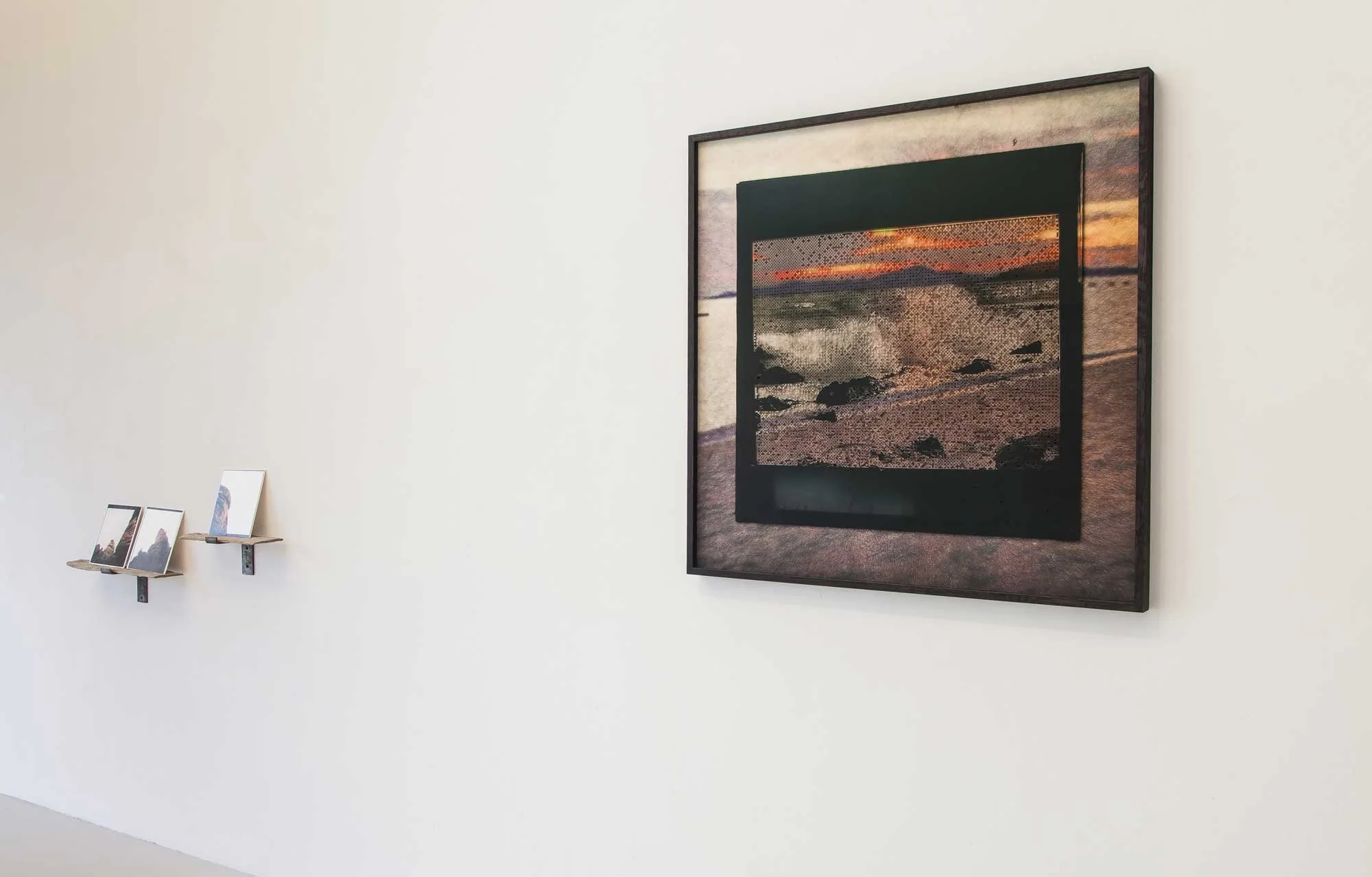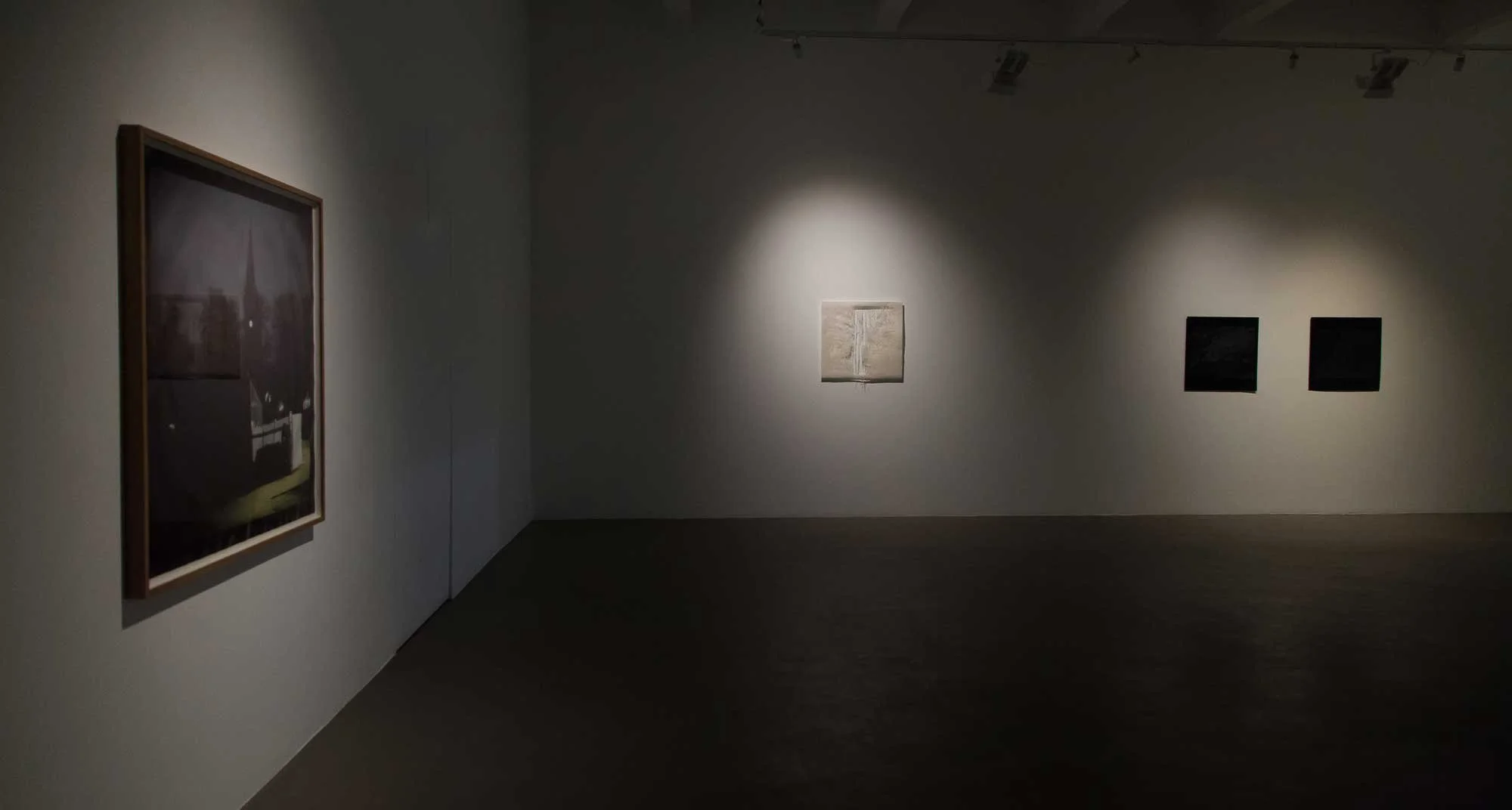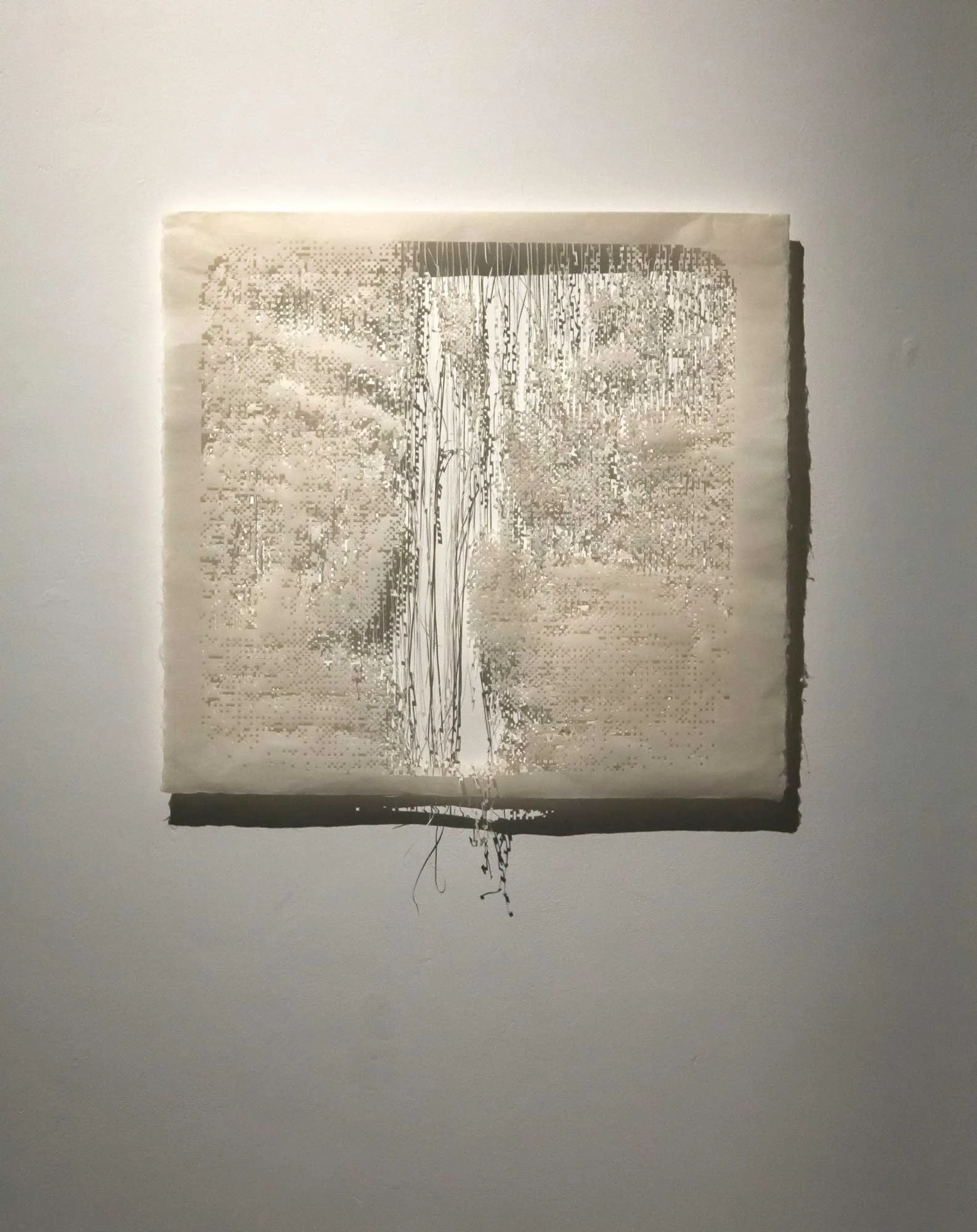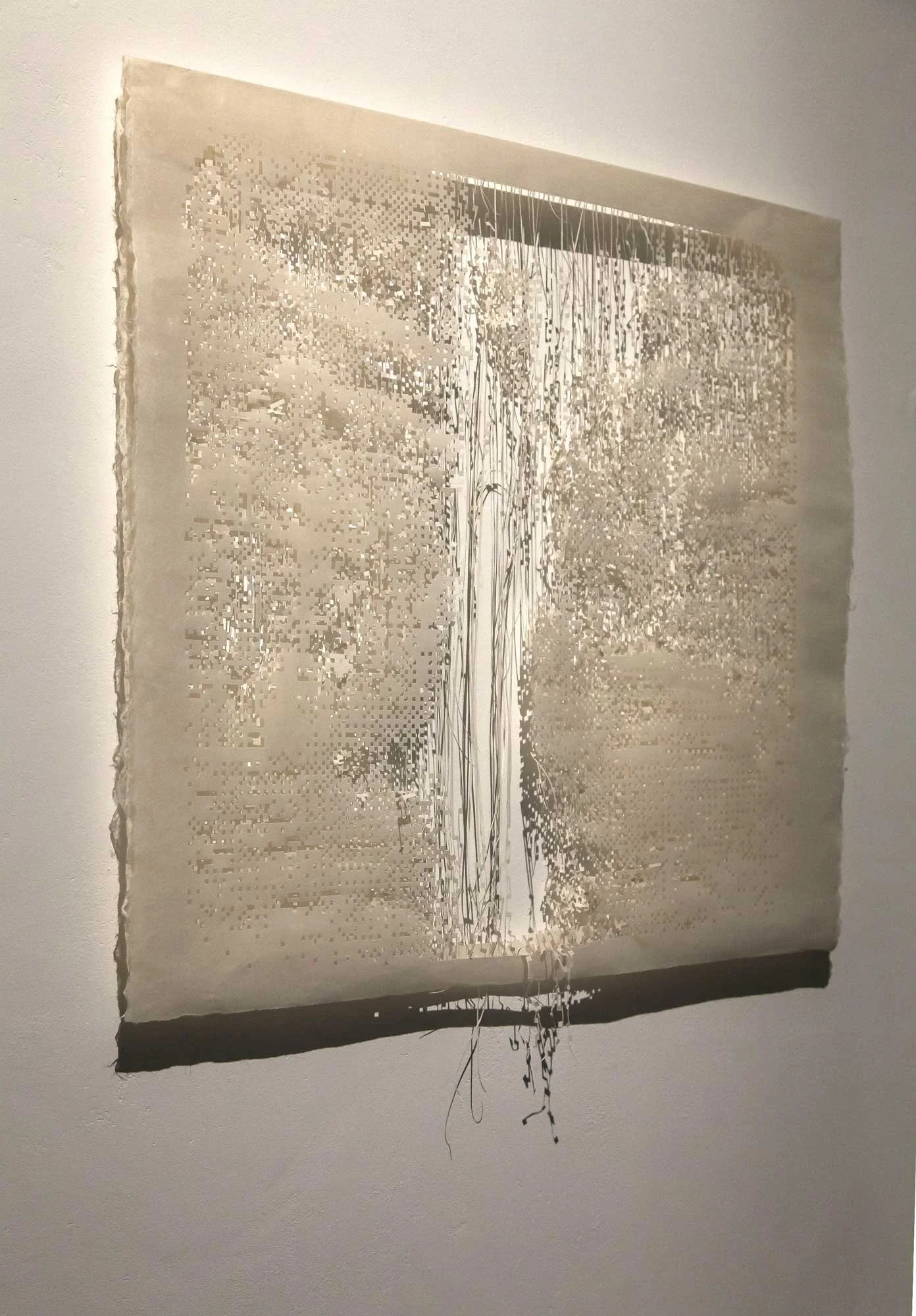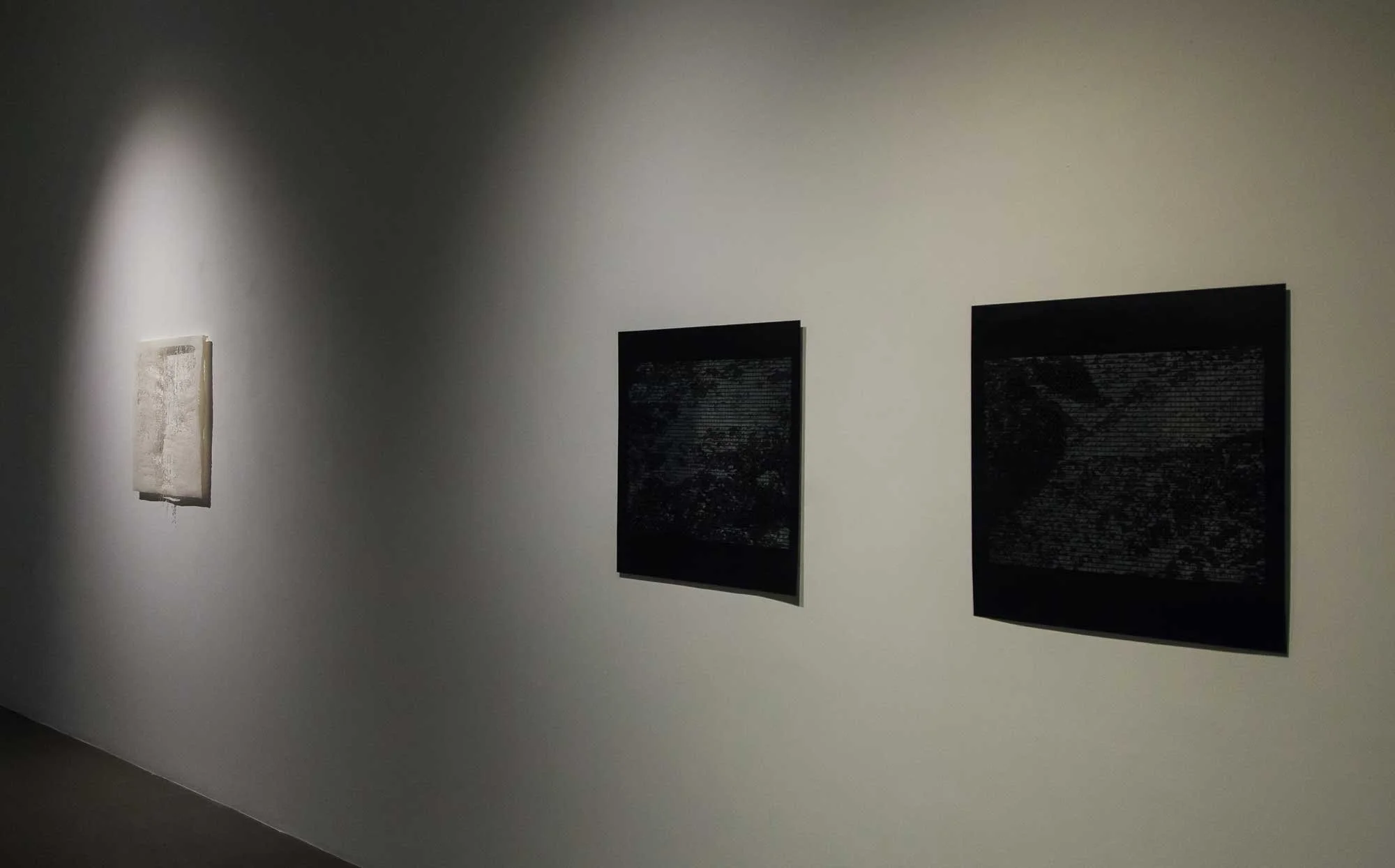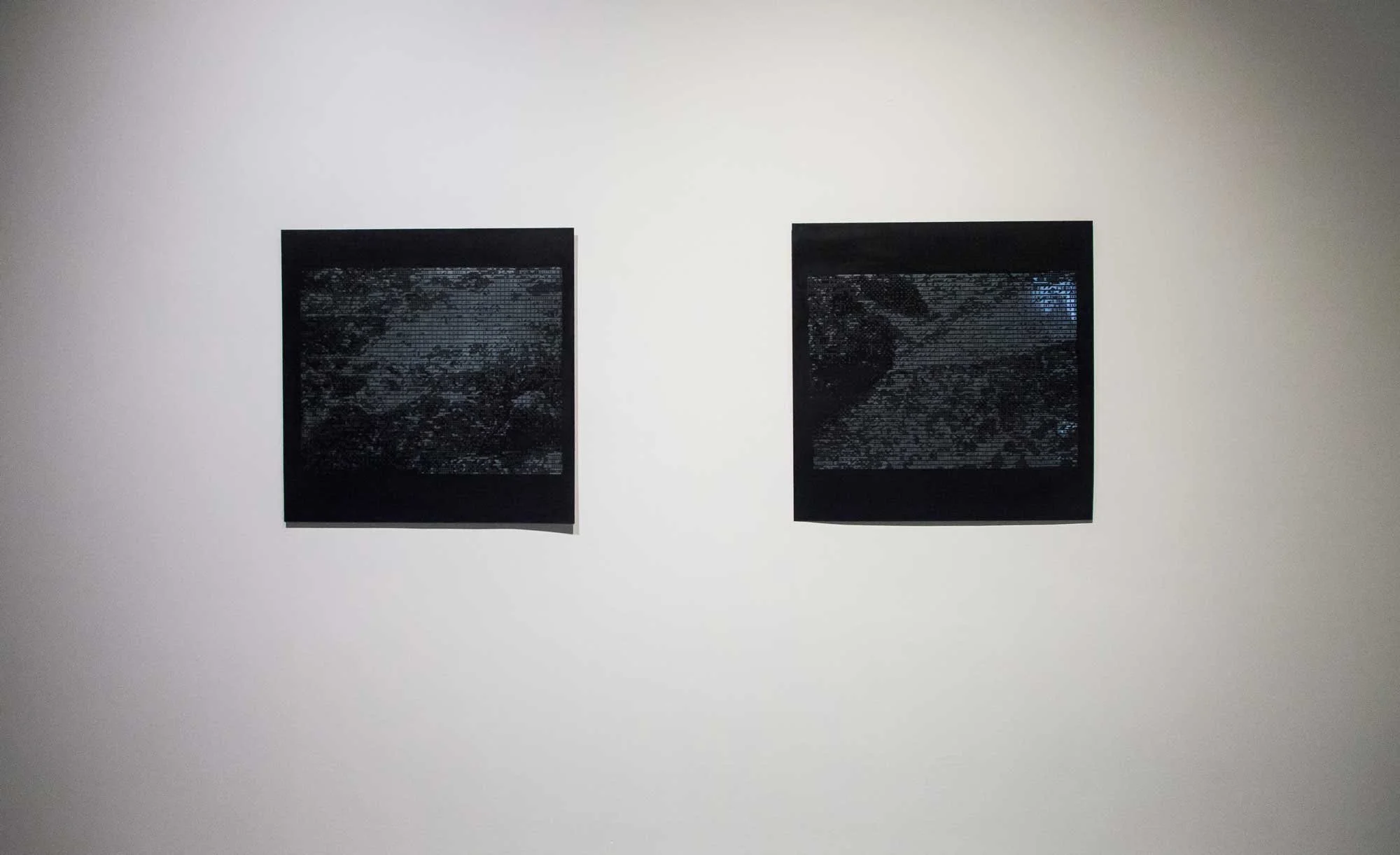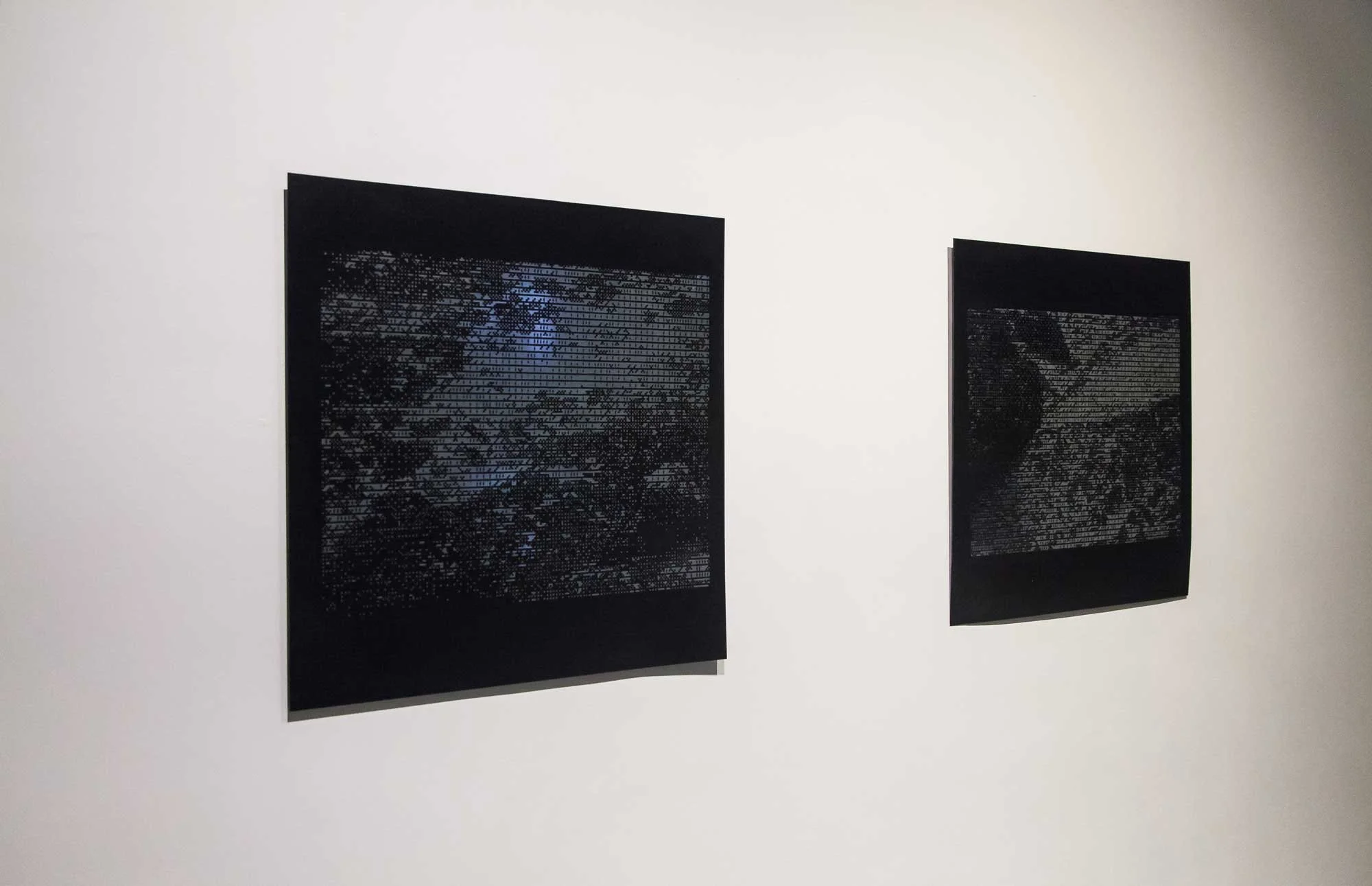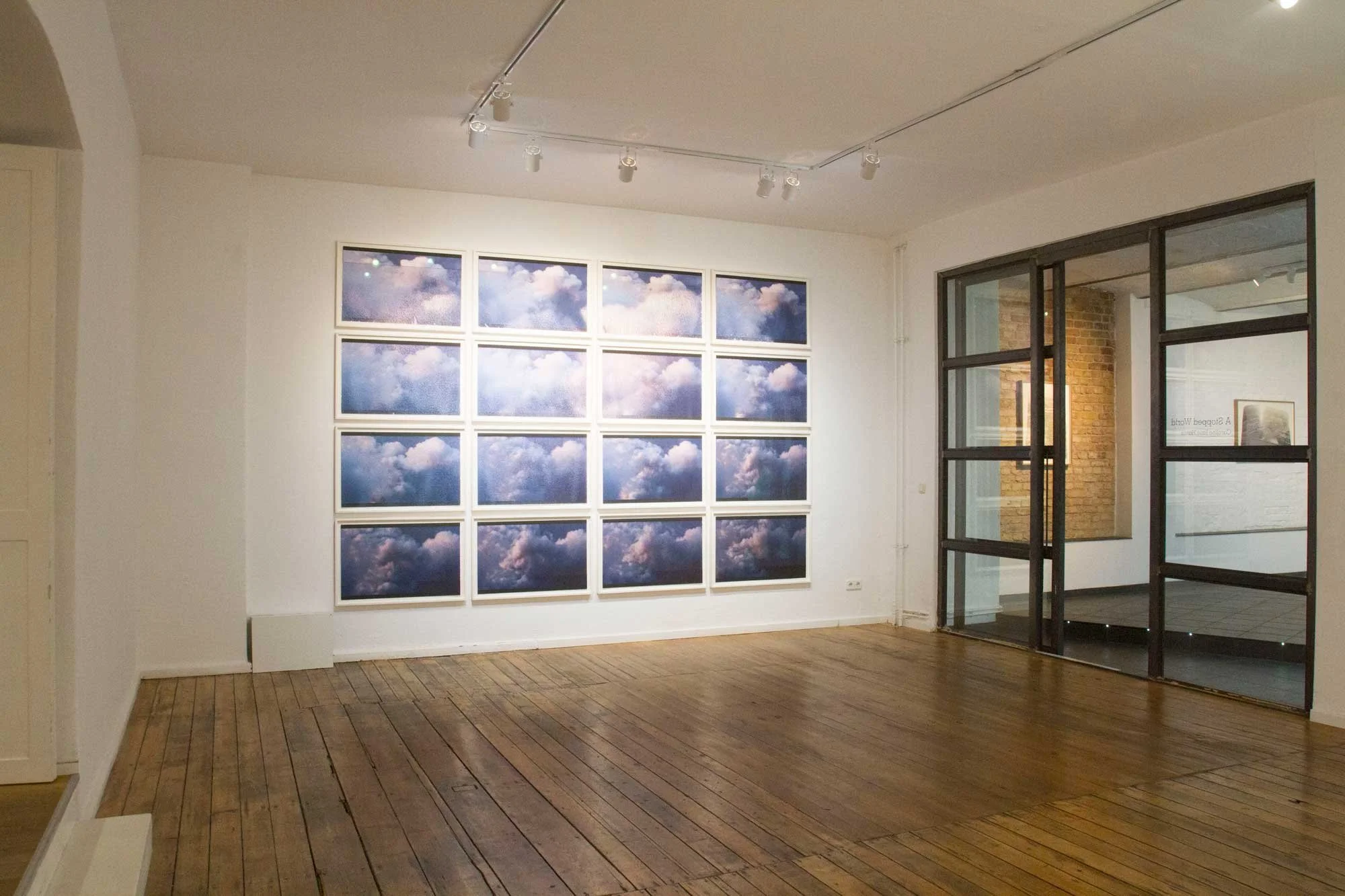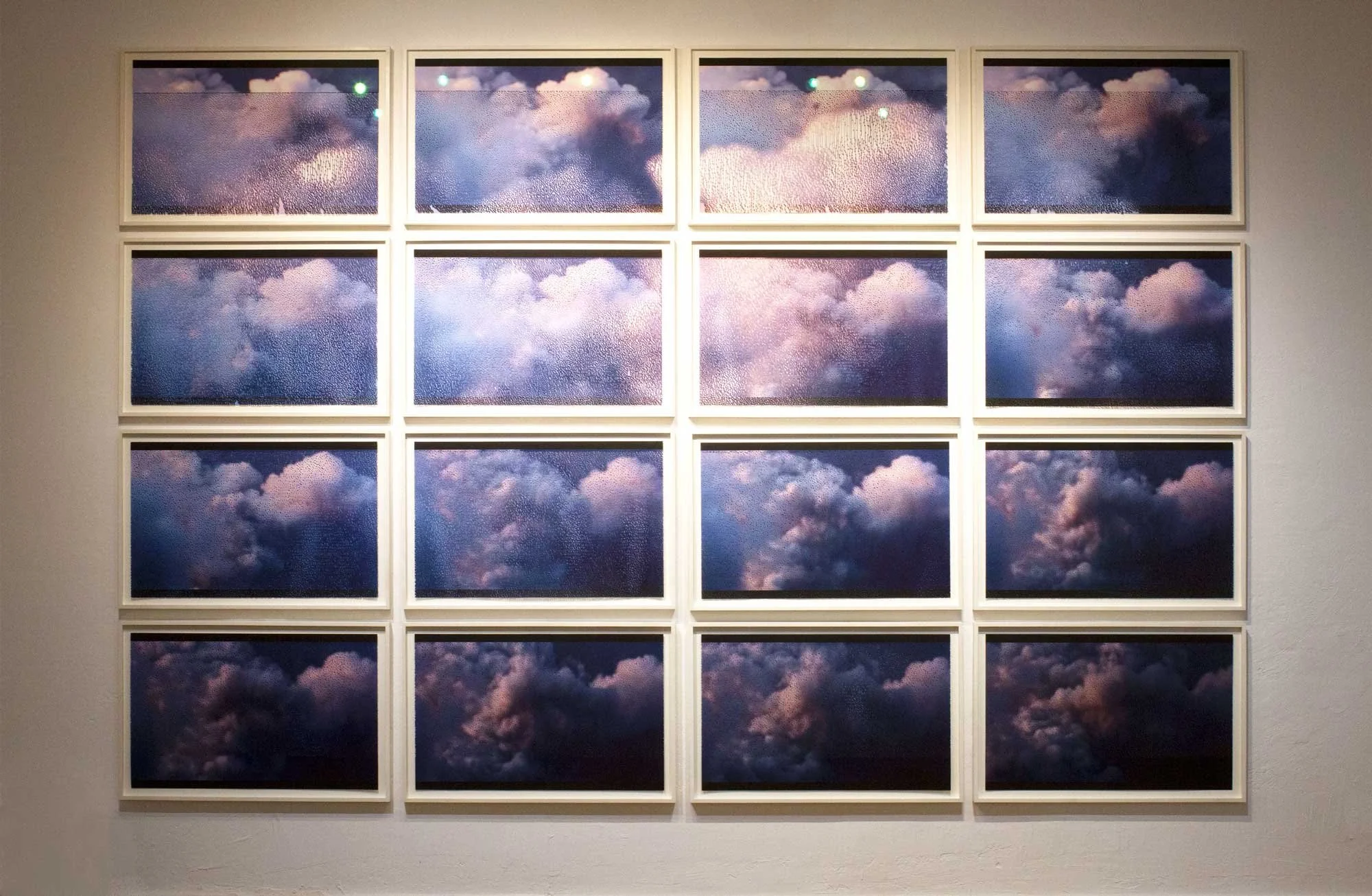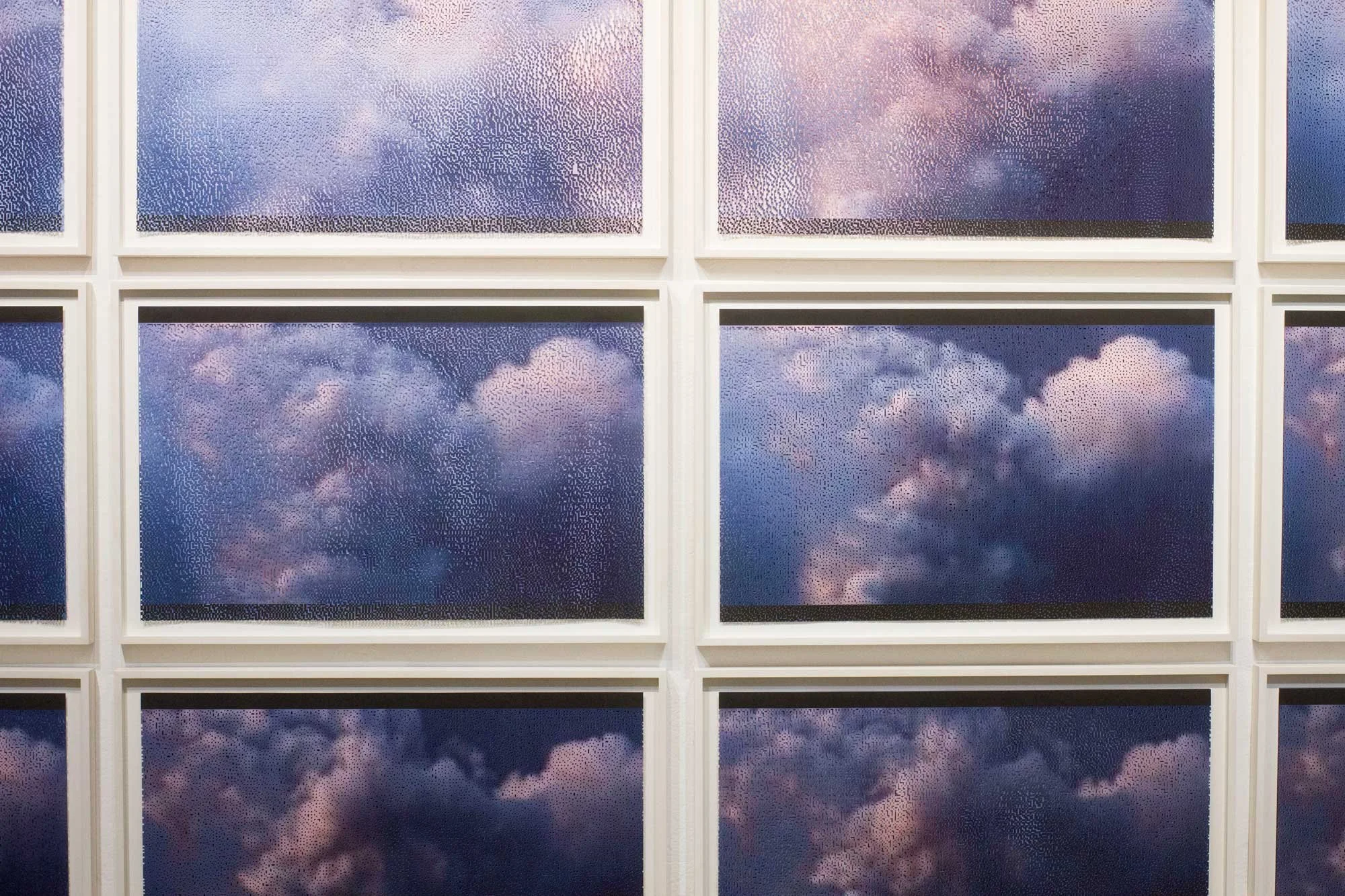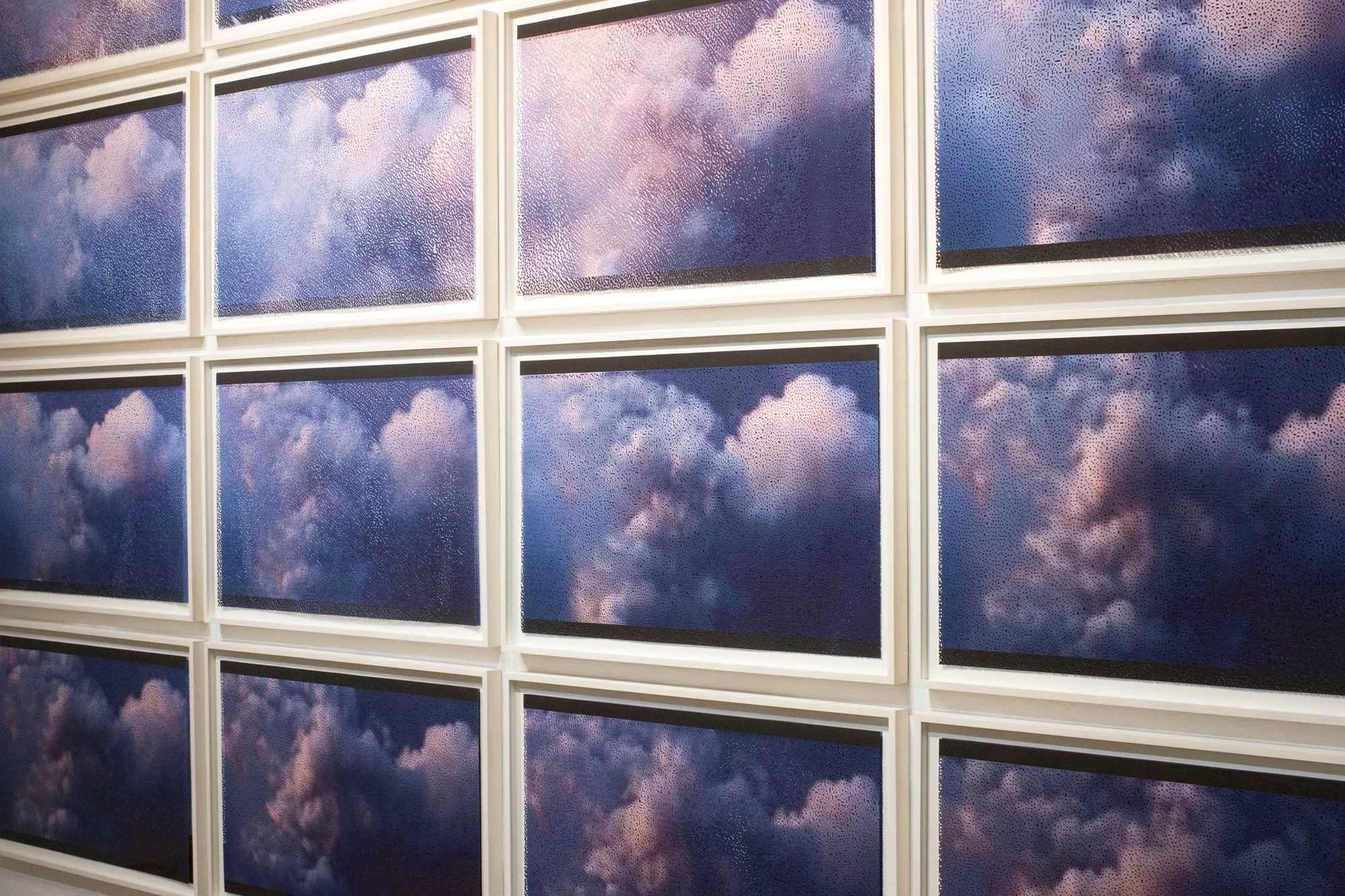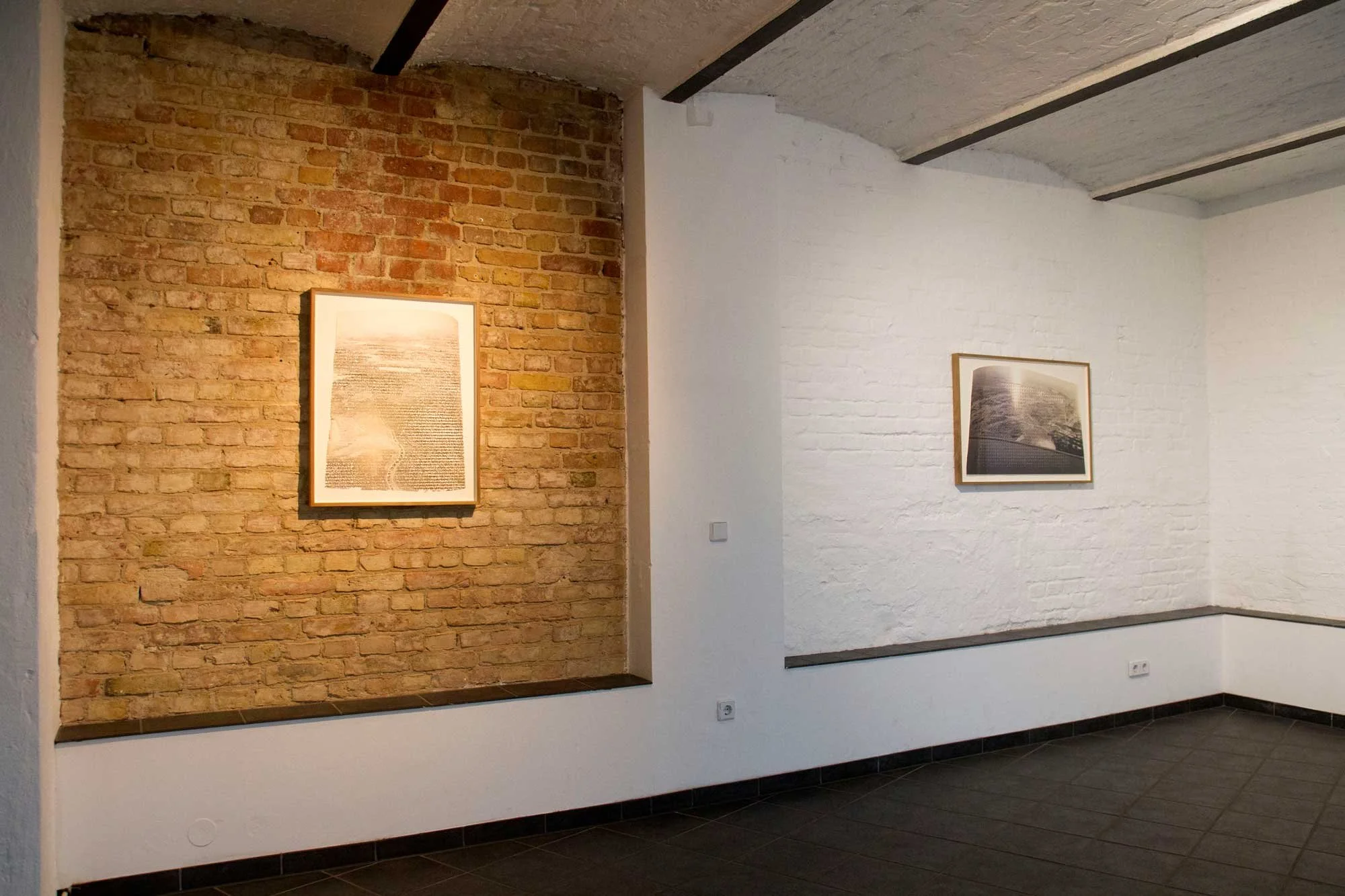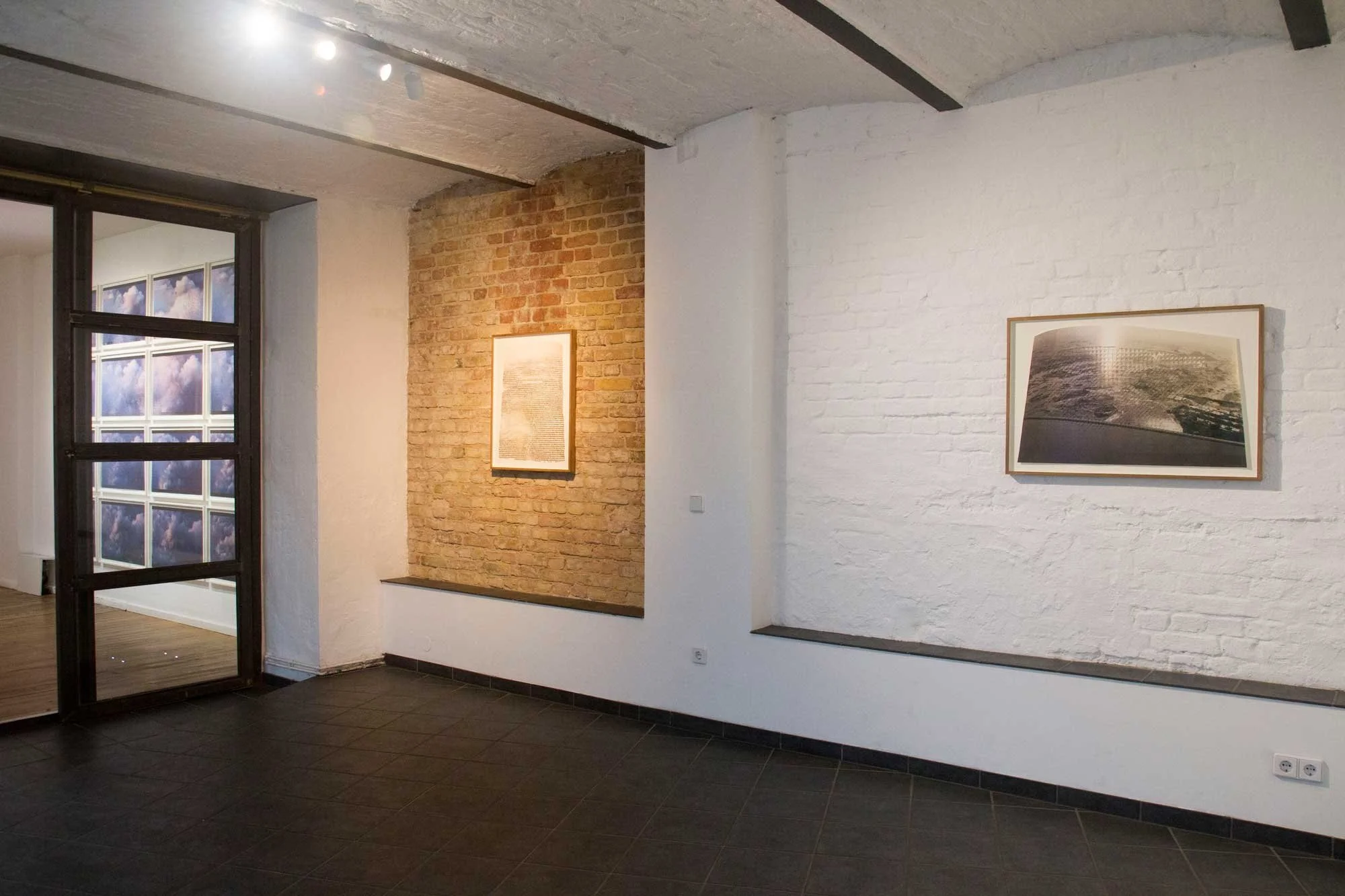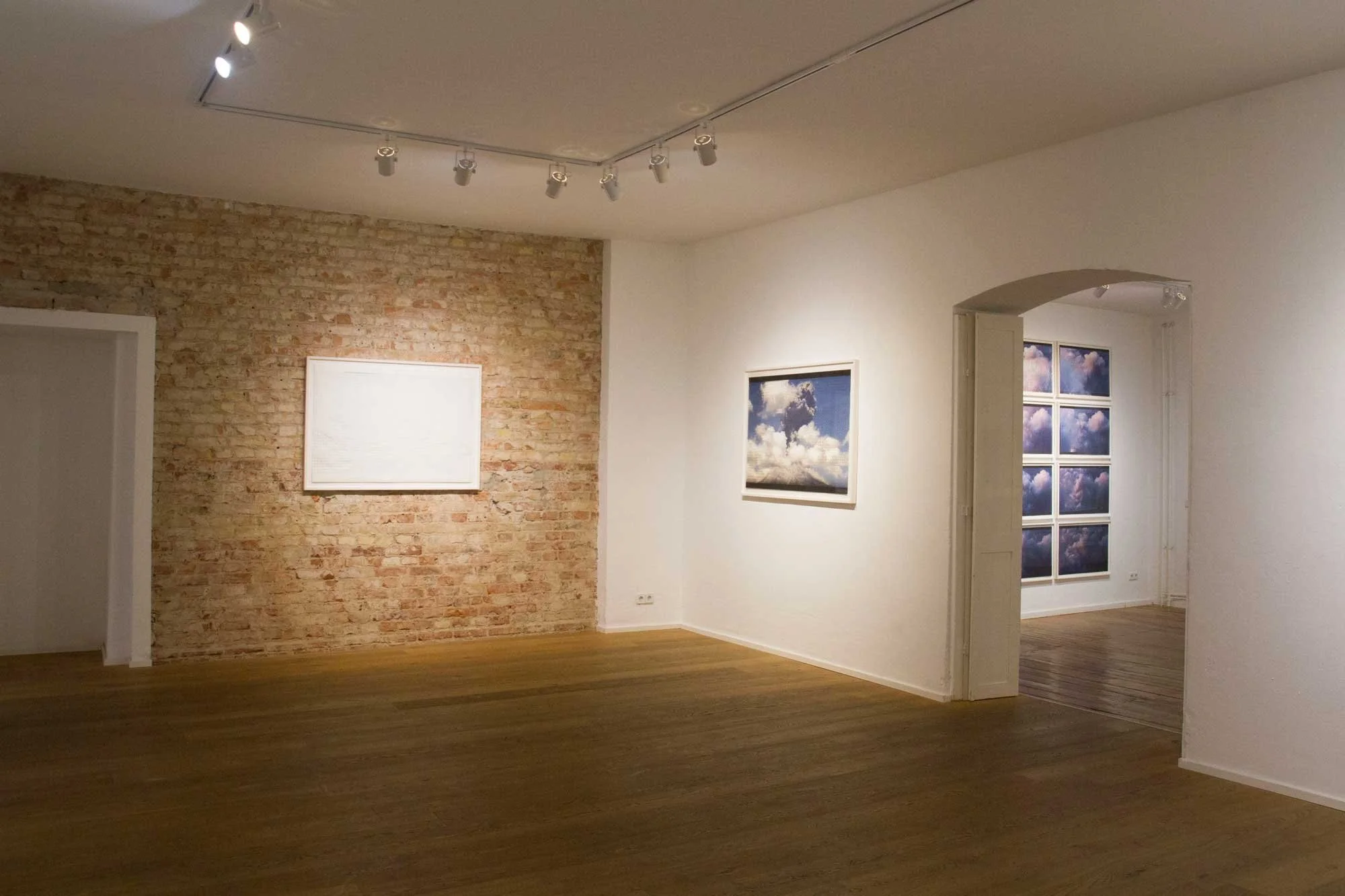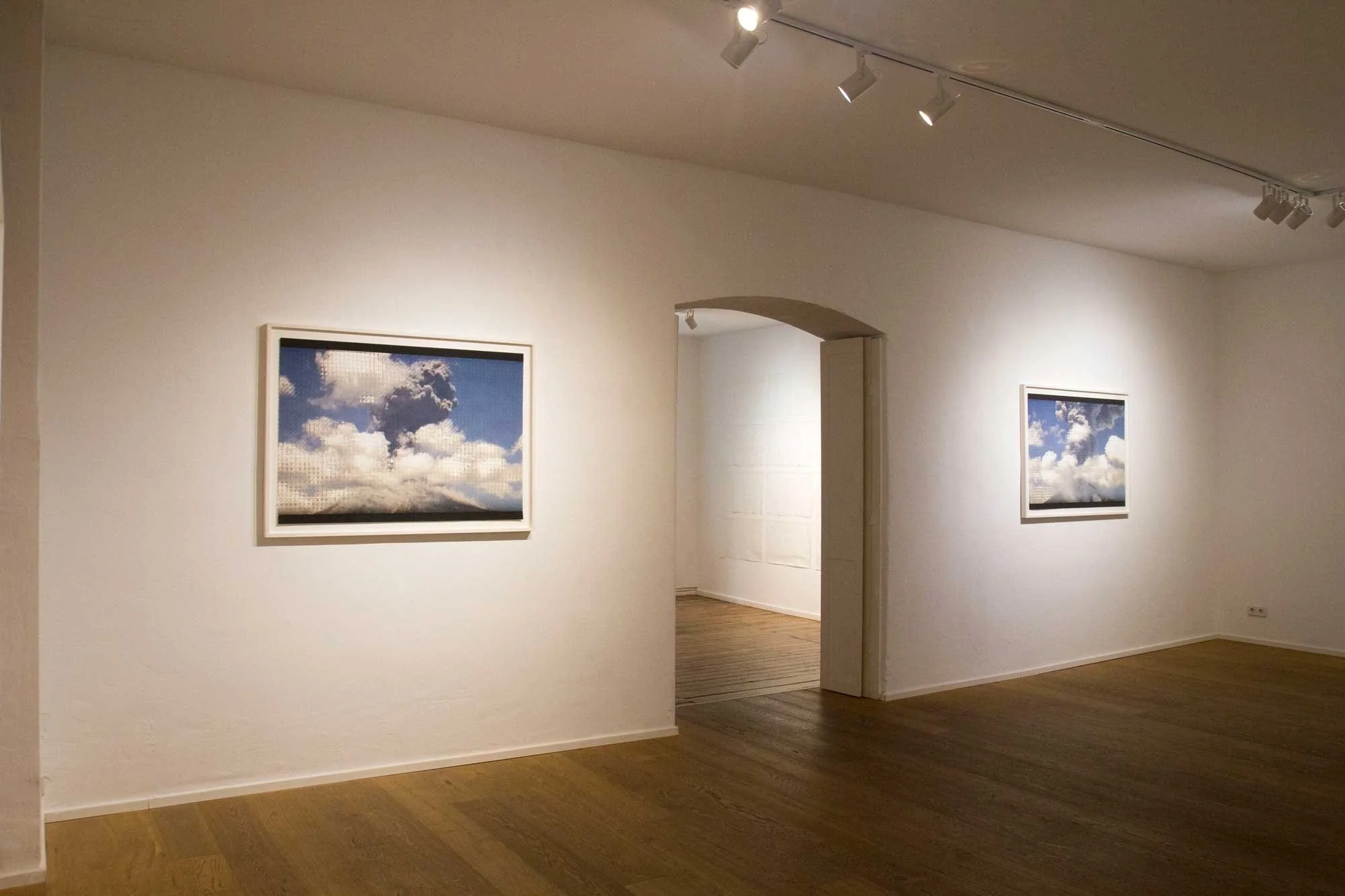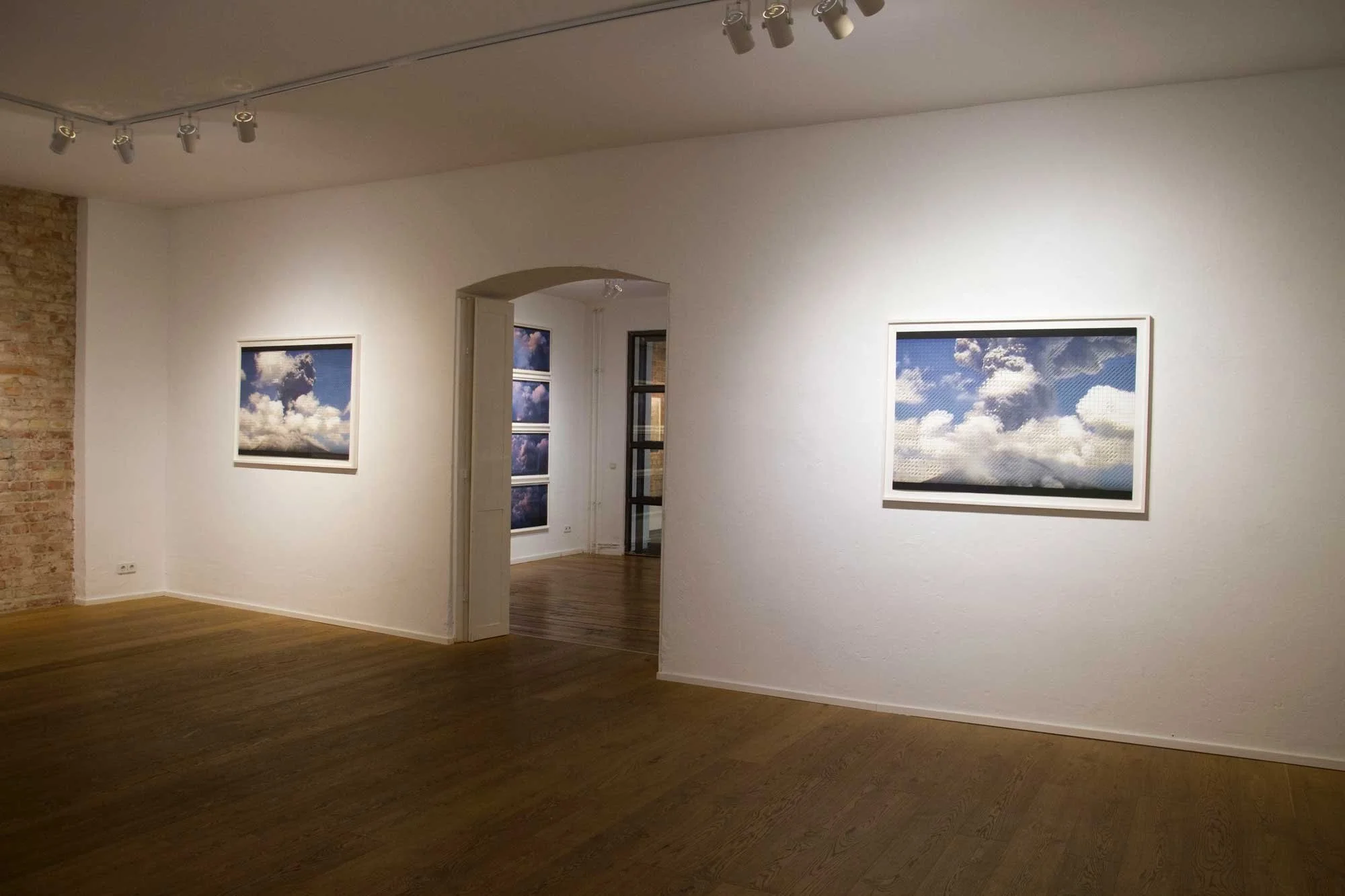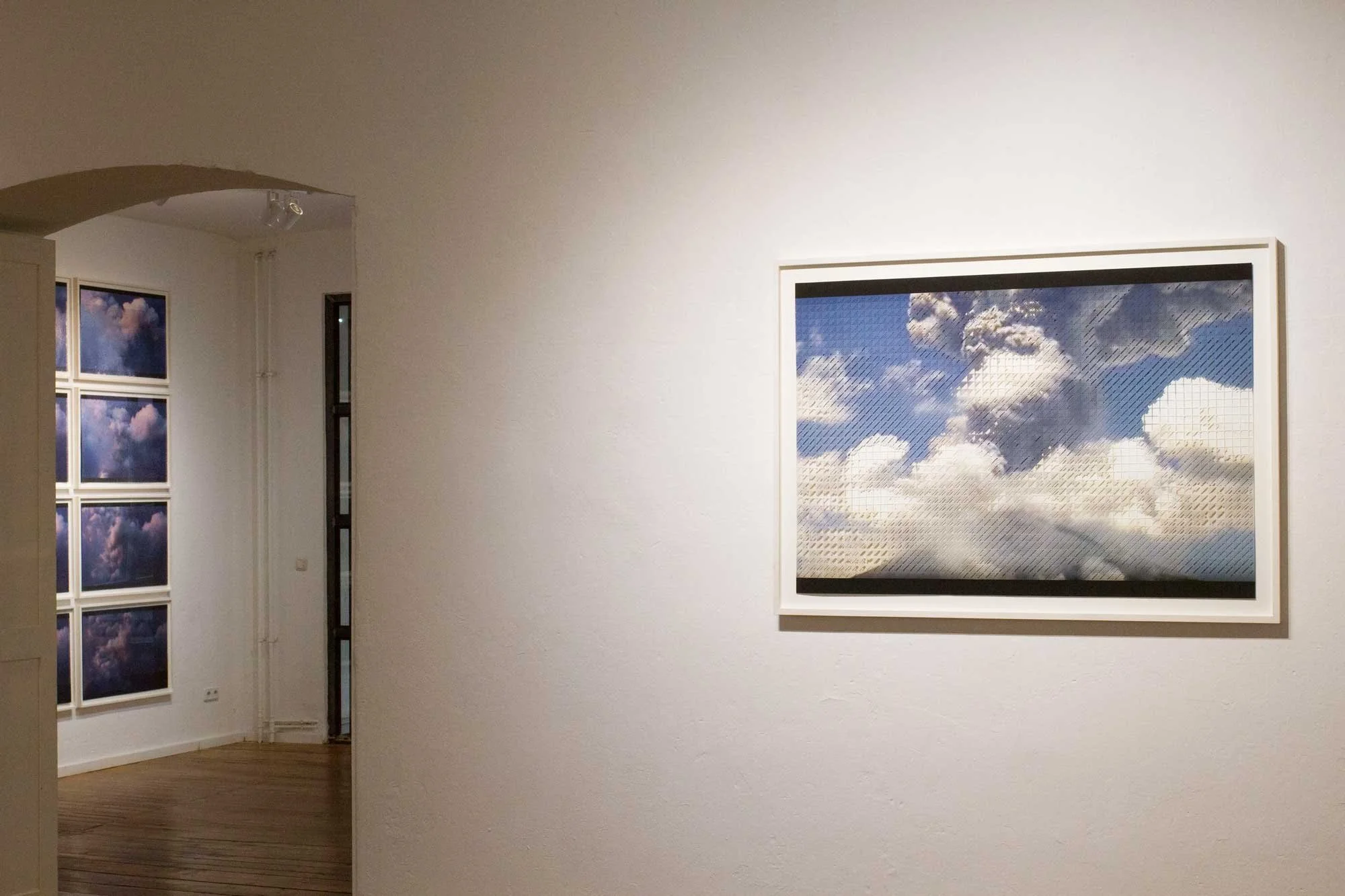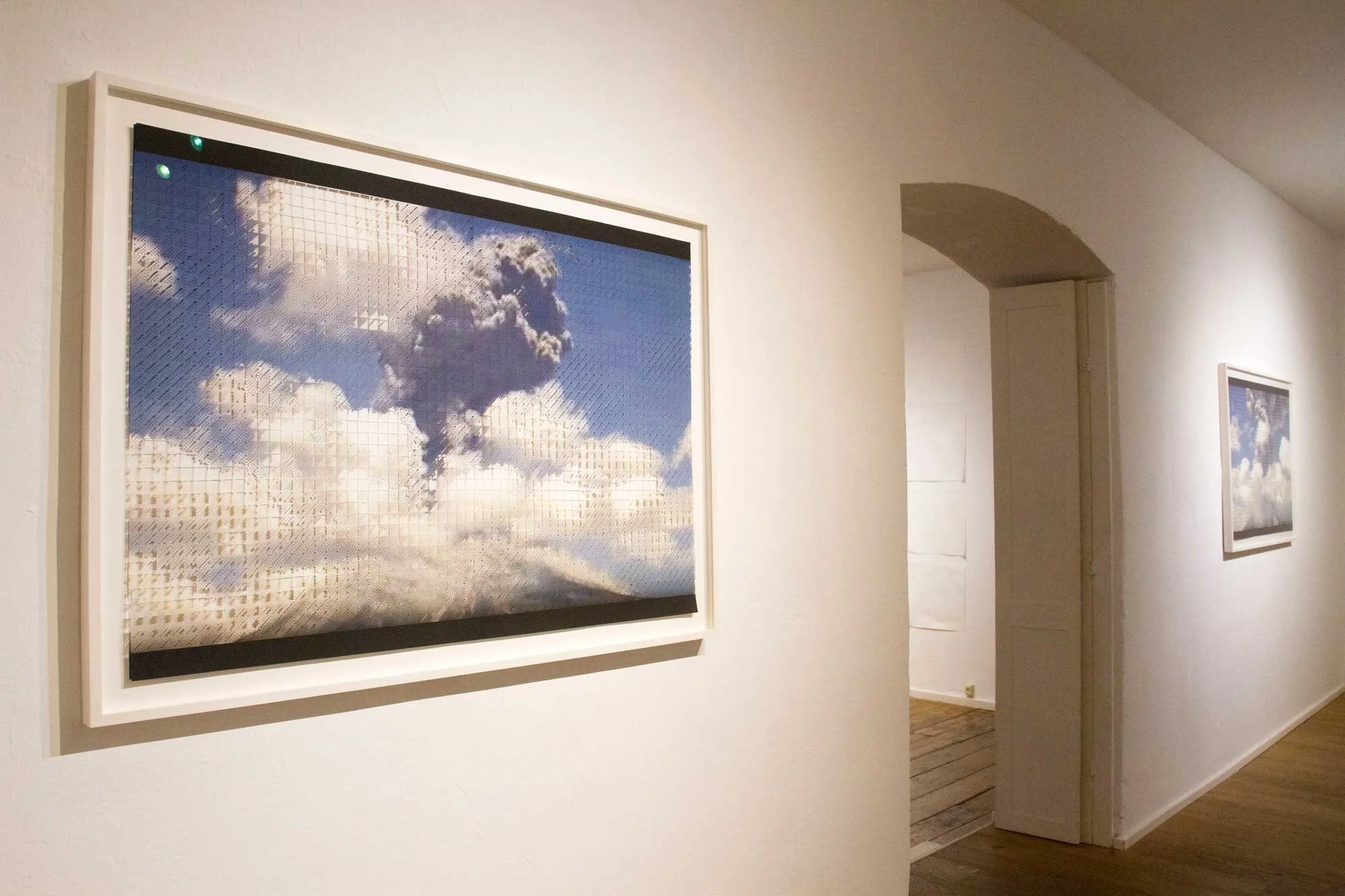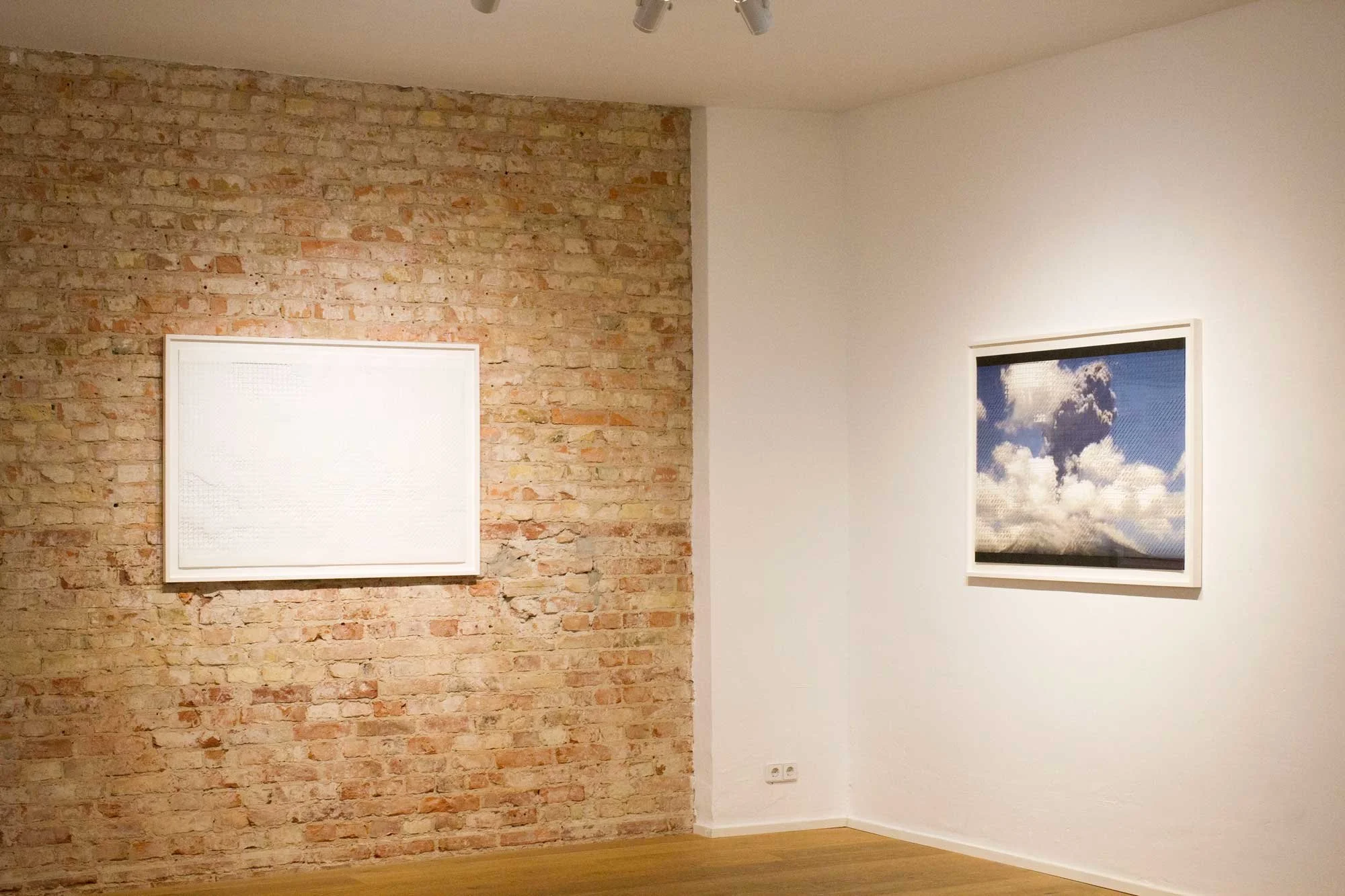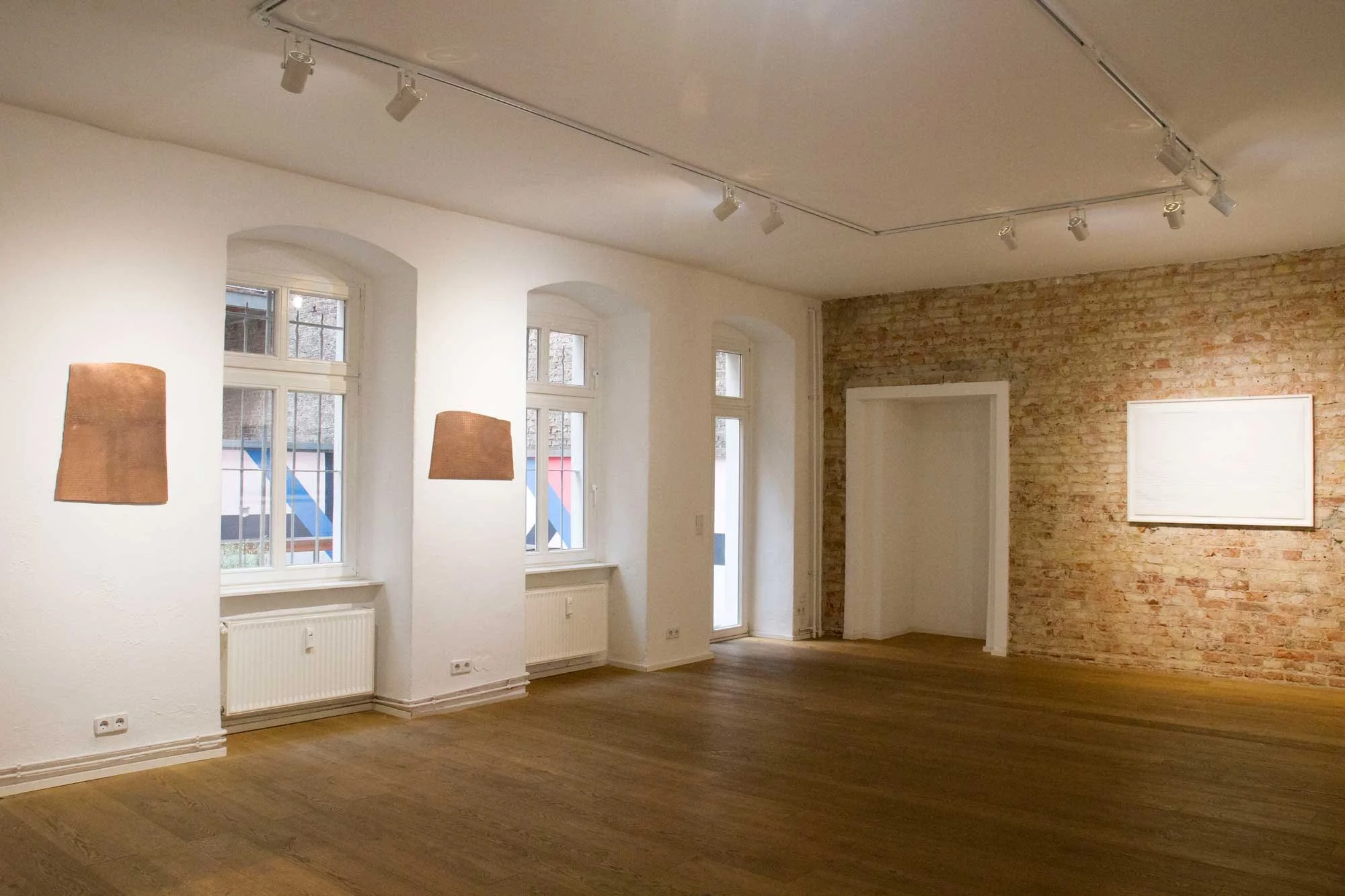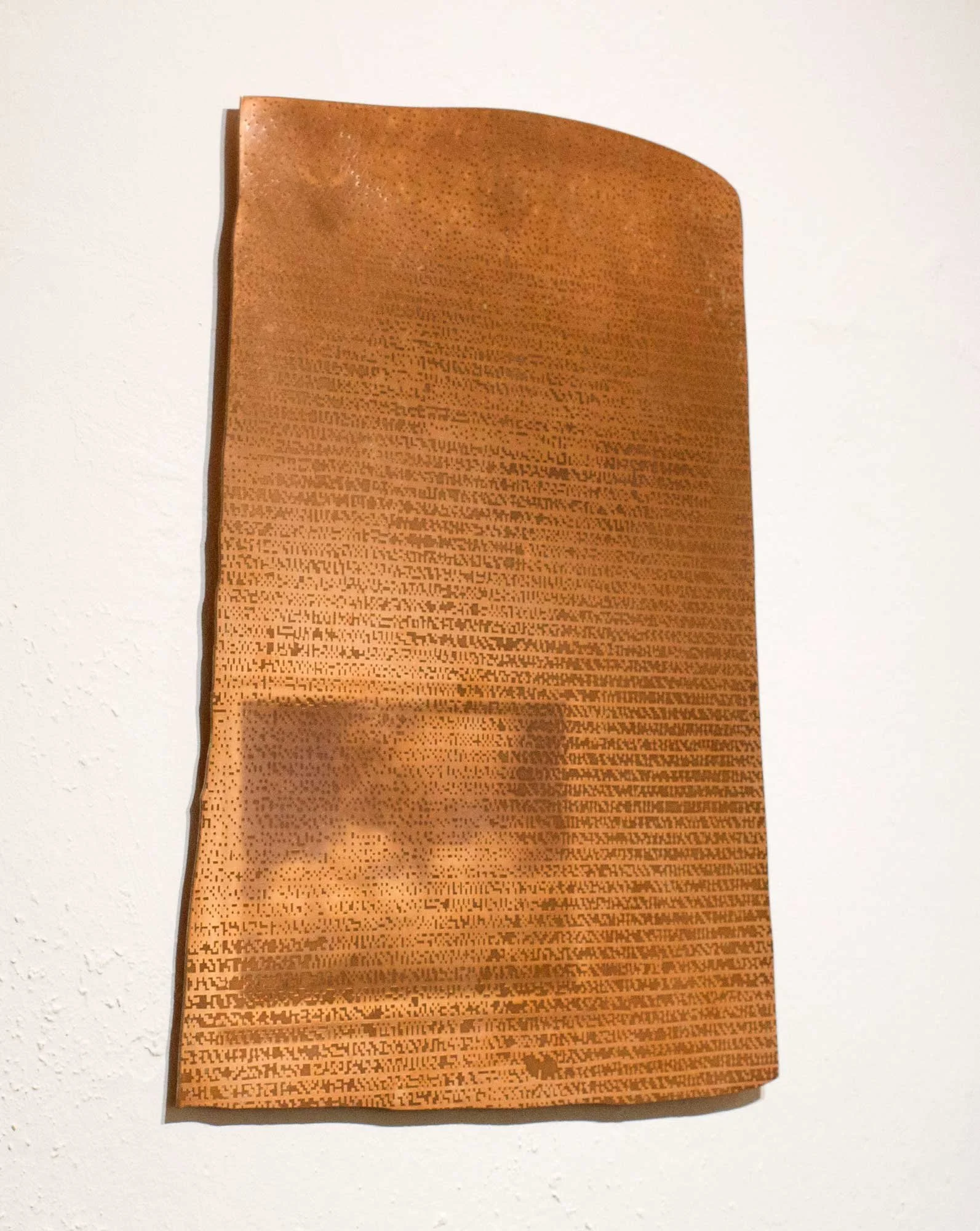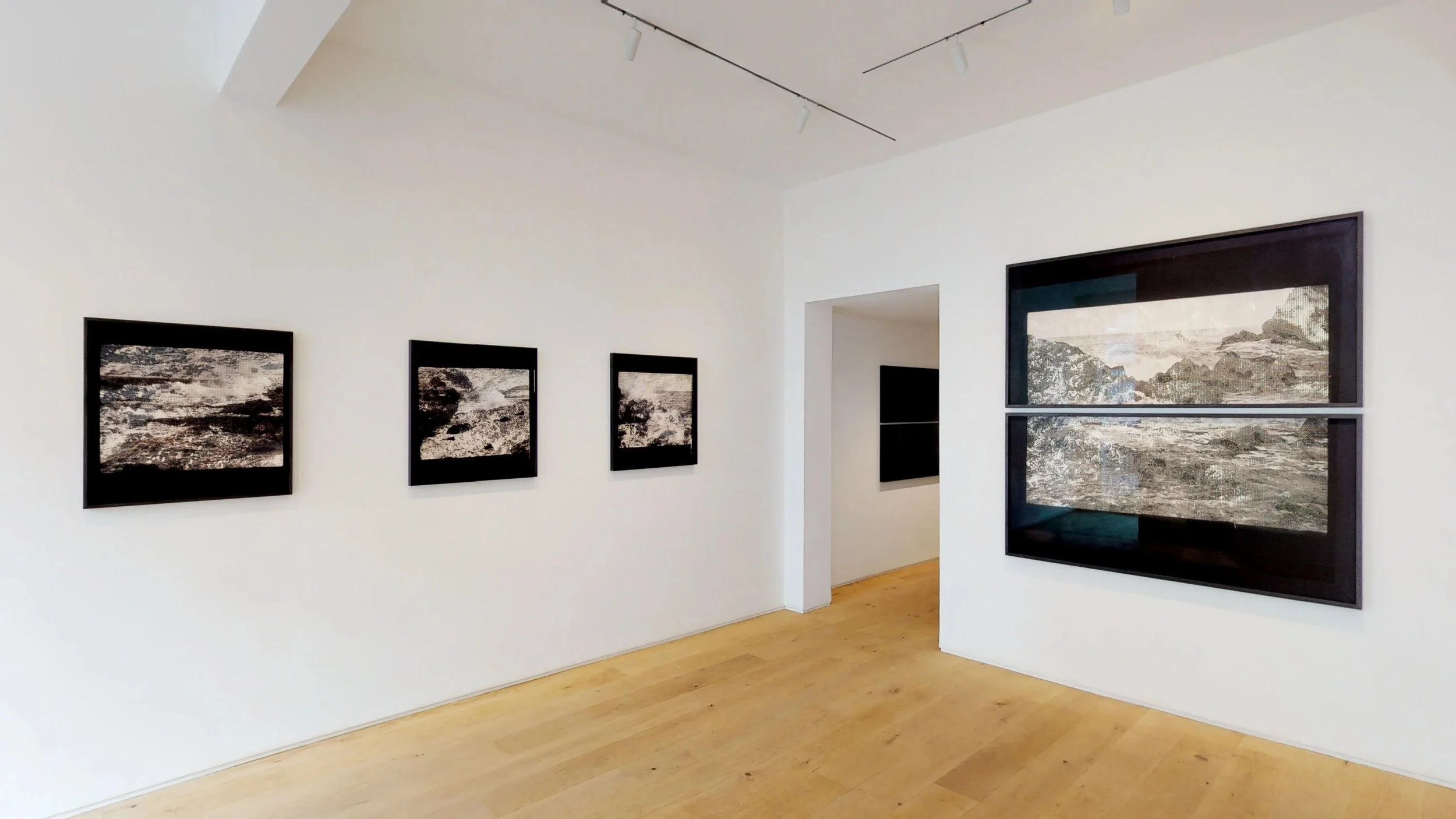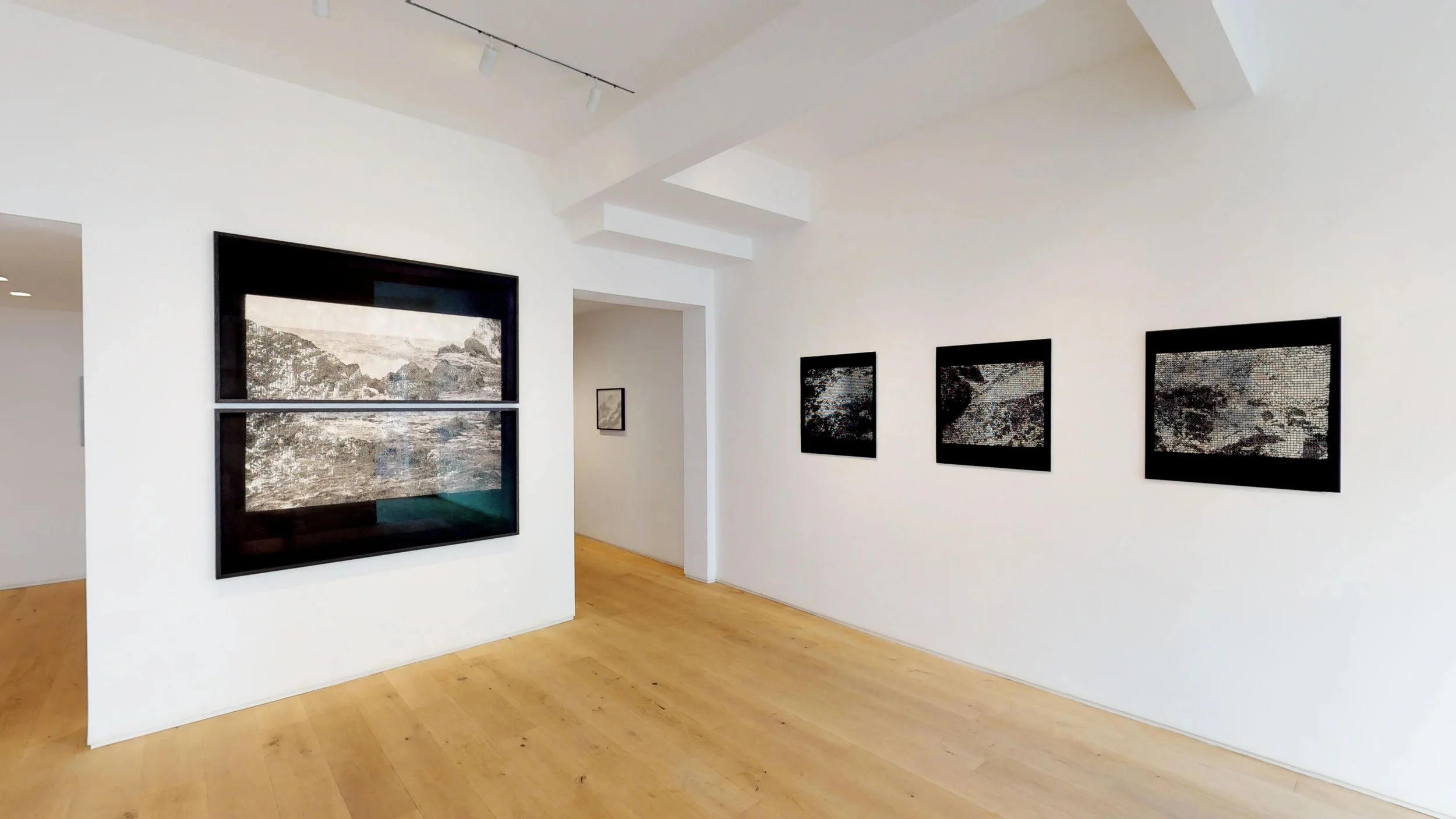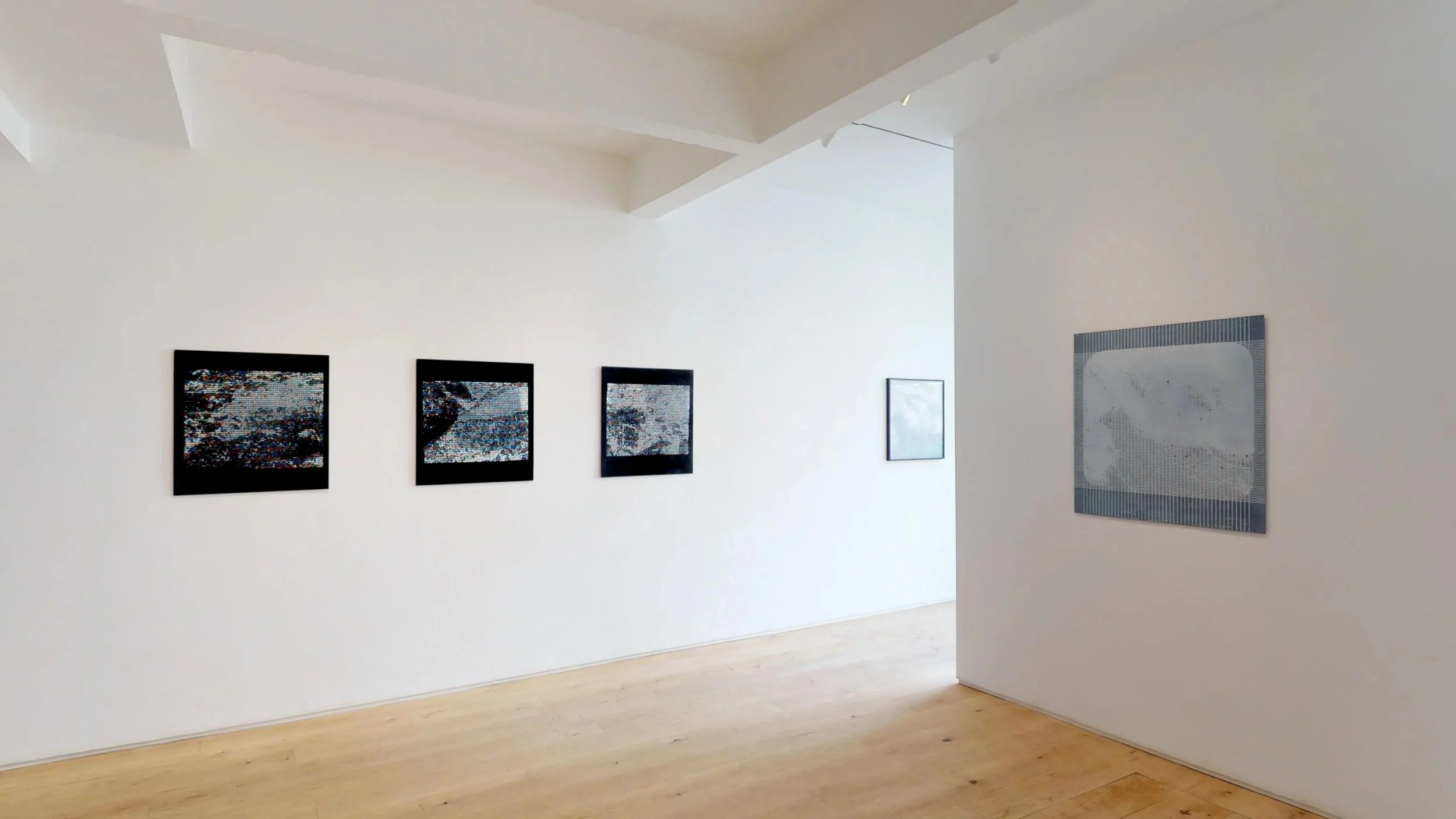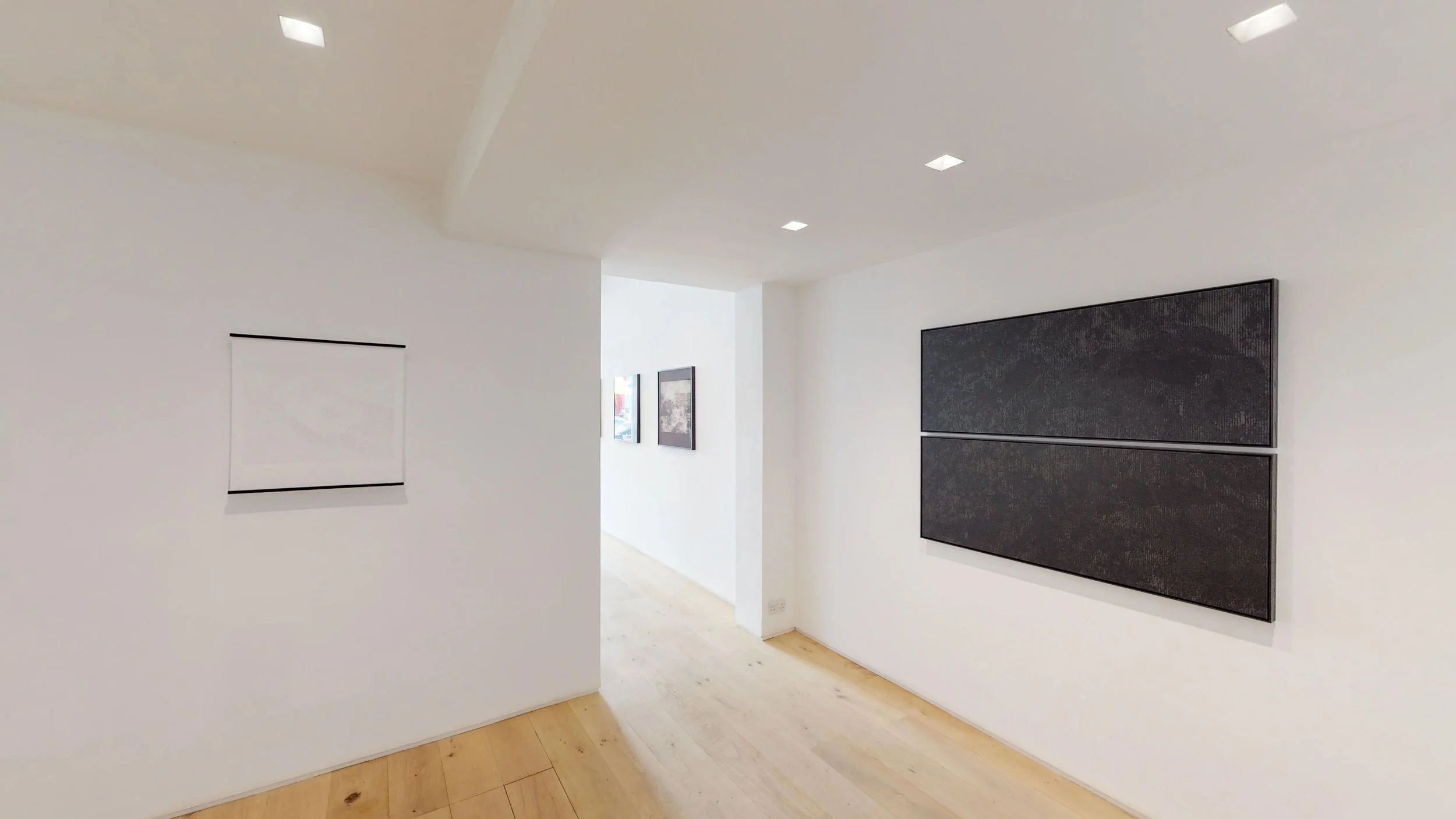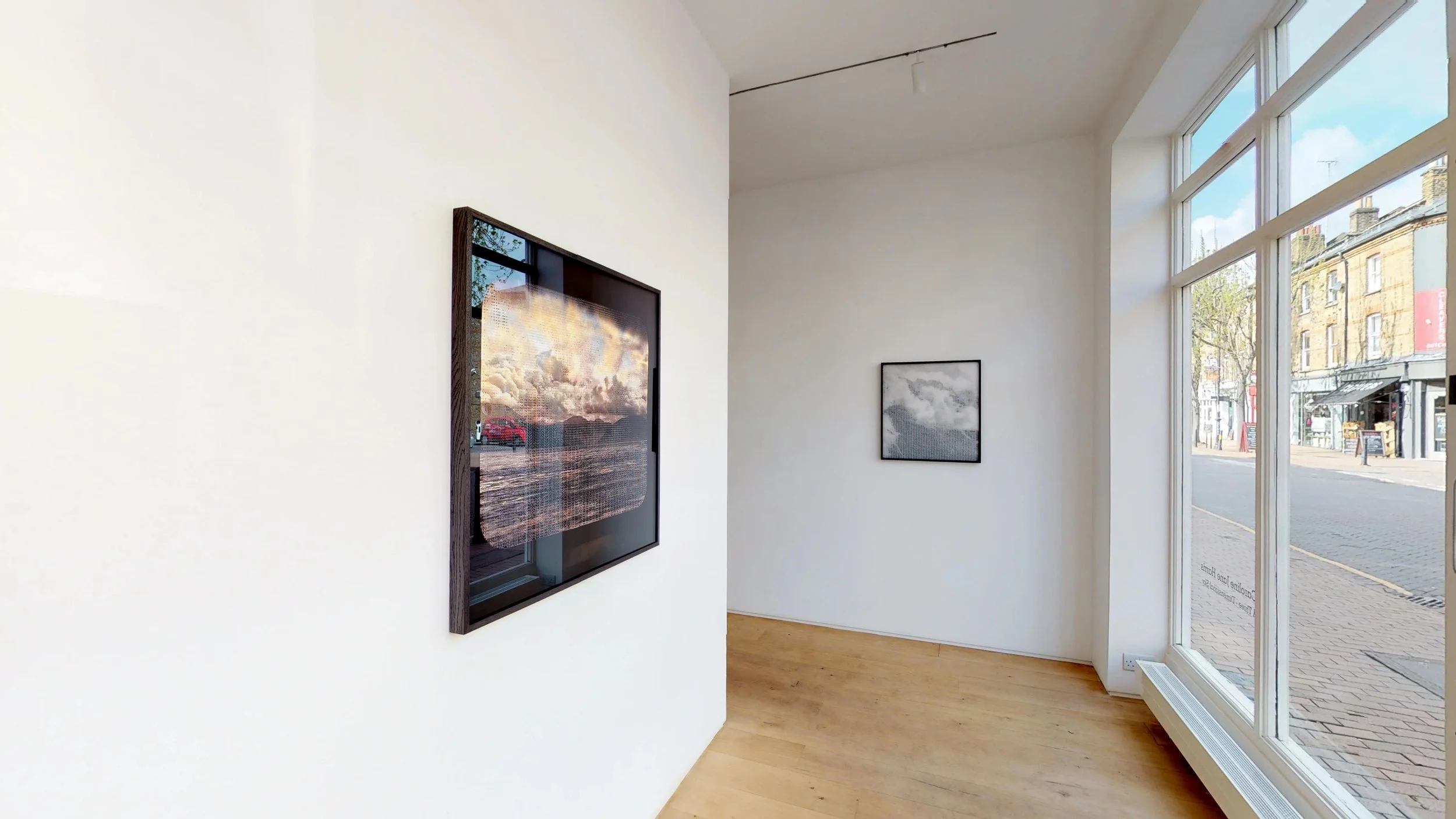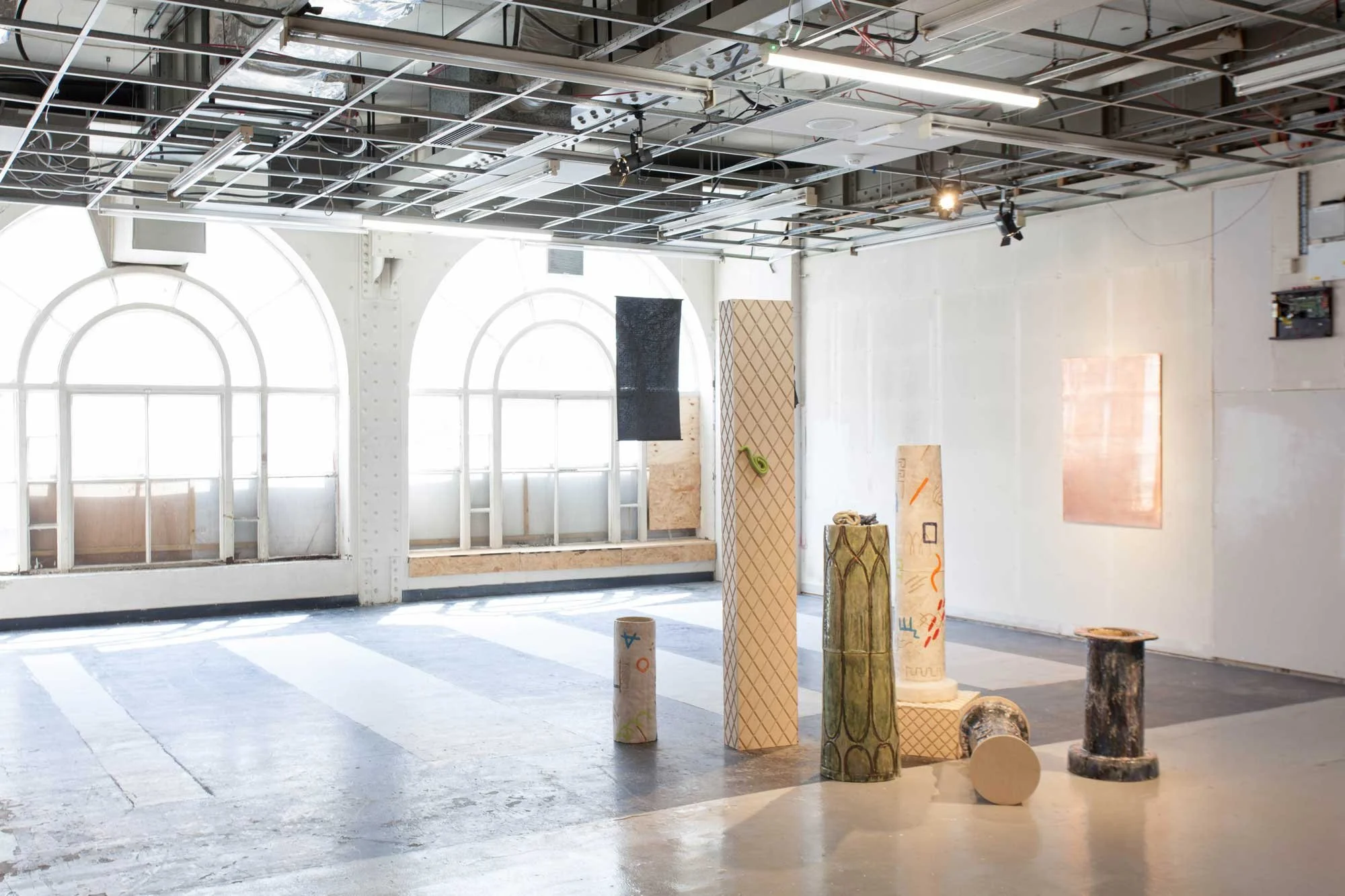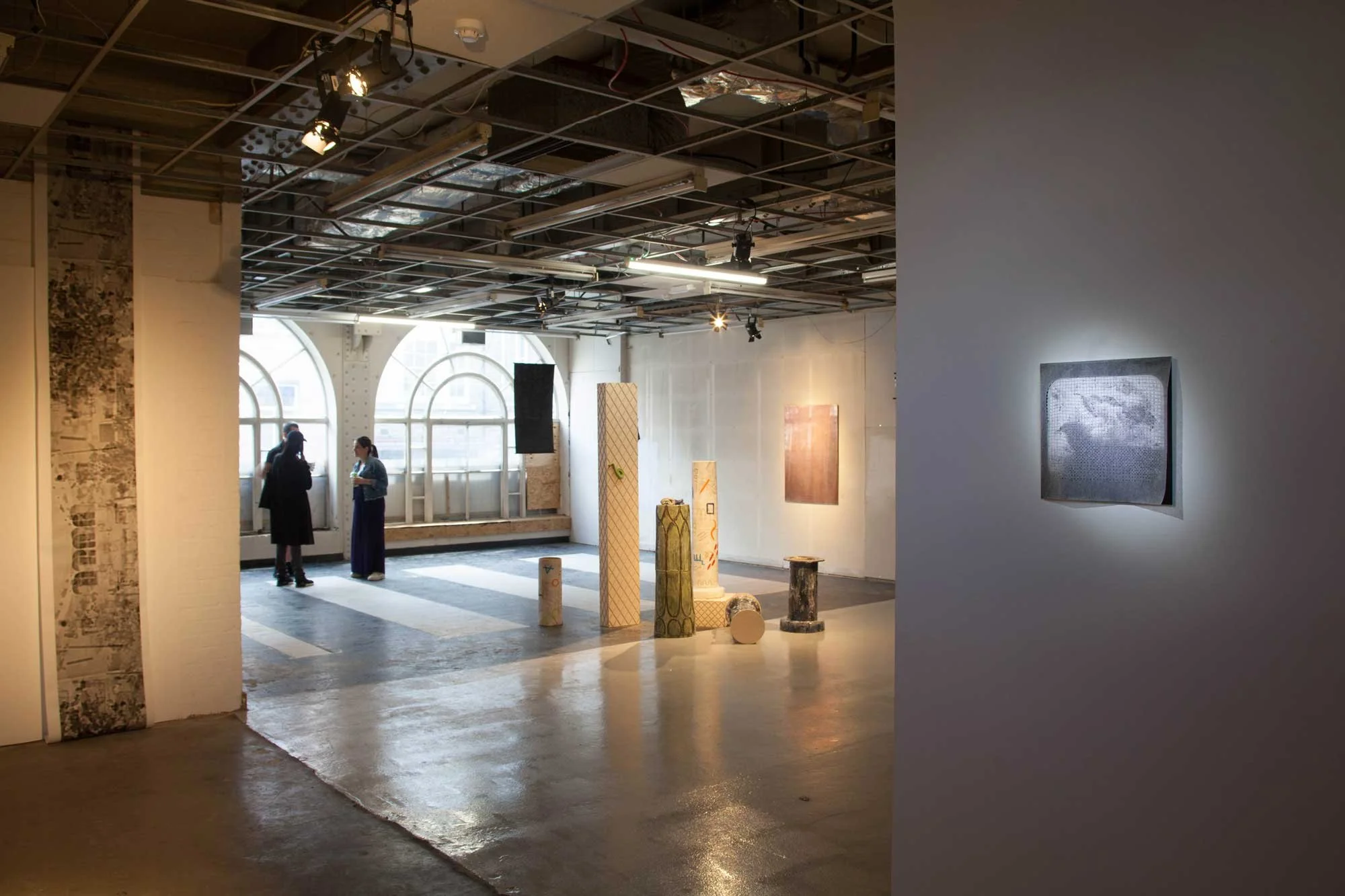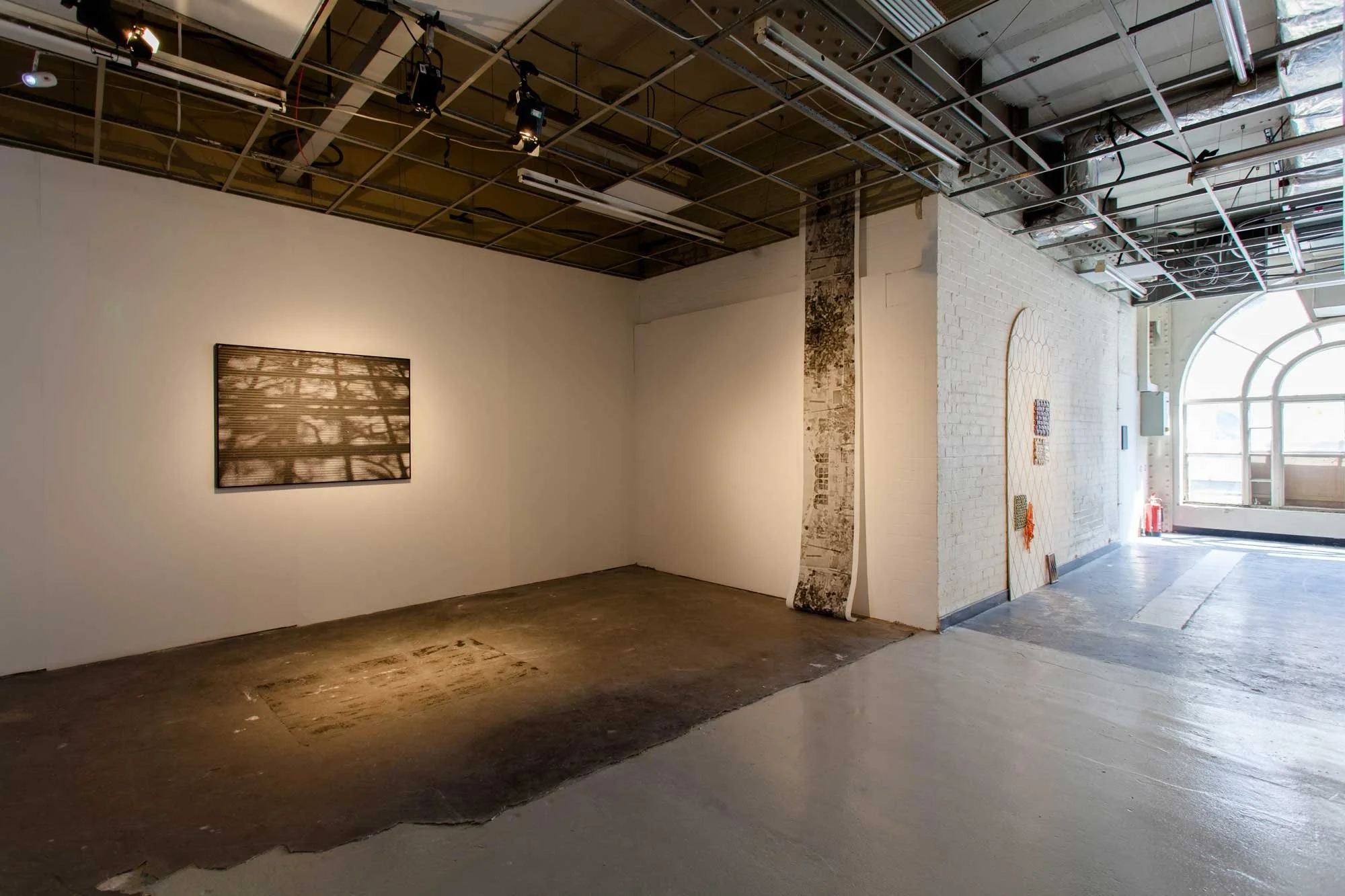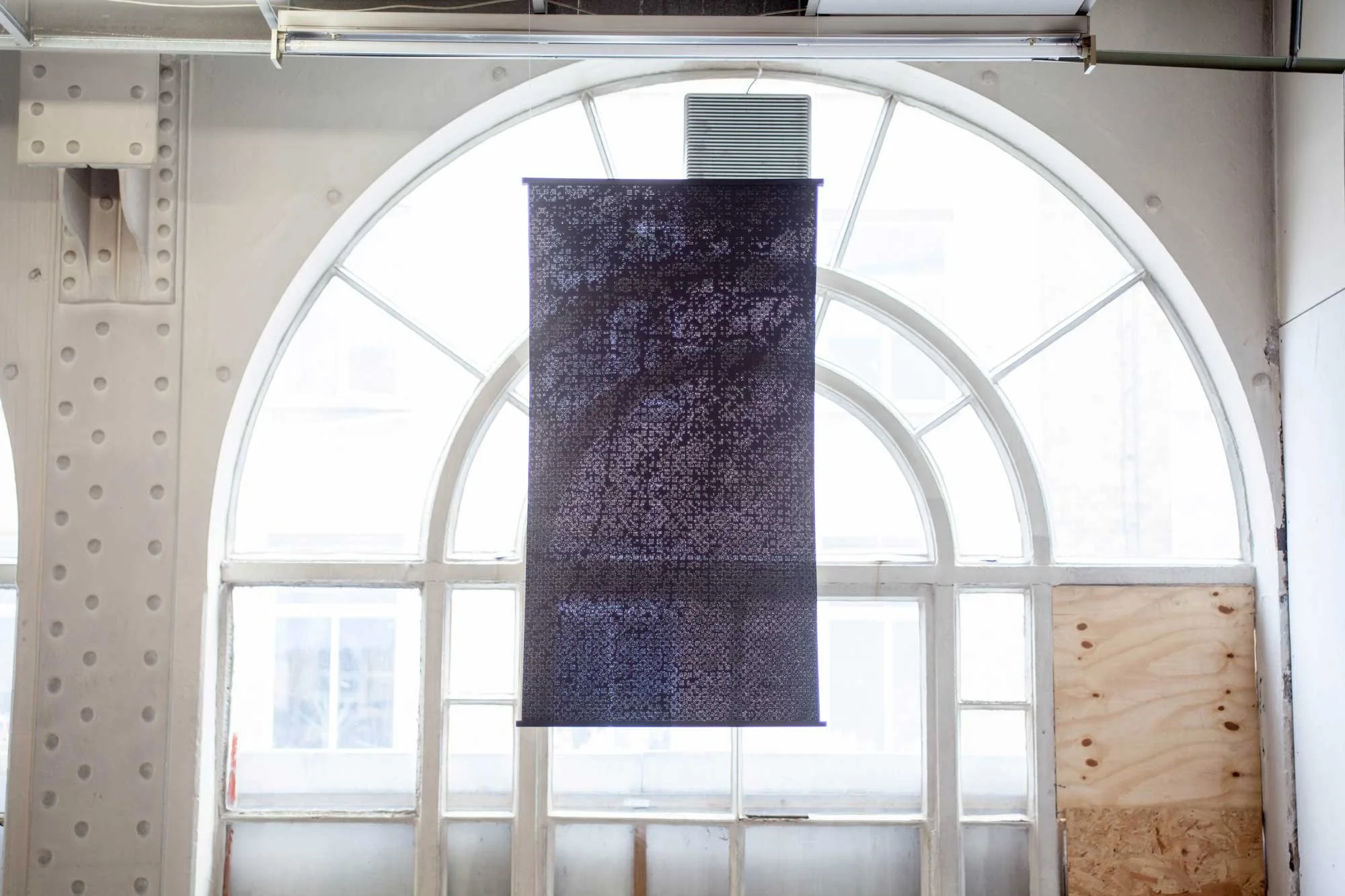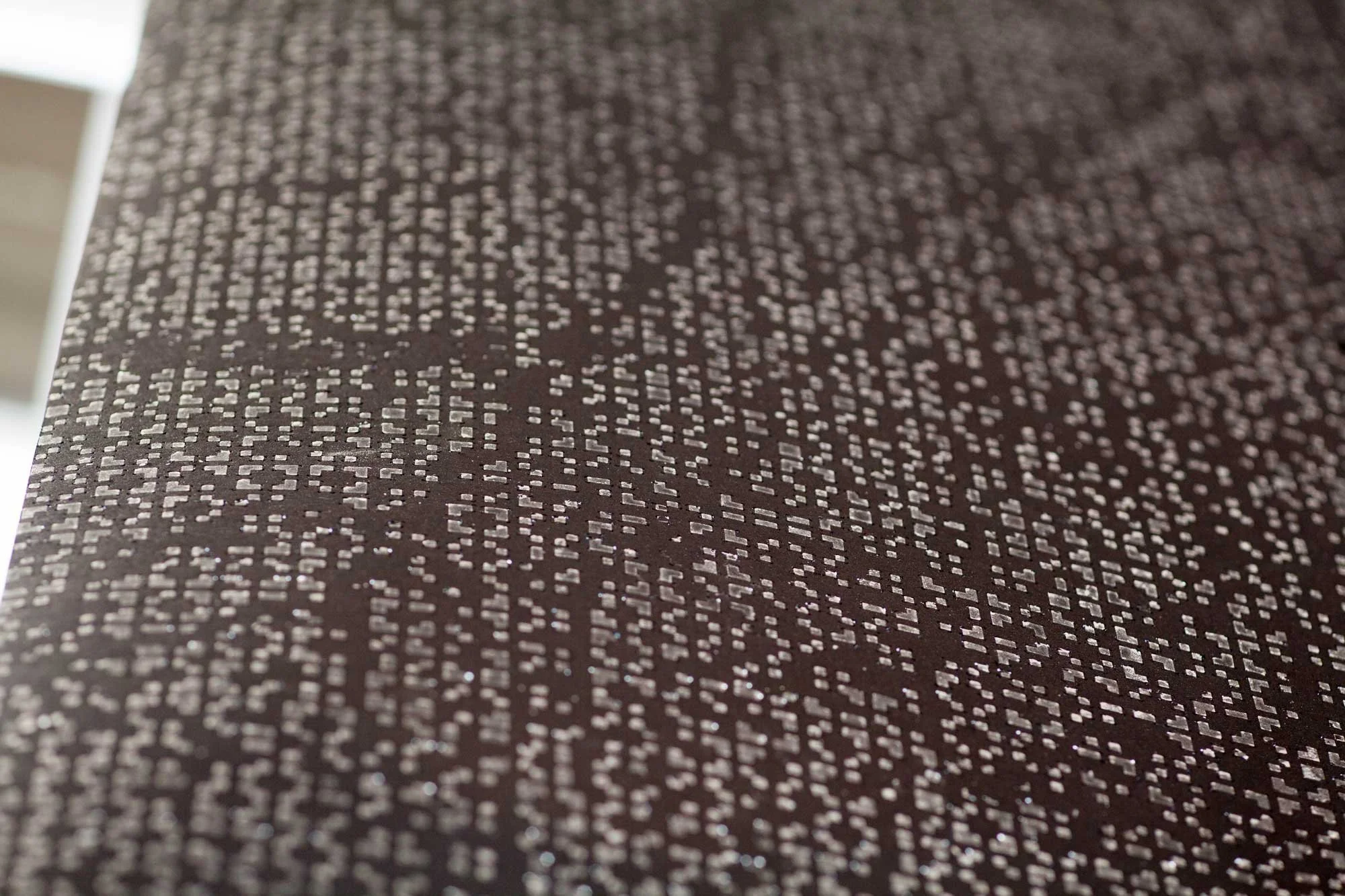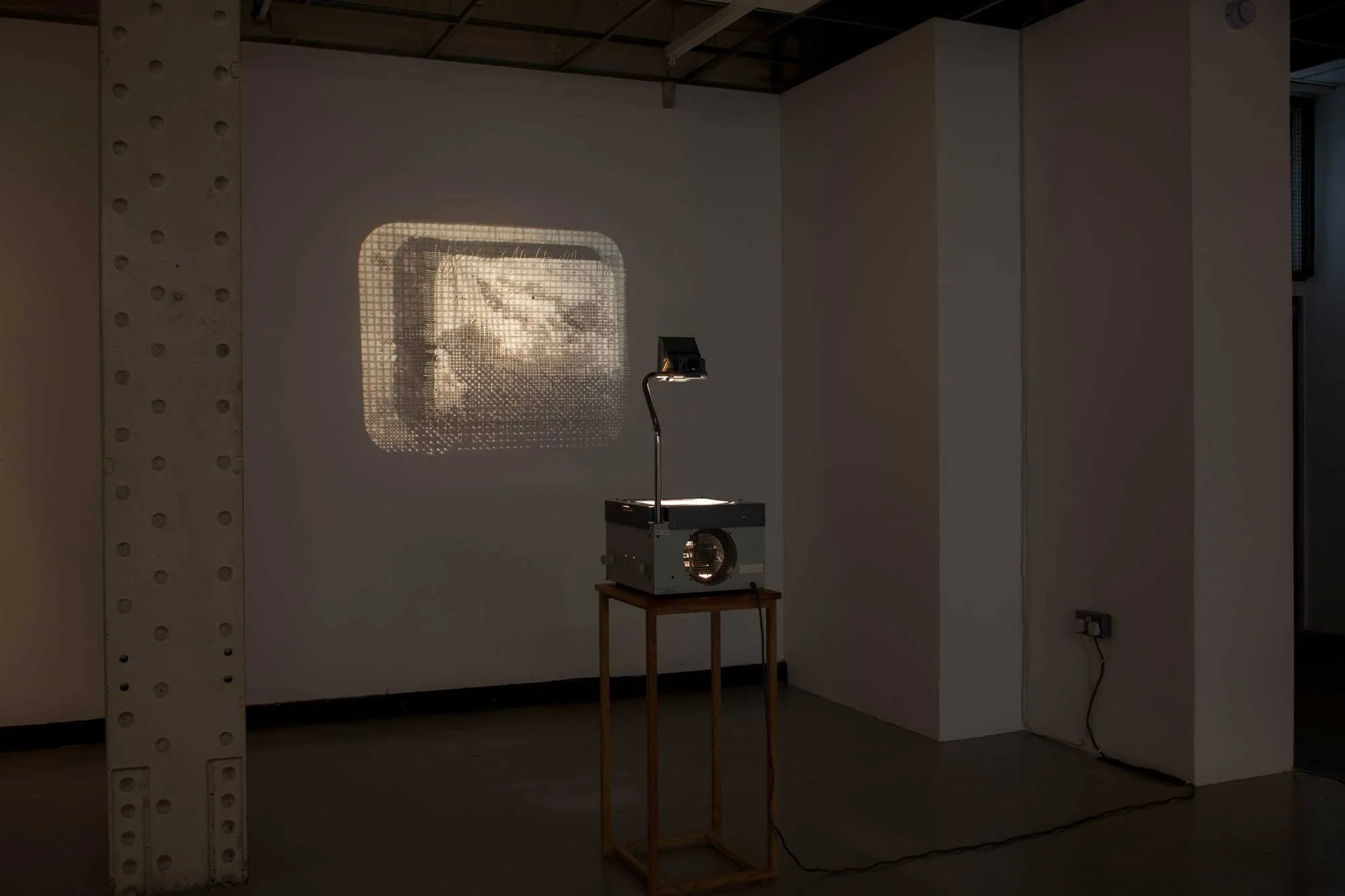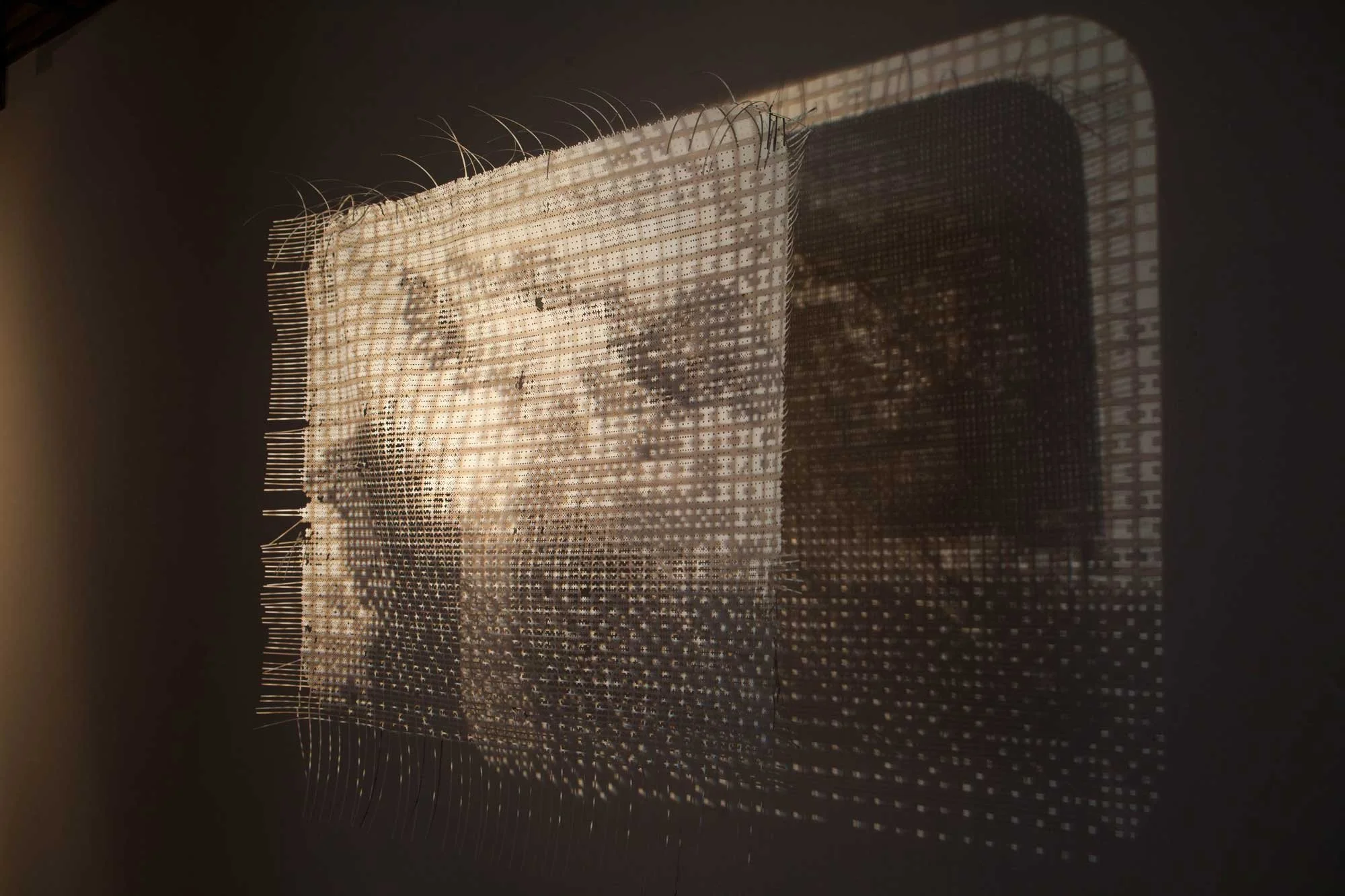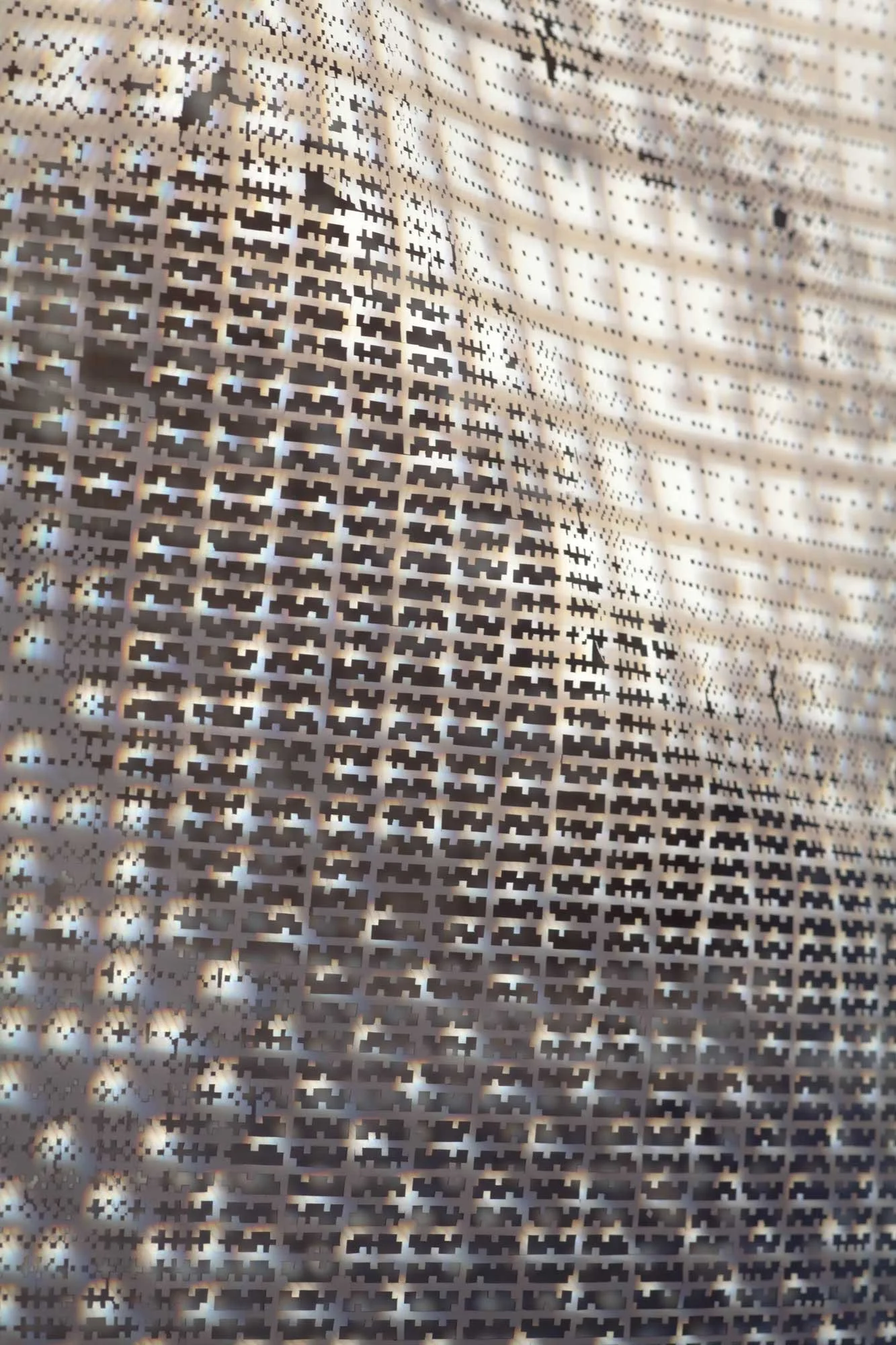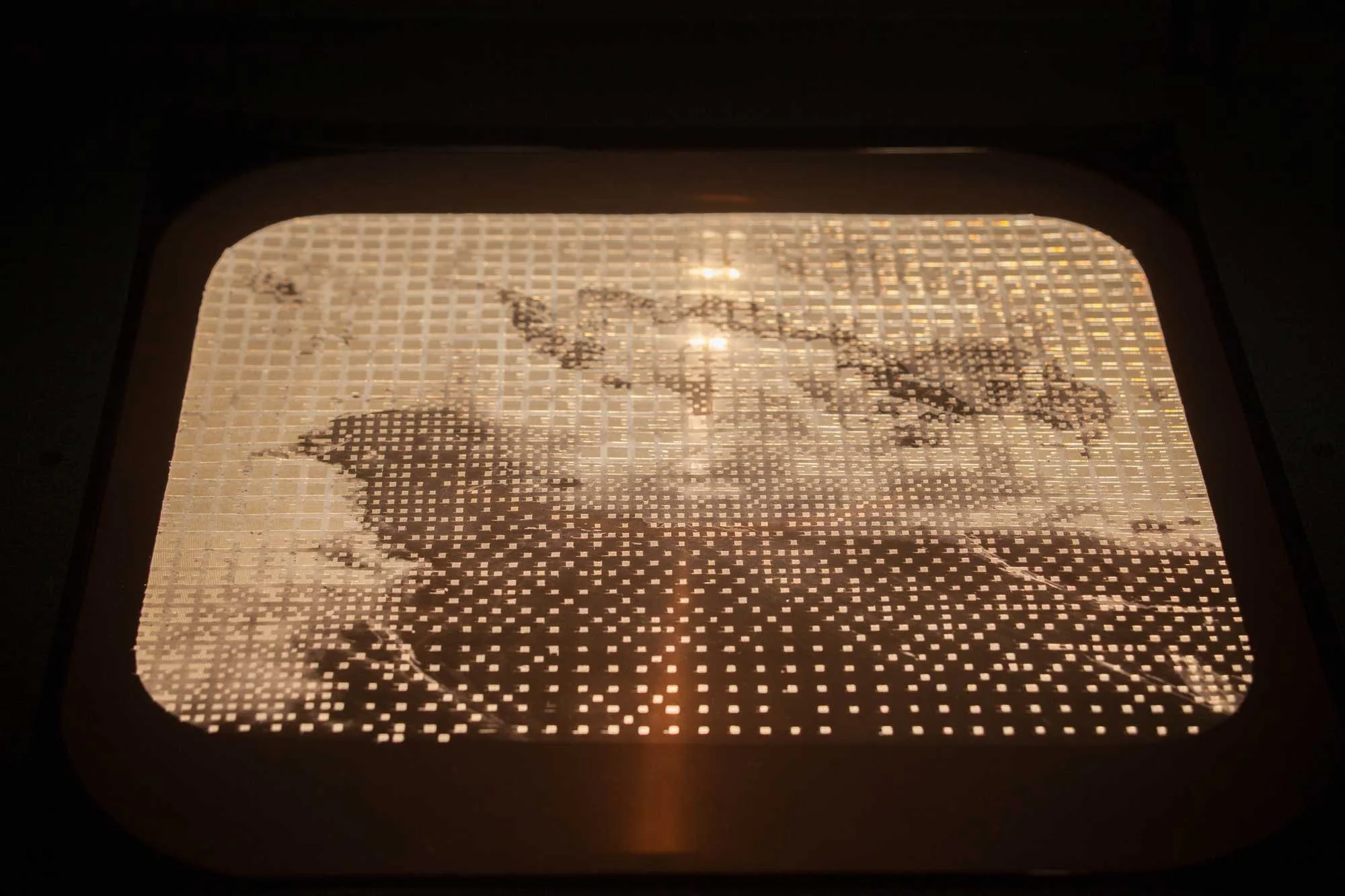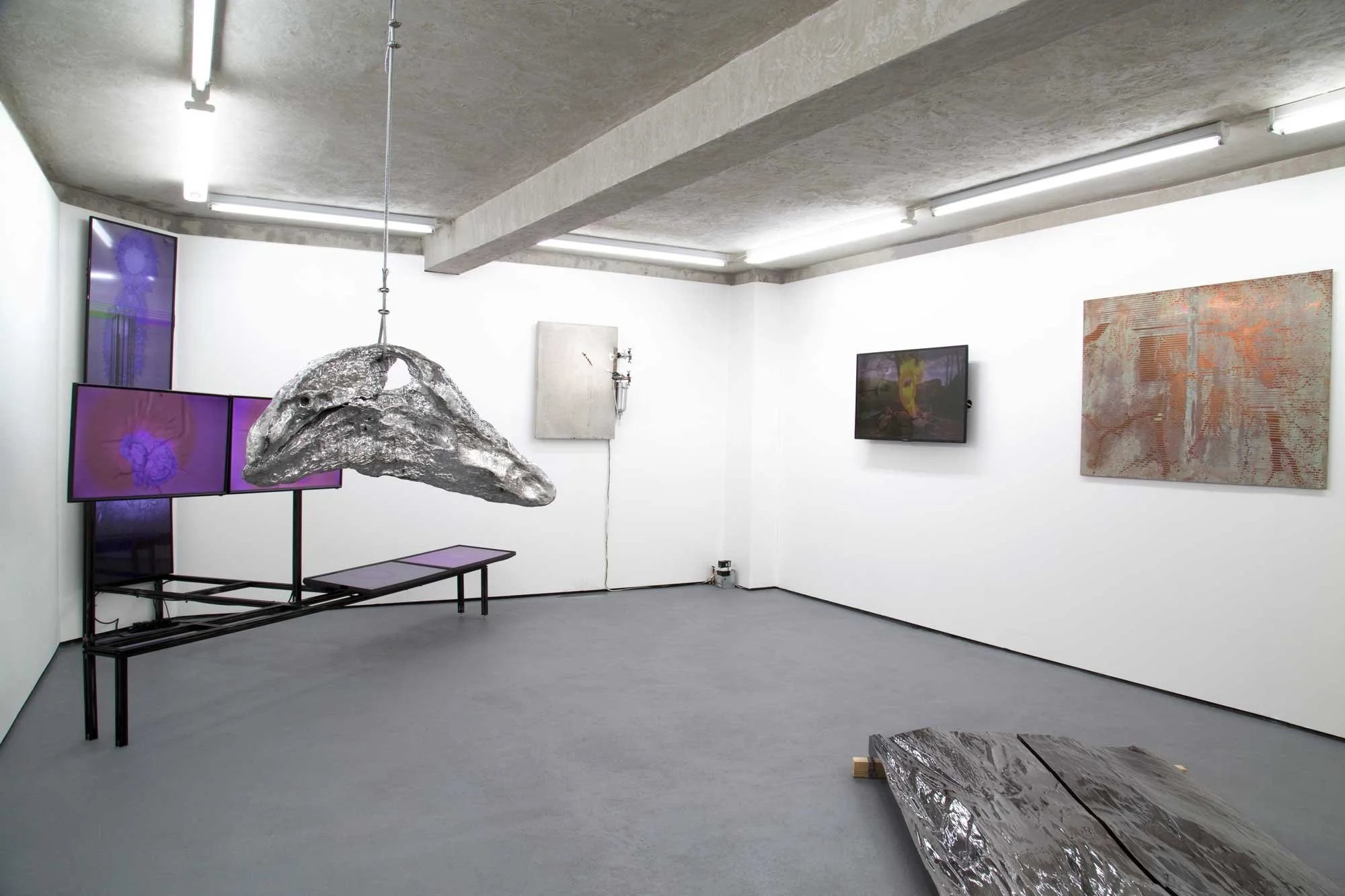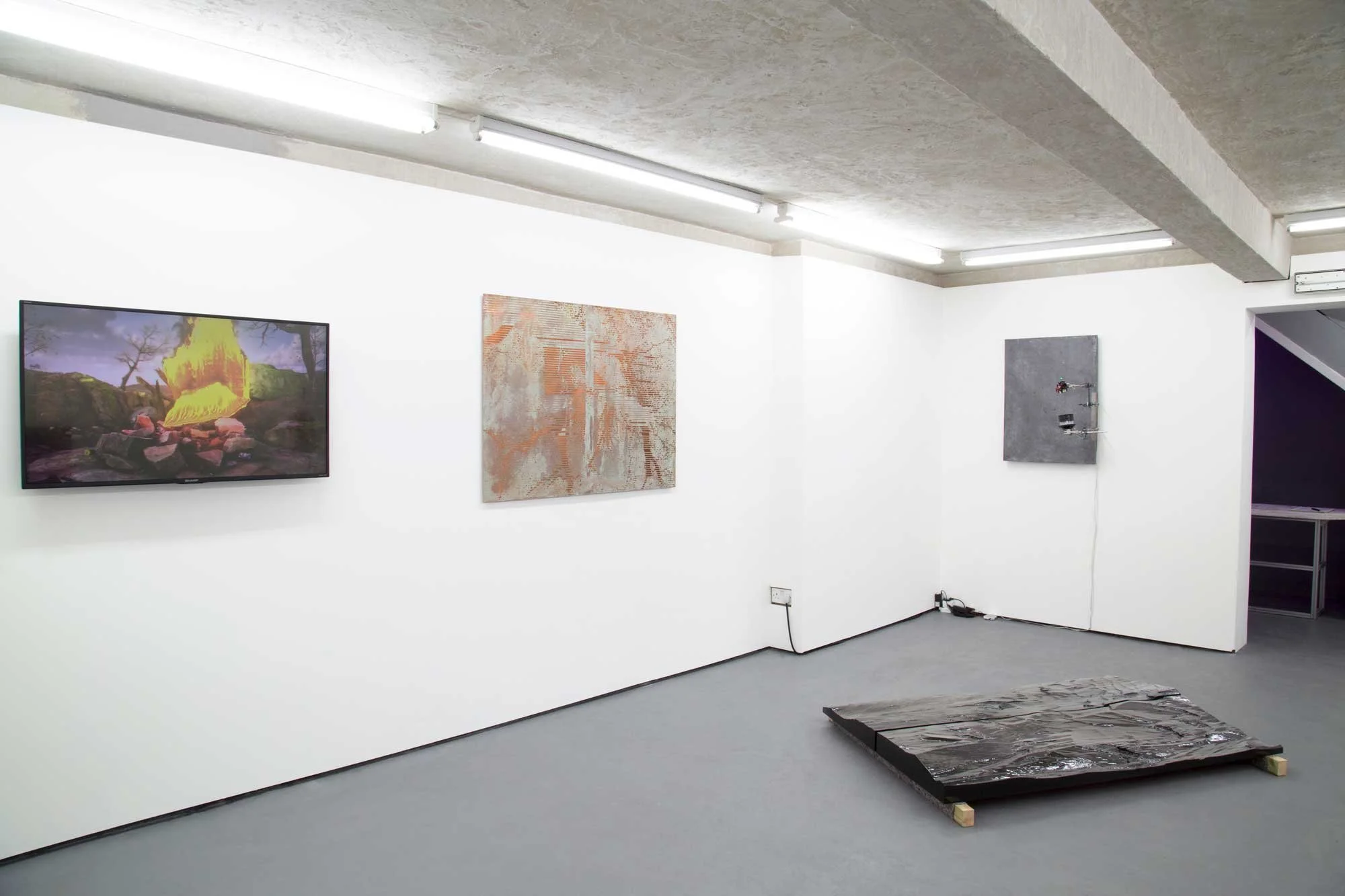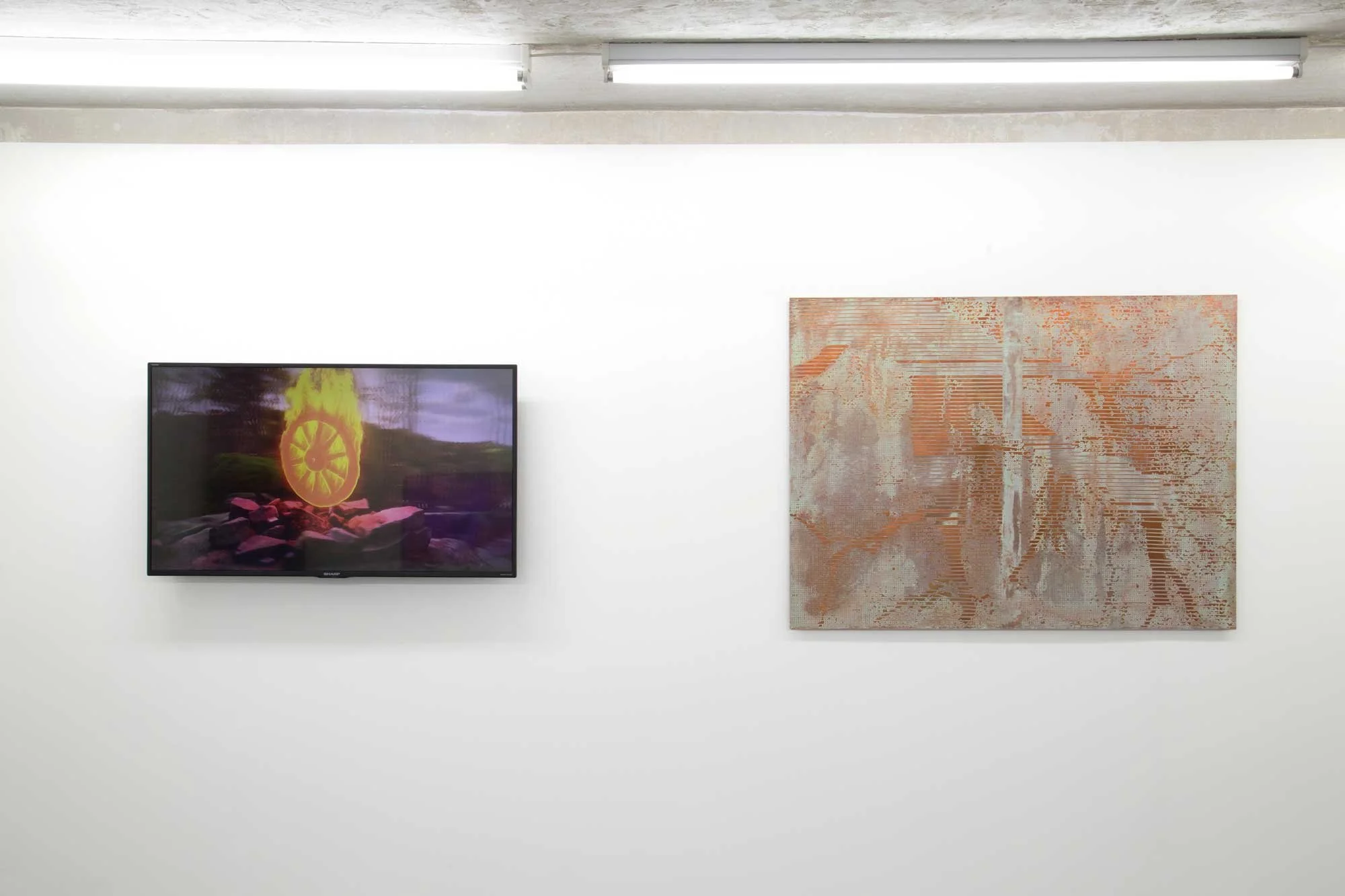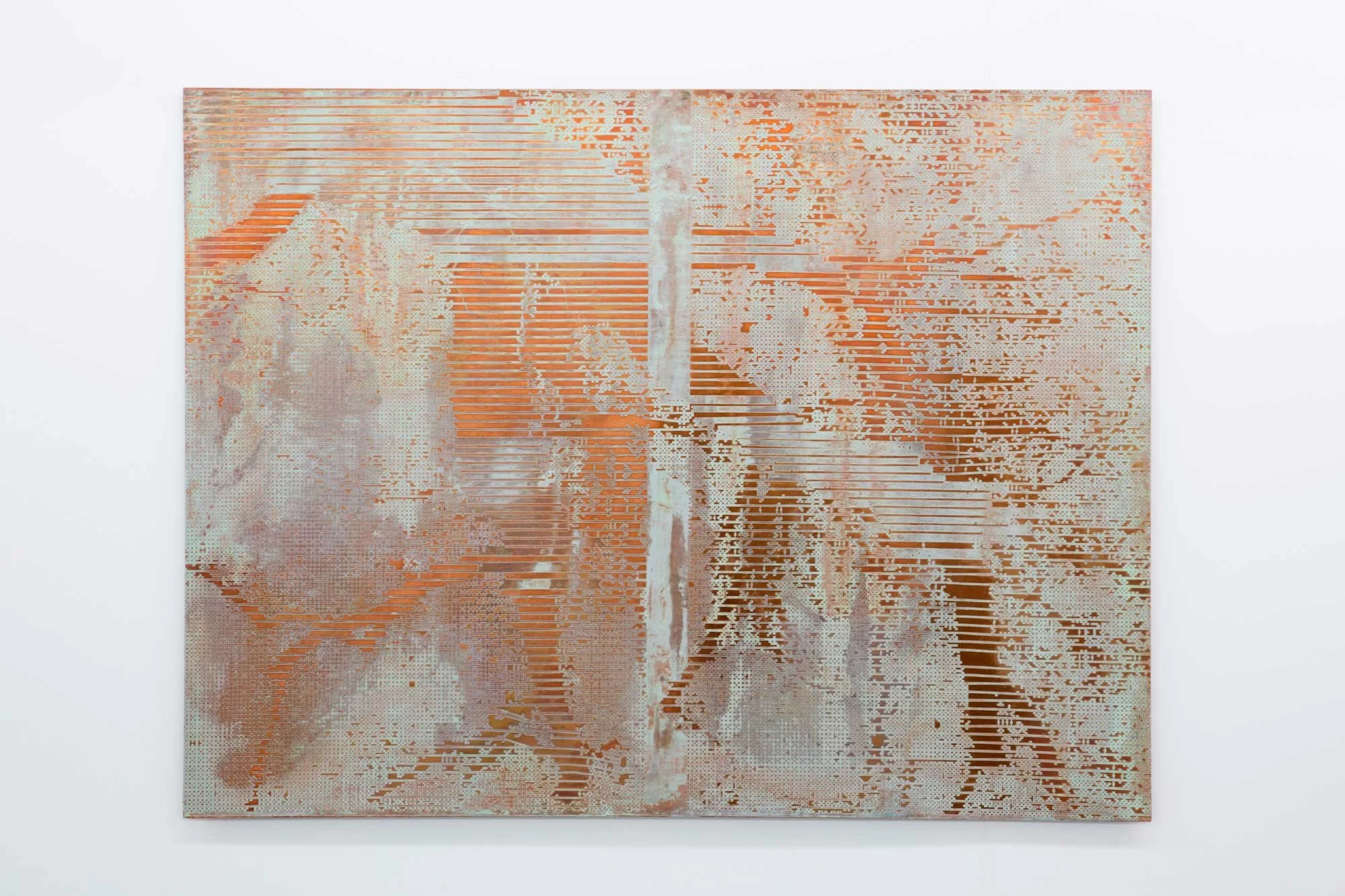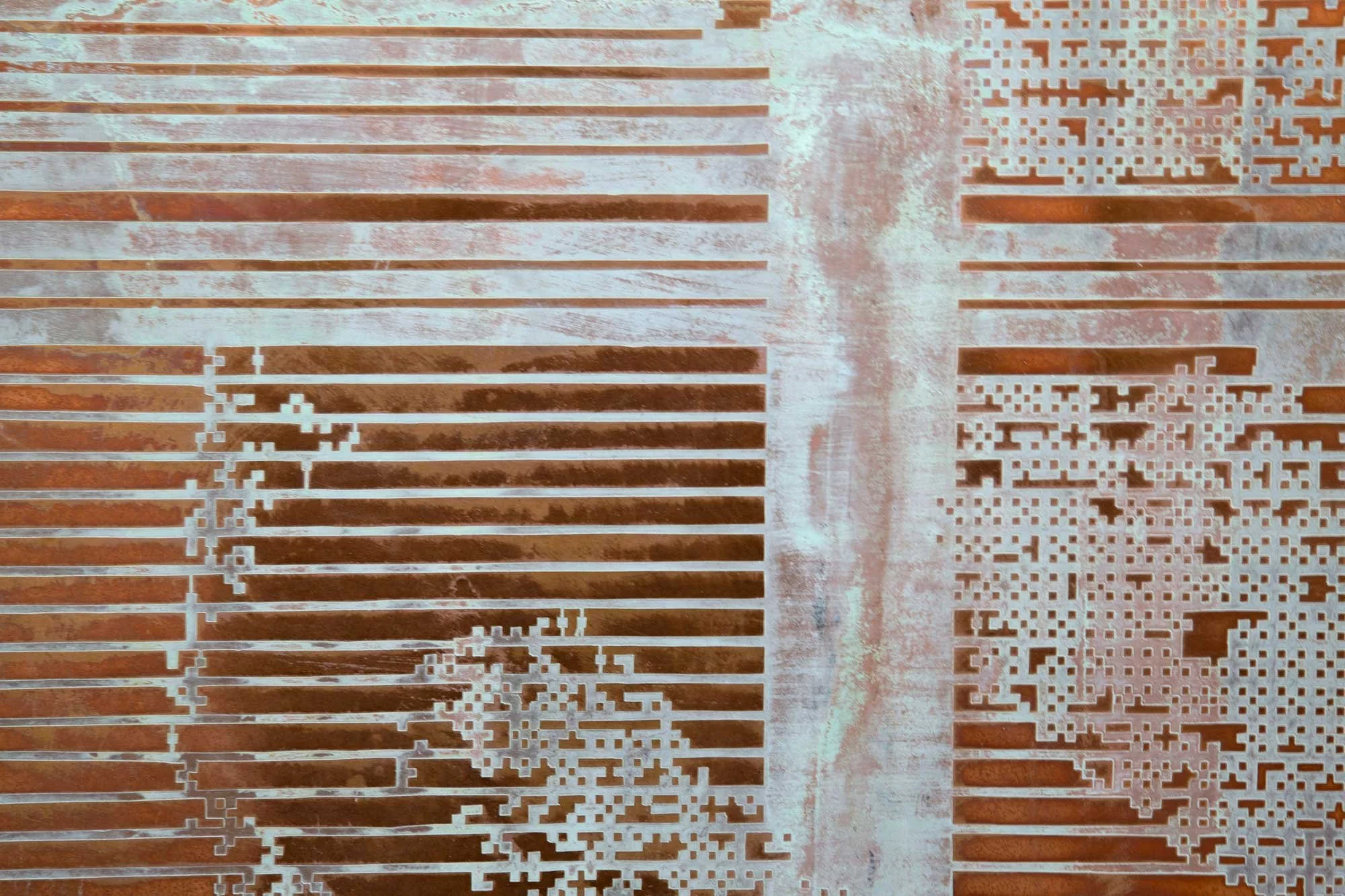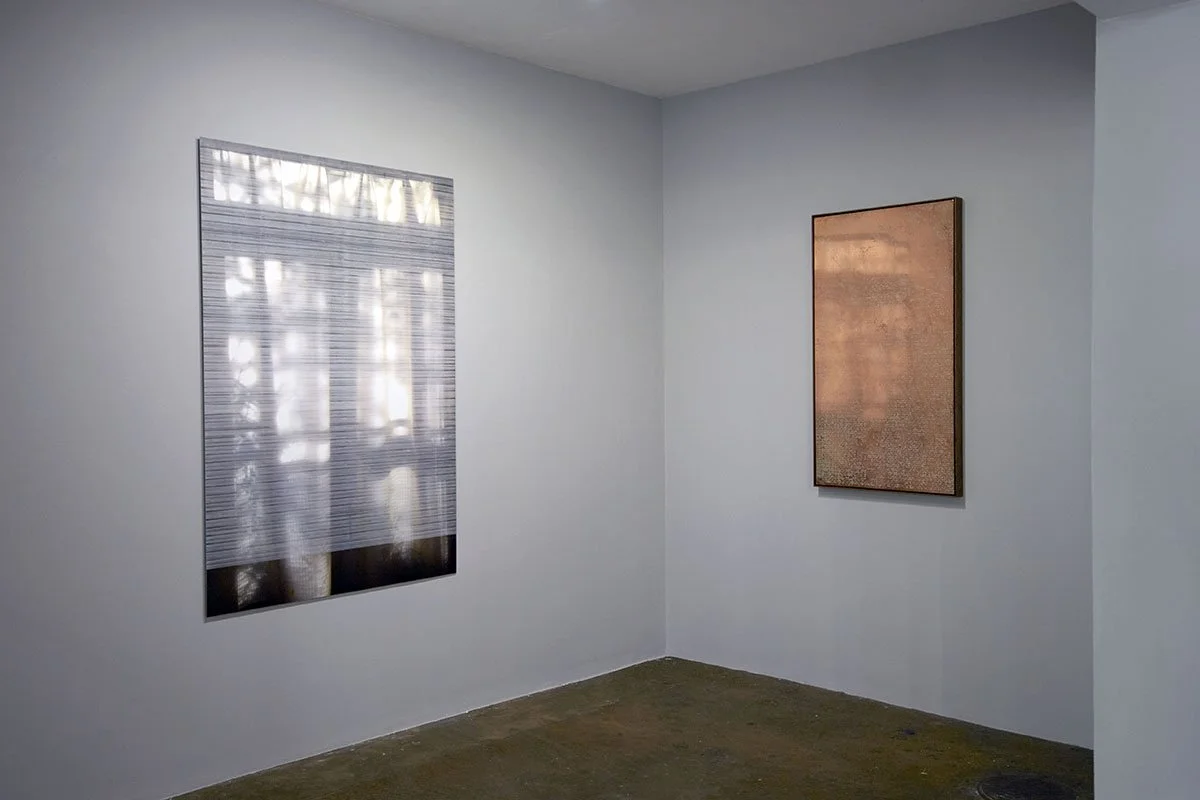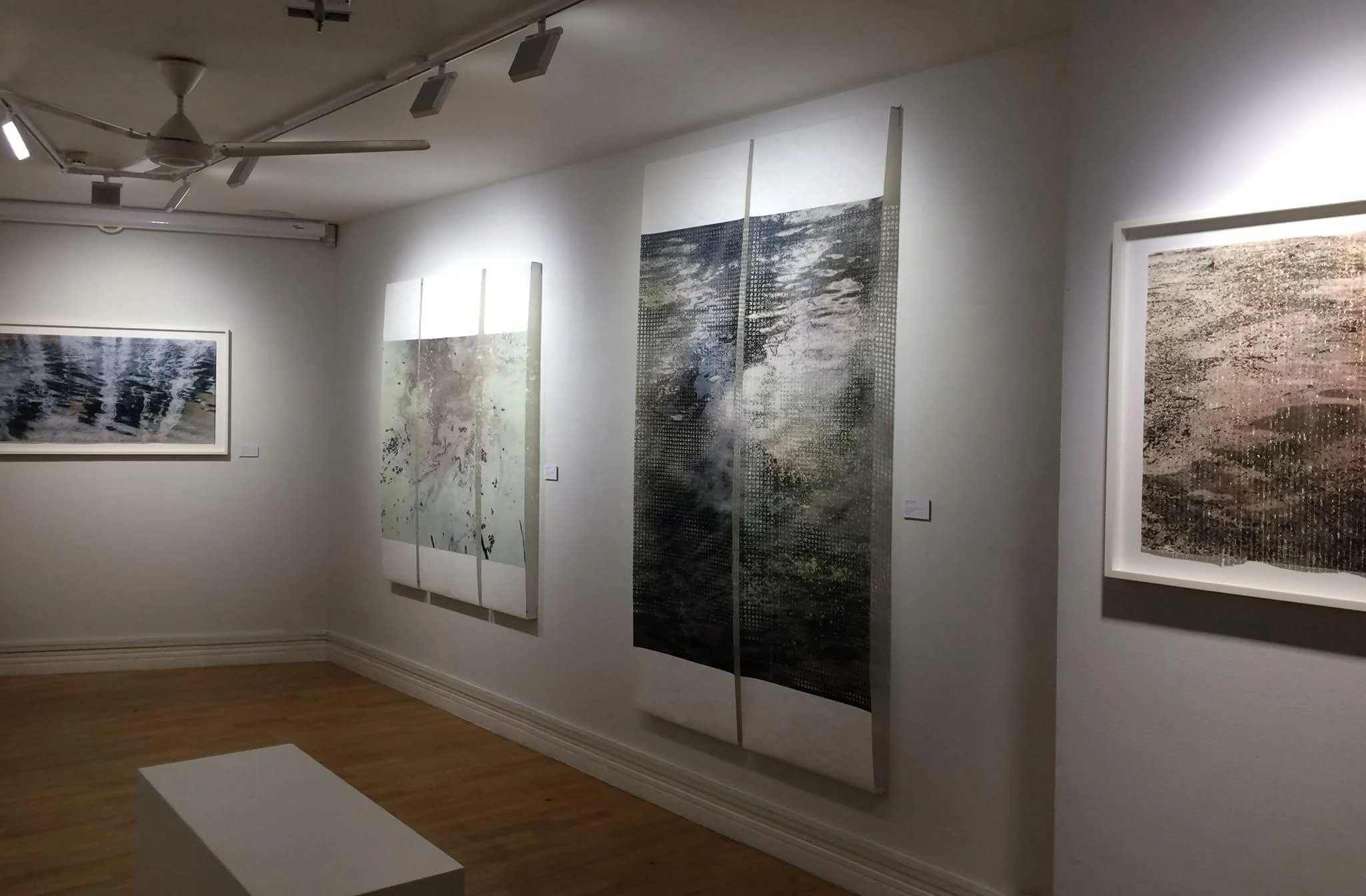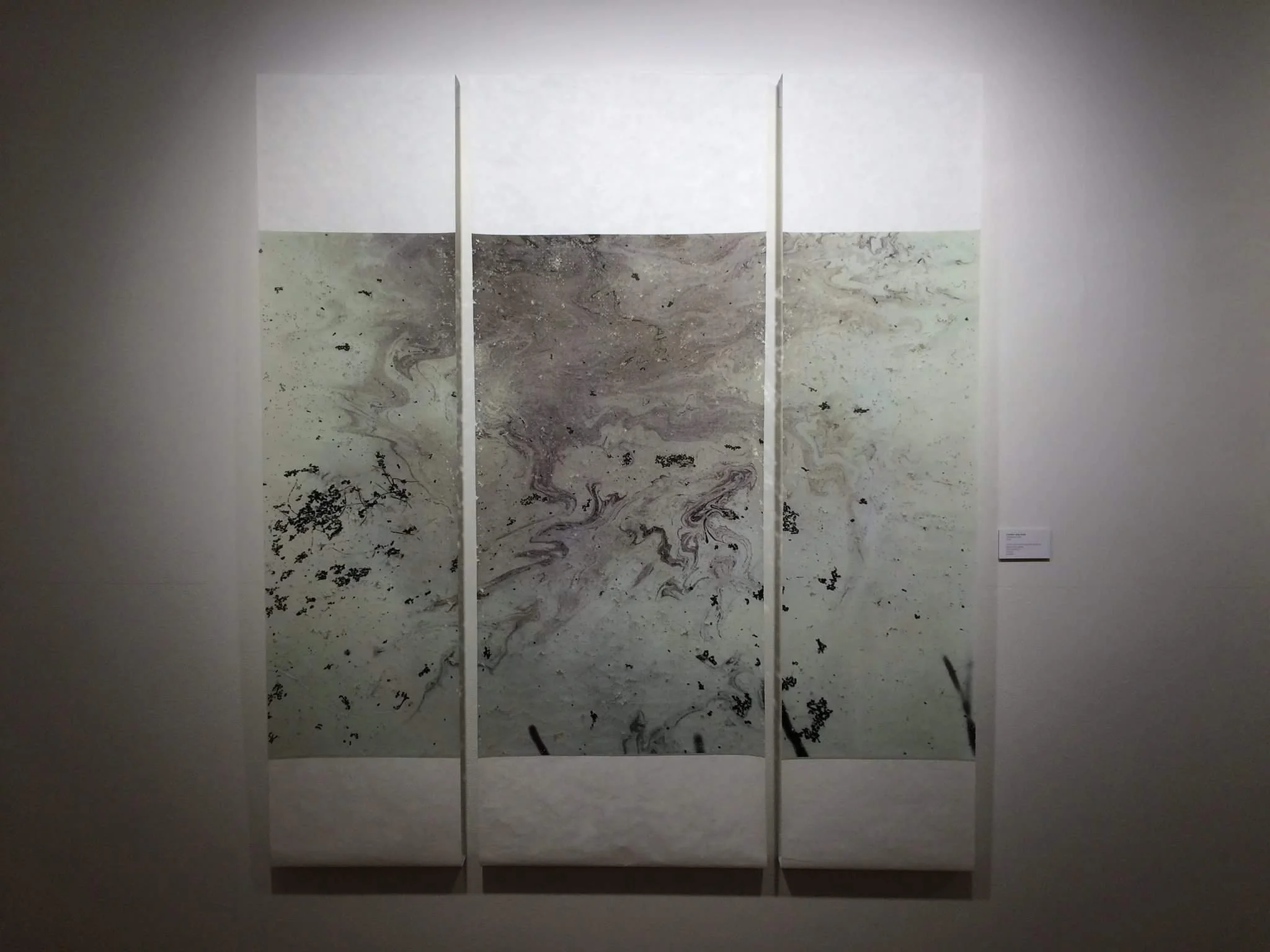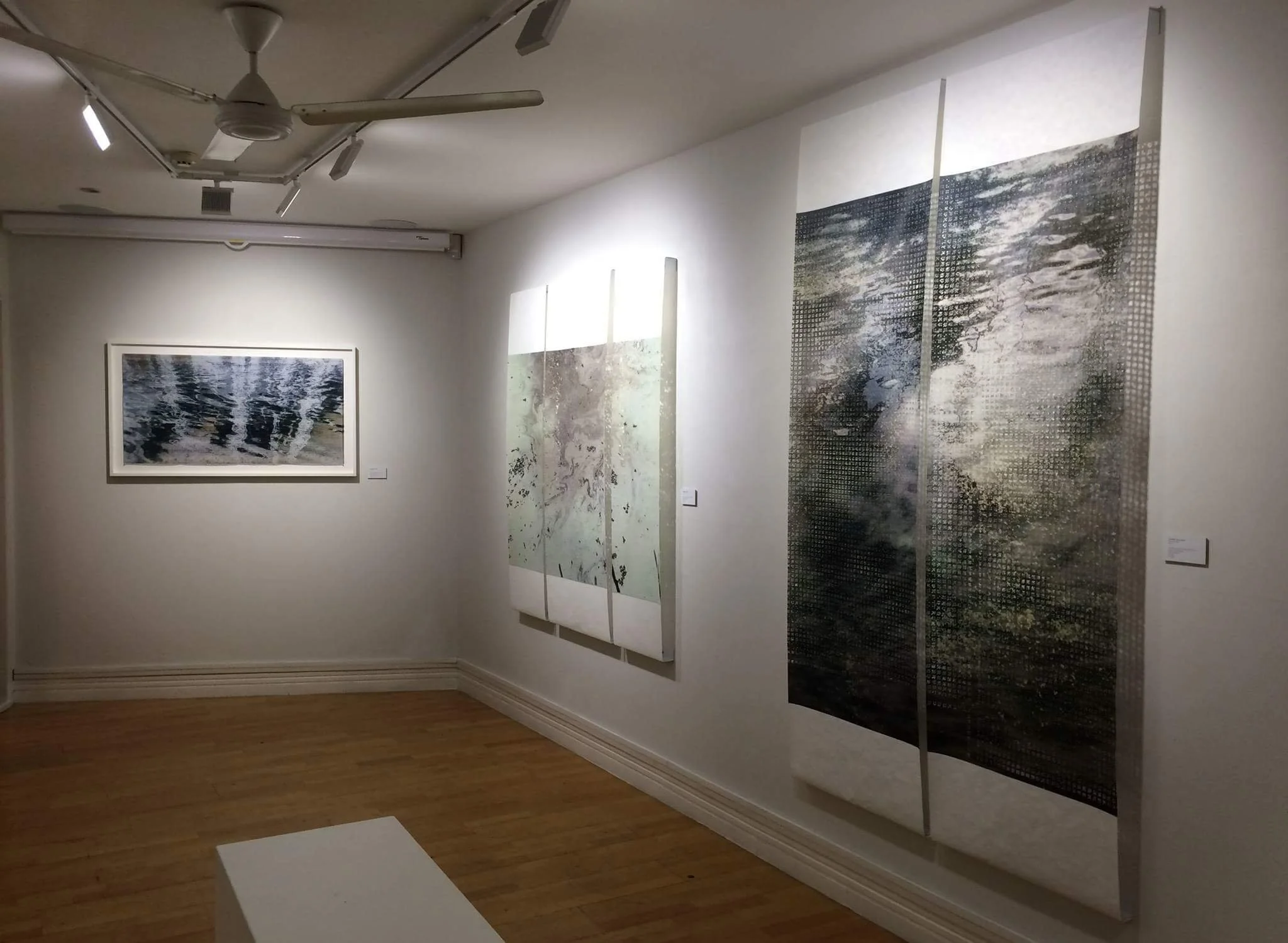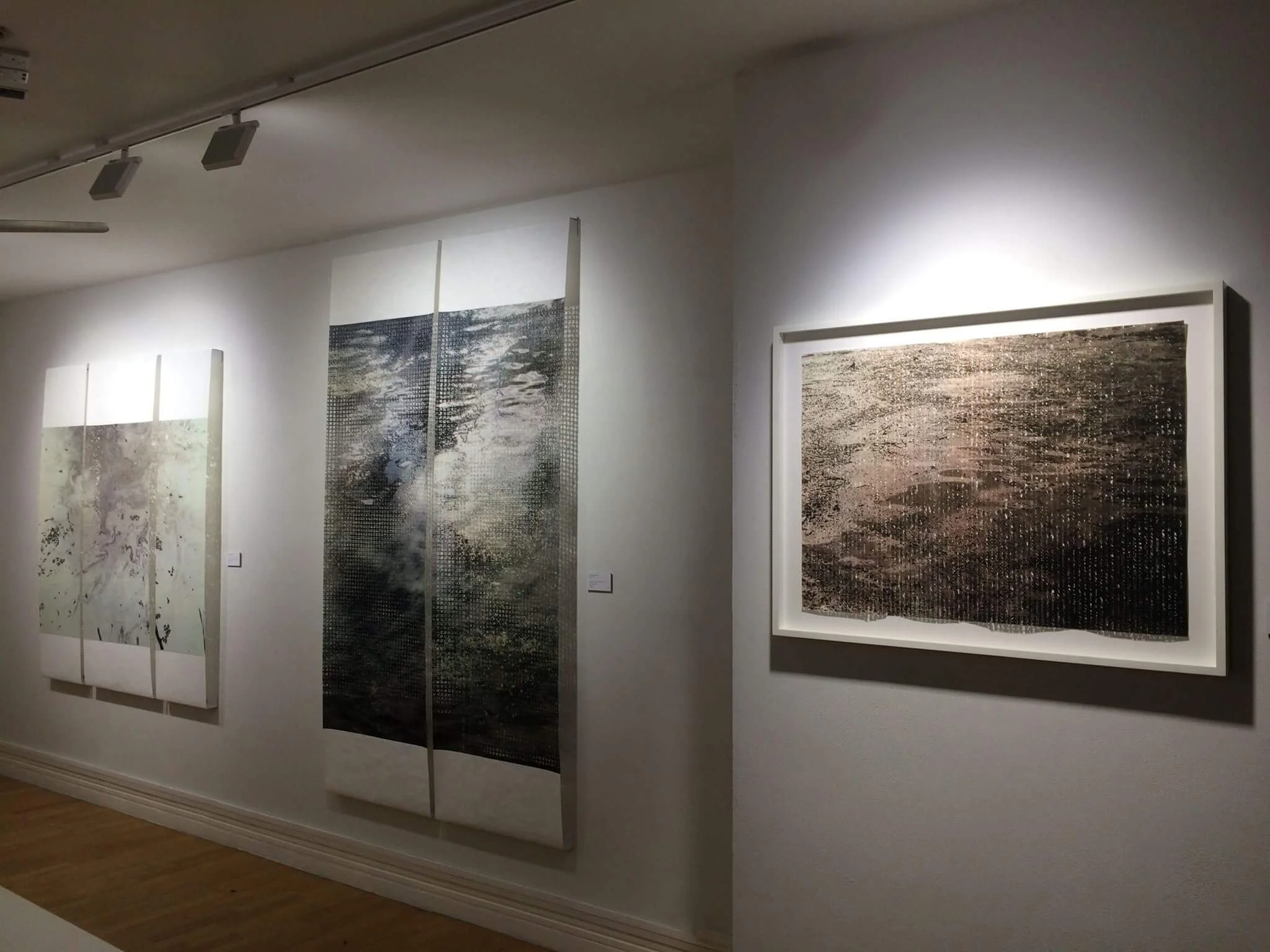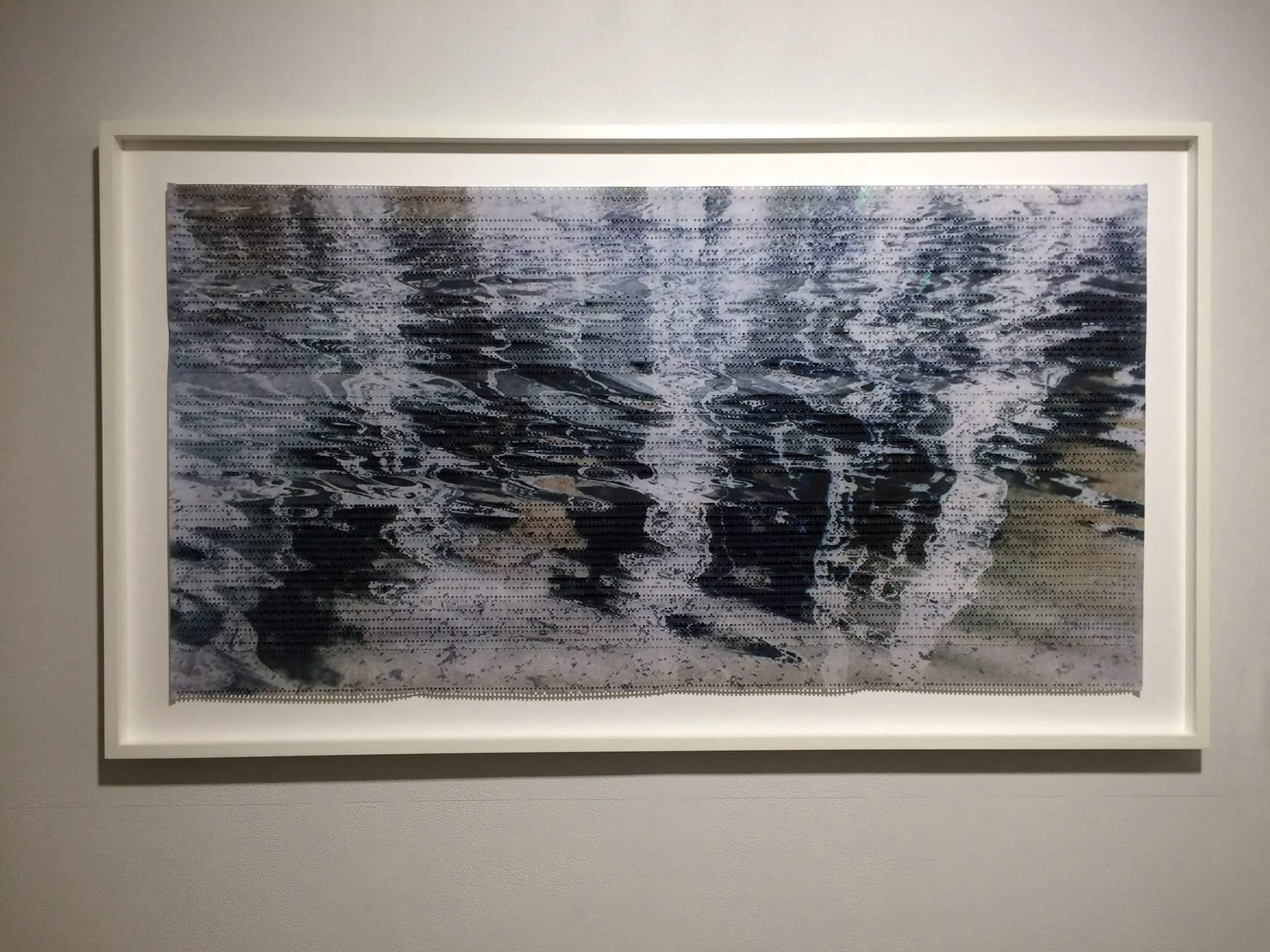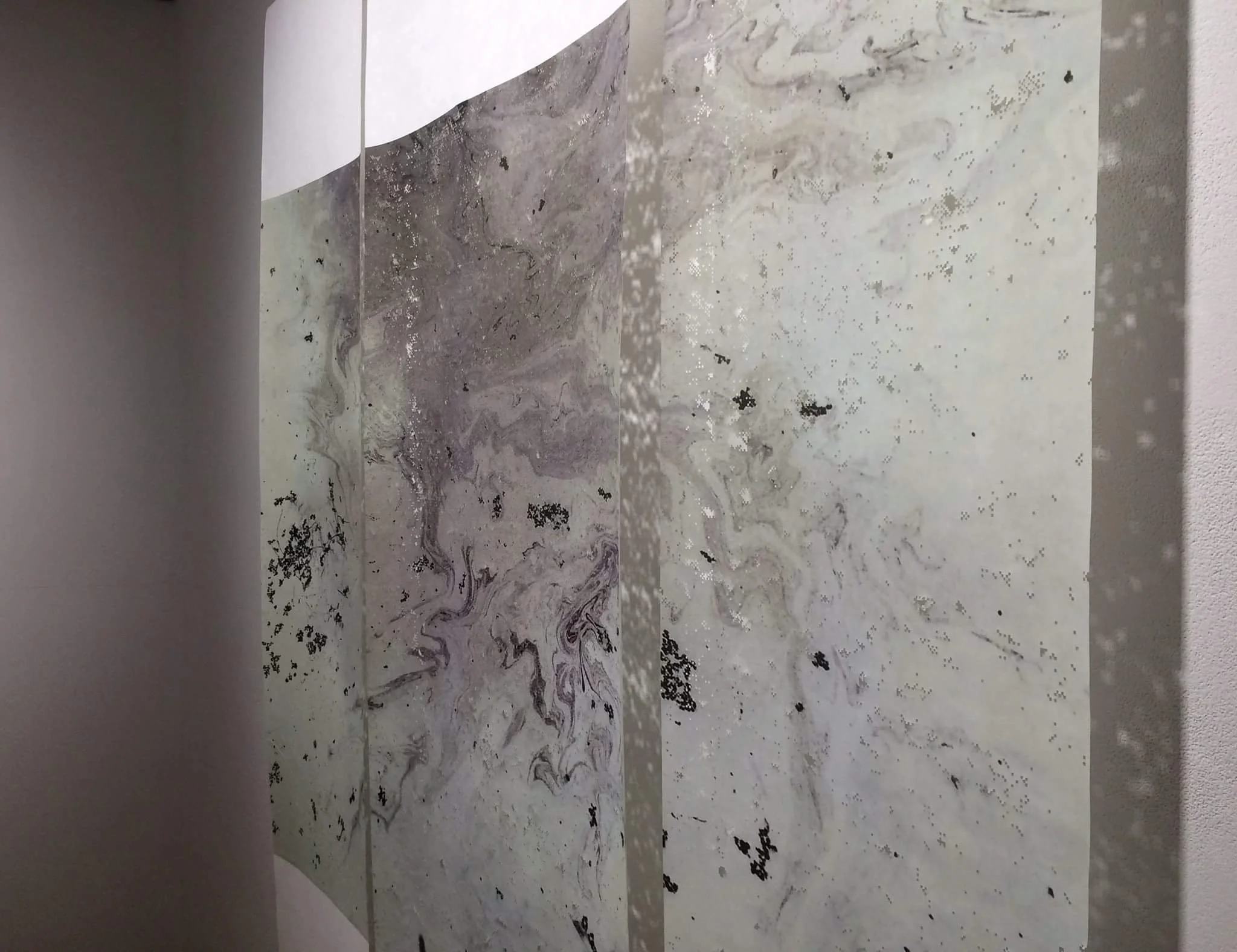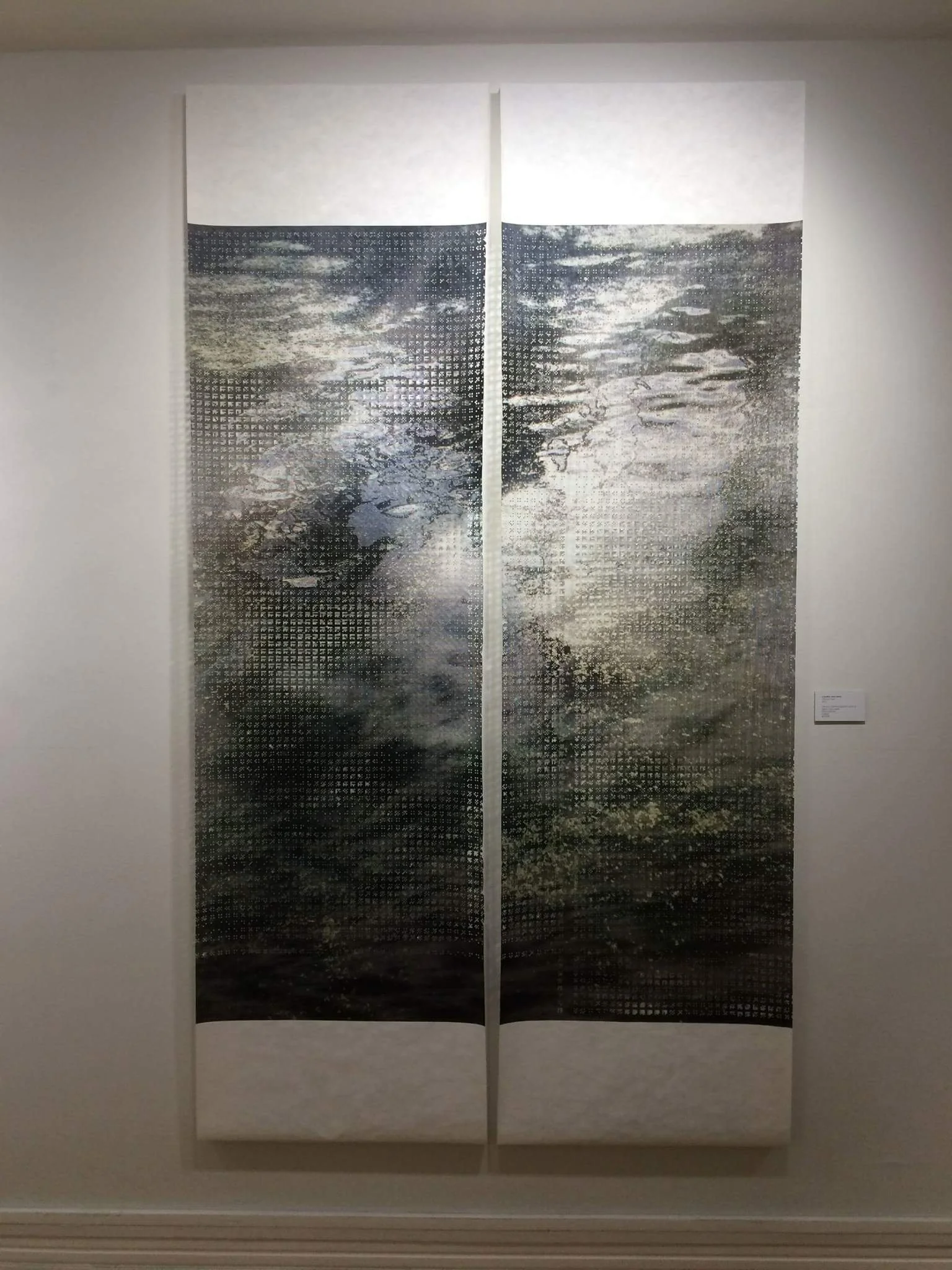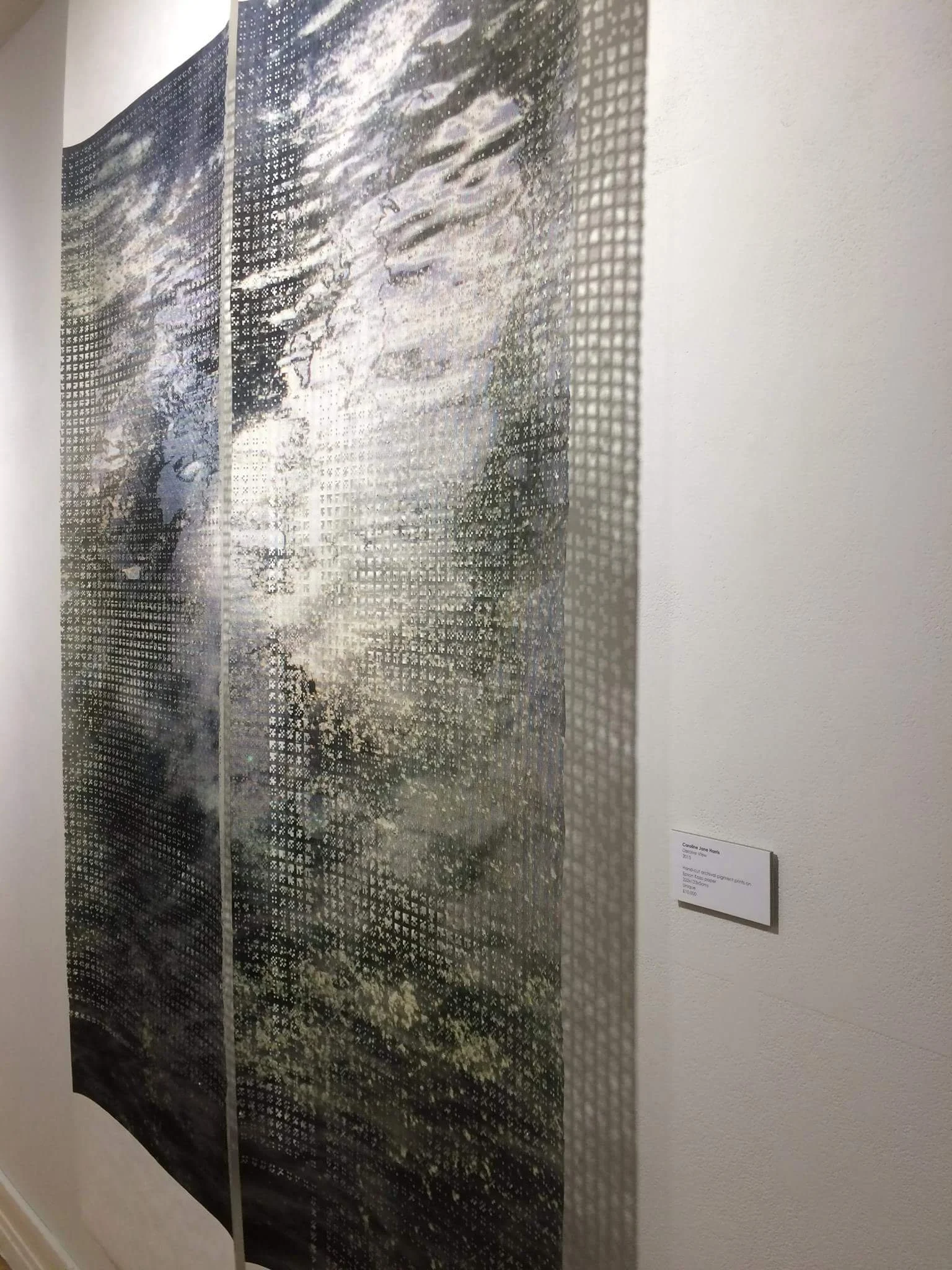In Situ
Neither Nor
Caroline Jane Harris
1st – 9th August 2025
62 Church St. London, UK
Photos by Studio Adamson
The series Neither Nor (2023–25), depicts dynamic tides and horizonless unfurling clouds, reflecting on the infinite universe. The water and waves speak to the essential physical and digital connections of lands through oceans, and people via networks of media. To make this body of work, Harris’ photographs were translated into binary prints then cut from woodgrain-stained papers, which echo the motifs. The residual stencils were used as works in themselves (Time & Change), to make rubbings (Impressions (Rhythm & Motion)) – and photo-etched copper (Hard Copy (Always & Already)), which record the declining matrixes in metal before destroying them completely. In the gallery space, the unframed works delicately enhance materiality. Cloudscapes are suspended overhead and the shorelines on the horizontal planes, responding to atmospheric conditions. At the back of the gallery, a photograph taken from an aeroplane window has been animated and projected onto a paper-cut, signalling the transience of the subject and media.
The artworks in this exhibition express continuous change through ebb and flow, organic and material transformation. Each piece holds a structure and fragility that addresses vulnerable humanity, reminiscent of the interconnected and impermanent nature of existence. Through detail and craftsmanship, the works demand close scrutiny and a slow contemplation, reflecting their making. These works prioritise perception over recognition, highlighting tensions between the tactile and digital, and the human experience in the Information Age.
Nothing More Was Ever Said
Curated by Warbling Collective
14—19 December 2024
19 Greek Street, London, UK
Photos by Studio Adamson and Warbling Collective
In an endless silence after the last words have been spoken and with a gentle nature, a sense of calm is set free. Finally, it has been put to rest and found a new home, although it still exists within the same world as before. Inside those invisible spaces in between, without hearing, seeing or saying, the void quietly suggests it is the end.
Orla Carolin, Eveleigh—Evans, Hugh Frost, Jack Ginno, Kirsty Harris, Caroline Jane Harris, Friedrich Herz, Caitlin Kelly, Sam Llewellyn-Jones, Dustin London, Tom Parker, Marija Rinkevičiūtė, Emma Tod, Asha Vaidyanath, Hannah Waldron, Zoe Wu, Yilina Yang
In Our Own Time
Caroline Jane Harris and Mircea Teleaga
Curated by Jon Sharples and Nick Schammell
7—18 November 2023
OHSH Open, OHSH South, London, UK
As part of OHSH Open, In Our Own Time is a two-person exhibition at OHSH South, organised by Jon Sharples and Nick Scammell, featuring new works by Mircea Teleaga and Caroline Jane Harris, and poems in response by Nick Scammell and Glyn Maxwell.
Both artists engage with the loss, possession and fixity of time and space, as well as the paradoxes of photography’s role as a medium of record. From this common starting point, the artists consider the uses and limitations of reality and its representation, before diverging toward private and personal concerns connected with place and memory. The works on view involve the poetic use of repetition and void to convey the ambiguities of time.
Mircea Teleagă’s painting continually questions the notion of emotional ownership of places and by extension the ownership of memories. The principal influence on Teleagă’s practice is his relationship with the landscape of his native country Romania. Starting with faded industrial spaces and the uncertainty of borders and frontiers, his paintings open a conversation which focuses on intimate, impalpable space. Accepting the transience of these places and the constructed nature of his memories, Teleagă creates numerous ghostly, yet rich, versions of them. Paintings which exist as afterlives that must be worked and reworked. A method which hints at the many alternate versions of our everydays.
Caroline Jane Harris blends traditional and contemporary means of image-making through analogue and digital processes. Working mainly with a scalpel to cut out pixelated images drawn from nature, she makes enquiries into concepts of materiality, digitality and the artist’s hand, exploring our relationship with natural environments in the Information Age. The works function as a contemplative space and meditative experience for both artist and viewer. The fragility of the papercuts is analogous not only to anxiety around the dissolution of physical images in the digital age, but also to the preciousness of our brief experience in this world.
For both artists, a personal encounter with the physical presence of an artwork is paramount. Bringing these two together allows a play of surface, scale and space to resonate with the subjectivity of the viewer.
The exhibition includes poems that take the practices of the two artists as their point of departure: artist, educator and curator Nick Scammell on Mircea Teleaga, and poetry heavyweight, librettist and playwright Glyn Maxwell on Caroline Jane Harris.
this picture in their future.
by Glyn Maxwell
when the time came and they found this
picture in their future
they did not know in time
and they did not know in space.
they did not know in time
because they had no understanding
of why of all the windows
this window was the window
pictured. not the window
from home instead the window
of some one elses home and
someone elses window.
they had no understanding
because what was some one elses
to any one they wondered.
what was someone elses
to any one.
and they did not know in space
because as they came near it
in hope that it was made of
what all of them were made of
it was not made of any thing
they knew of in their future.
for a hand had made the light and
a tool had made the dark and
a hand had made the space and
a tool and time and care had made
everything and made cracks
anomalies and tearing made
light ragged and remembered
and remembered now they stood there
doing what would pass for
crying in their future.
A Physical Manifestation of a Thought Process
Curated by Marco Galvan
18—25 November 2023
Tellus Triannual, 10 Greatorex St. London, UK
Photos by Studio Adamson
Tracing a particular sensibility and material engagement in a diverse range of works, A Physical Manifestation of a Thought Process shows that art, rather than seeking an escape route from reality, offers a much needed space for critical reflection to grapple with the pressing issues of our time. As a vehicle for new creative approaches, the exhibition is a space-time in which various power relations and interests operate.
A Physical Manifestation of a Thought Process is the second show in the Tellus Triannual program, an artist run initiative that focuses on medium experimentation and that considers artworks in their relationship with place, environment and social context.
The artists included in the show draw on the most varied fields of knowledge, and put the knowledge that each one has accumulated into their work. In this way every artist creates a world, becoming a conveyor of a universe of sense, varied and different from subject to subject. The works reflect on themes such as coexistence, presence and care, as well as the sense of place and the layering of time and materialities. Formal investigations border into sculpture, photography and installation.
The artworks comprising the exhibition conflate the raw and the sensuous with the amusing and fantastical, the elusive and illusory with the elemental and intuitive. These works take unlikely form out of unlikely material, at once seductive, vulnerable and playful.
A revelation of complementary approaches, A Physical Manifestation of a Thought Process gathers together even contradictory facets that attest to the complexity of human experience. The title of the exhibition is deliberately inspired by English conceptual artist and winner of the 2005 Turner Prize Simon Starling who described his work as “a physical manifestation of a thought process”, revealing hidden stories and relationships.
In an age anxious to understand what still constitutes authentic experience, the artists in the exhibition remind us that art does not exist outside this world, or what is commonly called reality, but is a vital part of it.
Caroline Jane Harris, Andrew Sunderland, Geo Stuart and Henry Kitcher
The World Was All Before Them
Curated by Clare Gormley
4—20 November 2022
Galway, Ireland
Photos by Ros Kavanagh
Constructed in a moment of global change, upheaval and uncertainty, TULCA 2022 addresses the notion of futurity and asks what the political potentials might be in imagining new futures and envisioning new ways of being in this world.
Taking its title from the final lines of John Milton’s epic poem, Paradise Lost, which recounts Adam and Eve’s journey out of Eden and into a new, unknown world, the festival seeks to take stock of our current moment and imagine what lies ahead, as we too find ourselves on a precipice: of ecological destruction, humanitarian crisis, mass migration, global pandemics, wars and technological over-saturation. Surely, there has never been such an urgent time to challenge the structures of our current existence, and to seek out visions of future worlds worth living in.
Disrupting traditional western, capitalistic, theistic tendencies to imagine the future as either utopian or dystopian, the festival will instead conjure a vision of the future as inextricably tied to the world we live in now: its inequities, as well as its possibilities. As such, it is less invested in depicting the world we might create, than in questioning how it is we might make our existing world a more liveable place.
The intention is to map a more expansive, non-binary, open-ended and fluid conception of what might lie ahead, through an engagement with a form of futurity rooted in a politics of livability, not escapism or mastery.
By-passing and critiquing the notion that technology alone might save us, this edition of TULCA seeks out practices which engage, among other things; civics, alliances, poetics, politics, bodies, dance, movement, language, decoloniality, sociality, connectivity, collectively and the quotidian acts of everyday existence as among the tools of future world-making.
TULCA Festival of Visual Arts is delighted to share the public outcomes and online documentation of its 2022 programme, The World Was All Before Them curated by Clare Gormley.
Contributors to The World Was All Before Them are artists, filmmakers, writers and poets: Anouk Kruithof, Becca Albee, Berte & Harmey, Caroline Jane Harris, Chloe Cooper, Christopher Steenson, Elise Rasmussen, Emily Speed, Esmeralda Conde Ruiz, Judith Dean, Kameelah Janan Rasheed, Michael Hanna, Nicoline van Harskamp, Quentin Lacombe, Tabitha Soren, Tadhg Ó Cuirrín and The Lifeboat.
Light’s Trace
Caroline Jane Harris and Kadie Salmon
4—7 August 2022
APT Gallery, London, UK
Light traces dimensions onto flat surfaces, impressing moving scenes onto paper frames and palpable planes. Photographs stabilise the dynamism of vision into an experience that slows time, enabling us to extend our gaze. In Light’s Trace, Kadie Salmon and Caroline Jane Harris manipulate their photographic equipment’s technical intentions, embracing them as modes of artistic expression that foreground the hand of the maker and undermine representationalism.
Light leaves its impression on medium format film in the works of Salmon, when she reproduces herself as subject in performative states of motion. Using multiple exposure analogue photography, Salmon creates site-specific, visual paradoxes of intimate self-encounters, evoking romanticism, sexuality and desire. Harris’ appropriation of transparent 100-year-old photographic slides featuring sublime scenes of nature, explore a personal impression beyond the chemical and semiotic medium. The palm-sized portable windows onto the world used in her work are both image and object, historic yet contemporaneous with any view they frame. Both Salmon and Harris encapsulate their expanded photographic handling of materials, by drawing attention to the attributes of media, through sculpting, hand-colouring and cutting-out with a scalpel.
Salmon’s poetic photographs and moving images, produced exclusively using stills and in- camera methods, feature fantastical scenes of moment-by-moment locomotion that could be attributed to digital manipulation, yet are arresting in the revelation of their mechanical means of production (Moon Bathing, 2019). Her hand-coloured analogue photographs harken back to early 20th century cinema and directors like the Lumiere Brothers; referencing not only the transformative quality of applied colour, but significantly the history of gendered labour and the strictly female workforce employed as colourists. These processes explore the manipulative nature of the image itself and its conflicting roles in both depicting truth and presenting fantasies or ideals.
The artist's hand also prevails in Harris’ practice, through her meticulous workmanship made in a meditative state to serve peace in defiance of our modern pace. Layered digital prints cut-out in pixels demand an investigative gaze that reveals the process of manual making (Crashing Waves I & II, 2019). Through recursive processes such as placing slides on her own pictures of the same subject matter and re-photographing, printing and cutting them, disparate timescales and locations are flattened and expanded into multi-dimensional artworks that examine the temporality of our existence (A Continuum, 2022). Other techniques include photoetching into zinc where the imperfection of hand-cut marks are emphasised in shallow furrows (Hard Copy (Crashing Waves) I&II, 2019), occupying a space between print and indexical trace, two- and three-dimensions. In Luminous Fall (2022), a suspended delicate paper-cut intercepts an overhead projection onto a wall, temporarily recording a weightless image through a pixelated matrix in dual locations. The image’s material and dimensional stability is deconstructed, creating drawings in space with the intangible qualities of light, shadow and movement.
This transition between the two-dimensional and three-dimensional image is extended further in Salmon’s tactile and fragile sculptures. In Serrat (Salt Scree) (2022) the two-dimensional photograph becomes a sculptural material that draws attention to its material weight, scale and texture. Here, a small handmade model of a mountain has been photographed, hand-coloured, re-photographed and printed at large scale. The paper mountain sits crumpled, propped up and balancing on a debris of clay and photographic scree. The majestic strength and power associated with the summit of a mountain soon becomes exposed in her work as an illusion through the delicacy of the photograph in its three-dimensional state, reminding us that all images contain fragile truths.
In this exhibition the artists ‘trace’ is explored as both tool and subject matter through manifestations of light. Via innovations of idiosyncratic photographic techniques, traces of the artist's physical engagement and manipulation of mediums are left as evidence on the surfaces and contours of pictures and sculptures. The ‘back-end’ production of analogue and digital images is brought to the forefront of vision through translation, simulacrum and pixelation, breaking illusions of representation. In reference to photographic positive and negative film, the gallery is divided into light and dark, moving the viewer between spaces where contrasts collapse scale, time and place into the present viewing moment.
Through their chosen manual approaches, an aura of the sublime is imbued in the works – from the beauty of both subject and haptic detail – to the apprehension of these laboured surfaces whose mainstream digital counterparts are fast supplanting the traditional techniques championed by both artists.
Kadie Salmon and Caroline Jane Harris met whilst artists in residence at the Florence Trust, London 2016–17. They both live and work in London.
A Stopped World
Solo exhibition by Caroline Jane Harris
31st October — 19th November 2020
Kristin Hjellegjerde Gallery, Berlin, Germany
A vast textured sky, bruised blue, purple and pink, with billowing clouds of smoke simultaneously evokes a sense of stillness and motion, fragility and power. Turning her eye once again to reproductions of nature’s expanse, British artist Caroline Jane Harris’ new body of work explores the making and manifestation of imagery in the digital age. Combining subjects captured from books and internet videos with her signature process of cutting-out digital prints by hand, Harris creates visually complex and arresting works that re-examine the tactility and dimensionality of images. A Stopped World, her solo exhibition at Kristin Hjellegjerde Gallery Berlin, offers a meticulous examination of our engagement with technology, habits of perception, and experience of time and space.
In Harris’ work subject-matters aren’t preconceived. Instead, the artist collects images that she’s drawn to from various sources, which are detached from their original contexts and later, imbued with new meaning through her layered creative process. For this body of work, the artist photographed aerial photographs in found books, bestowing a lack of definition and veracity to the original source. She also took screen-captures of internet videos, a process which she likens to ‘the analogue technique of a cameraless photograph’, deliberately embracing the poor quality that is often the by-product of the digital realm. The artist then used a scalpel to cut into the printed images by hand, drawing on the software function of a ‘bitmap’ image to create artworks that investigate the mechanics of seeing in a digital world.
The process of making ‘images of images’ is central to the artist’s practice and relates to the contemporary condition of our culture in which media no longer simply relays information but stands as a substitute for the real. The large-scale artwork entitled A Stopped World, which sits as one of the exhibition’s centrepiece, is composed of a series of sixteen screenshots captured from an online video of a volcanic eruption. Viewed from a distance the image offers an experience of motion and time suspended in which our gaze adjusts to perceive an overwhelming sense of beauty and wholeness that reflects on historic artistic representations of nature and the sublime. However, as we step closer, the irregular hand-cut pixels reveal themselves, breaking apart the surface and complicating our perception.
A second enveloping work In Bloom features the same sixteen tiled cut-outs, this time cut from a delicate, natural coloured Japanese Kozo paper and installed unframed. In this work, a single eruption precariously floats off the wall, creating tension between the brutal power of the subject matter and the palpable fragility of the artistic material. Again, this recalls the Romantic tradition in which the frailty and transience of human existence is underlined in the context of nature’s timelessness. Though here, Harris is not so much reflecting on nature, but questions the permanence and vulnerability of images themselves.
As with all of her works, the artist leaves the “detritus of the process” visible where paper becomes removed to the extent that it falls away, subtly acknowledging the implications of a bodily engagement with analogue media. As the title of the exhibition suggests, these are artworks that demand slow, meditative contemplation. Though complex in their making, the images allow for an experience that is not only visual, but also felt.
A Three-Dimensional Sky
Solo exhibition by Caroline Jane Harris
28th March — 11th May 2019
Kristin Hjellegjerde Gallery, London, UK
British artist Caroline Jane Harris has developed a diverse practice that investigates the relationship between image-making, subject and object. She extends traditional methods of photography, printmaking and drawing, as well as digital technologies to create meticulous hybrid artworks that traverse time, dimension and materiality. Central to each artwork, is an image that has been precisely cut-out by hand, embedding the artist’s time and attention in each iteration of her evolving applied processes. Harris typically begins her work by gathering digital photographs taken as a response to an environment, then analyses her images in relation to their history and production. For the first time for her solo show ‘A Three Dimensional Sky’ at Kristen Hjellegjerde gallery, London, she has sourced analogue photographs in the form of century-old magic lantern slides and combined them with her own recent pictures, to flatten time, space and place into an array of multi-dimensional tactile artworks.
Harris began this body of work by collecting historic slides featuring vast natural subjects that project outwards in defiance of their portable scale. She was drawn to these glass positives because “they’re both image and object, historic technologies yet timeless subjects and are like portable windows onto the world”. With the passage of time these slides have become detached from their original contexts, and gain the softness and patina of an indistinguishable past. Harris mirrors these attributes through extensively layering and re-photographing these image-objects to create pictures that starkly contrast against the exacting spaces cut-through or layered on top of these prints. Within the exhibition we are presented with various age-toned digital prints of dynamic seas, still mountains and expansive vistas.
The artworks Crashing Waves I, II & III, manifest multiple layers of time: the moments the photographs were taken, the age of the slides, and the accumulation of hours spent cutting the prints. Harris’ manipulation of the images that causes a visual degradation of clarity, combined with the cut-out spaces serves to expose rather than hide the underlying structures of the images’ making. ‘As the sky has no surface and is intangible, the sea has no colour itself, it only reflects what’s above or below; like the digital image is only a representation of a coded language,’ comments Harris. The final pieces present a multiplicity of perspectives within one frame, taking the viewer through the systems of horizontal and vertical planes, denying the virtual depth of the image by contrast to the real depths in space.
As Harris uses one work to generate the next, she employed her guide-stencils from the ‘Crashing Waves’ series in conjunction with the hybrid printmaking process of photo-etching to make ‘Hard Copy (Crashing Waves I, II & III)’, capturing the negative cut-space in zinc. These pieces are neither print, photograph, nor drawing, but occupy a space between two and three dimensions.
The sense of elusiveness that permeates Harris’ work can offer a commentary on our contemporary digital world. As the viewer approaches these artworks, the whole becomes increasingly fractured and distant until it is entirely dissolved, just as the selected images we are fed by the media, such as in the case of natural disasters, inevitably show us a small part of the full picture therefore manipulating our understanding of that particular narrative. Moreover, the dissolve between figuration and abstraction acts as a reminder of our inability to ever fully view an expanse such as the sea, whilst we might stand on the shores and know that this enormous body of water connects land around the globe, we can only ever glimpse a snapshot of it.
Demonstrating an alternative use of layering in both pre- and post-production, A Distant Presence presents us with a diptych of hand-cut digital prints against a white background. This artwork features a single photograph with dual perspectives; a bisection that mimics the horizon line within the image itself and the distant waves interlaced with a foam that suggests both the substance and departure of the sea, mimicked in the absence of the cut-out spaces.
Despite the timelessness of the subject matter, Harris’ repurposing of photographs and processes invites us to consider the temporality and fragility of contemporary images. Whilst the breakable yet
solid slides have lasted, even improved with time, digital imagery is at risk of vanishing without leaving a mark as we continually update new medias and software. This is perhaps reflected most evidently where Harris has photographed slides of mountains over a layer of tissue and re-printed these as the background layer. Veiling the prints is an ultra-thin translucent cut-out tissue paper that is traditionally used to clean camera lenses. Whilst the tissue conventionally improves visual clarity, here it softens, creating a veil of fog in front and behind the mountain. We find ourselves in a scenario where the reproducible digital print may outlast its digital counterpart, shifting importance to historical modes of production. Just as the ocean unifies different shores in time and space, Harris’ works compress past and present into one experience.
Piecemeals
Caroline Jane Harris, Anastasia Mina and Elena Gileva
20—23 June 2019
London, UK
The Metallurgical Ouroboros
Curated by Samuel Capps
21st September — 21st October 2018
Gossamer Fog, London, UK
The Ouroboros is a symbol that can be found across ancient culture, depicting either a snake or dragon consuming its own tail. It represents the continuous circle of life and the eternal emancipation of living networks and ecosystems; with the dragon being the most primordial symbol representing the class of all predators, mastering fire [destruction] and hording gold [wealth]. The qualities of the animal kingdom have long inspired the design of materials and machines through bio-mimetics, as the materiality of technology is bio/geo-logical and nature is fully intertwined in processes of both its production and consumption. The nature of transmutation sees the technological artifact becoming the philosopher’s stone - the archetypal symbol of alchemy - turning base metals and minerals into a new gold.
This technological alchemy, or technomancy, drives modern consumerism and weaves the Earth’s materiality with production, with 80% of the energy used in a computer’s lifespan is during the production phase. Microprocessors can also contain over 60 chemicals and minerals, which is only one component of 100s in devices such as mobile phones or computers. These are purely geological entities that stretch over timescales represented by both the future and the past while in your hand of the present. This process has created an (un)natural Ouroboros created by entangled copper network cables, a modern day life cycle to be melted down in the cultural foundry.
The foundry of techno-culture melts everything together to produce new alloys, a position that Deleuze and Guattari take through the idea of the metallurgical in A Thousand Plateaus. These metals have had a powerful position in the history of humanity through industry and technics which then transcends their existence across organic and inorganic planes. They argue that matter itself is not necessarily inert and that metals provide "the consciousness of matter-flow" or that "the non-organic life is the intuition of metallurgy". This becomes a new materialist argument designed to decenter anthropocentric thought and to open it up to the perspective of the nonhuman within the assimilation of technology and the natural world.
As the globalist economic ecosystem spreads right across the planet, the collateral damage from the loss of a big tech hardware company on the western stock markets tumbles down to the processor makers in Asia, then onto to the rare earth miners in parts of the Third World. The mine is the discovery point of the technological artifact and the corporate ground zero where human labour meets geological earth in a pit of filthy extortion. This extraction of geo-monetary value is mirrored in the new wave of cryptocurrency ‘mining’, with Bitcoin alone using more electricity than a country such as Ireland. Even in places of the world that do not adhere to such a capitalist agenda, its tentacles will be spreading nearby. It spreads to the ancient jungle tribe in the rainforest encroached upon by illegal loggers or the Inuit family living in remote regions of the arctic circle, watching pack ice melt faster than any of their ancestors have ever seen before.
The tentacles spread via growth systems that both capital and ecology share; the natural world loathes a vacuum and will immediately fill it with new life and the filling of this vacuum can easily be related to how Capital operates when always looking for the fabled ‘gap in the market’. Although the analogy to the natural world could obviously pertain to Capital being parasitic, the delicate symbiosis shares more with the biological commensalistic relationships, where one party takes more effect than the other. Nature is so effected by this relationship that some have deemed it the Capitalocene but it is now the only natural order of things we know.
Caroline Jane Harris, Victor Seaward, Stephen Cornford, Samantha Lee, Rustan Soderling
A Bright Haunting
Solo exhibition by Caroline Jane Harris
ASC Exhibition Award selected by Paul Carey-Kent
23rd June — 3rd August 2018
ASC Gallery, London, UK
In August 2017 Caroline Jane Harris was selected by curator and writer Paul Carey Kent for the second ASC Studios Summer Open Exhibition and was awarded a solo show at ASC Gallery in June 2018. A Bright Haunting features works made from 2017 -18 that continue and extend Harris' exploration of the expanded photographic medium and image-making process, in dialogue with printmaking and drawing. The artist posits photographic theories and concepts in relation to the medium's history and current possibilities, layering an interplay between analogue and digital processes, traversing 2 and 3 dimensions. The exhibition features hand-cut digital prints, rubbings and etched-copper plates made from the paper-cut stencils.
To coincide with the exhibition, Dr Jon K. Shaw has written a text entitled Bright Hauntings in relation to Caroline's on-going practice. Jon was Caroline's dissertation tutor during her Masters at City & Guilds of London Art School and their continuous dialogue has influenced and shaped her work. 'Bright Hauntings' is available to read here
SELECT/16
At the Moment of Being Seen
4th November — 1st December 2016
Photofusion, London, UK
The four exhibiting artists were selected from SALON/15 to exhibit their full body of work in Photofusion's SELECT/16 exhibition. Andrew Youngson, Emma Evelyn Speight, Caroline Jane Harris and Andrew Meredith have each been awarded a bursary and professional mentoring to develop and exhibit this work. The four projects were individually championed by Photofusion's staff and members of our board.

